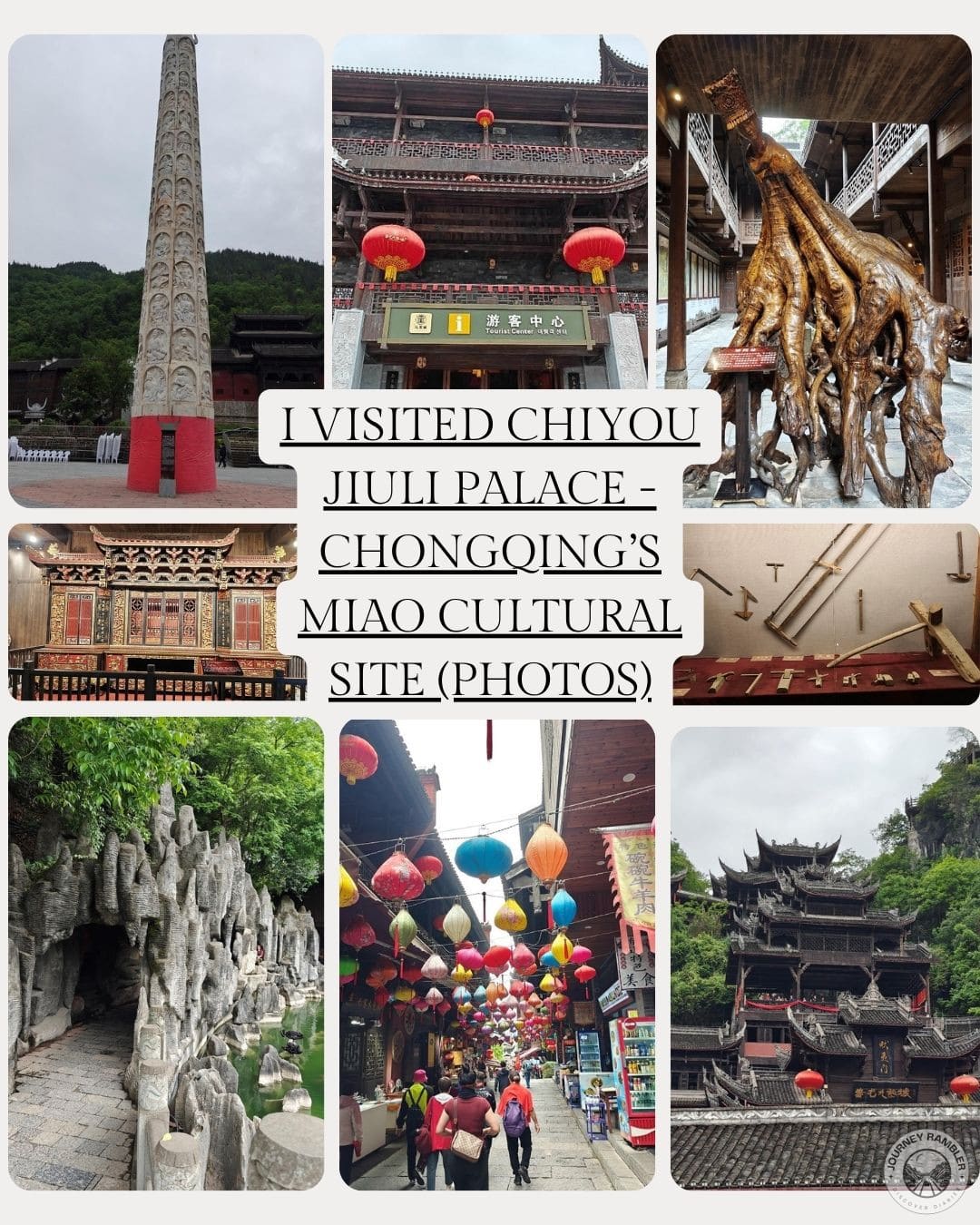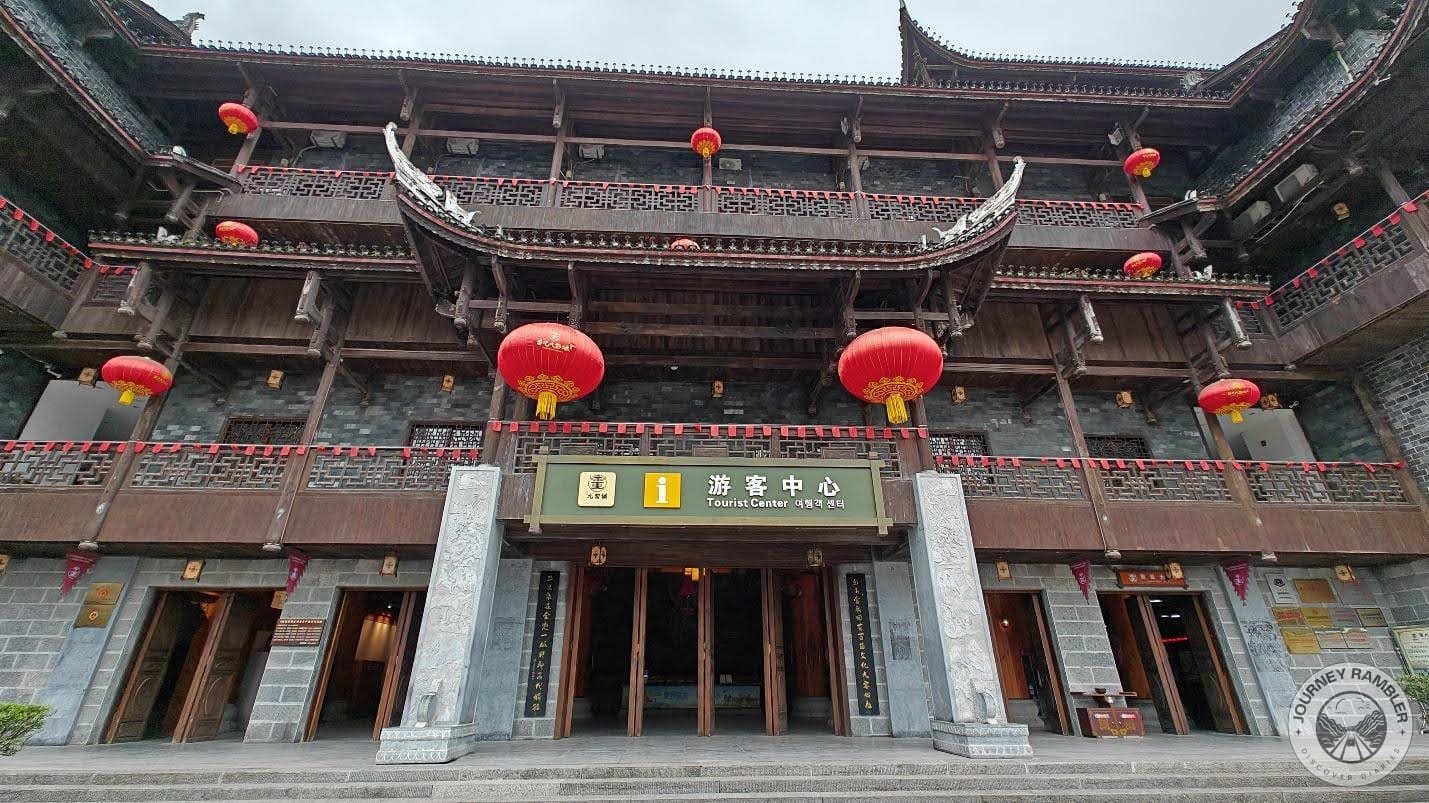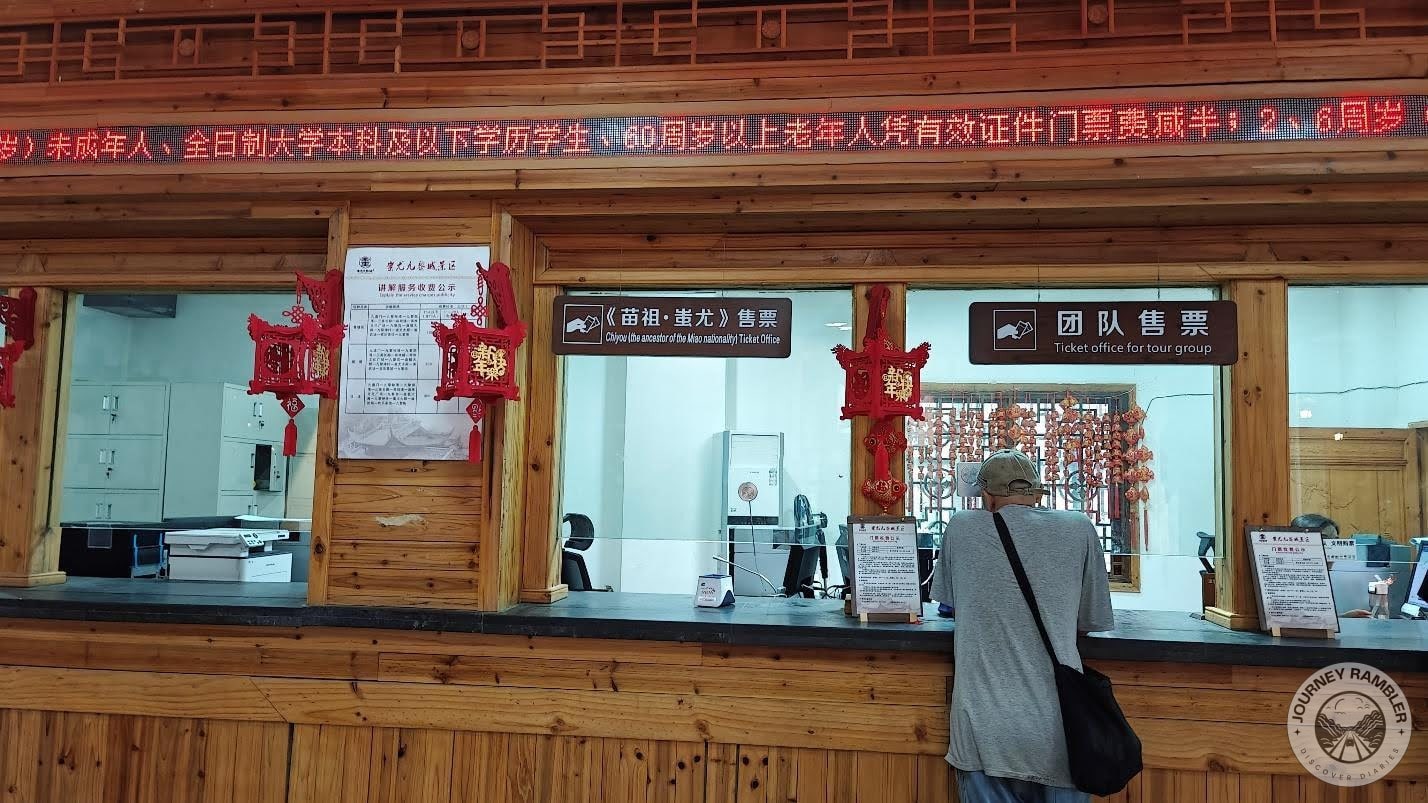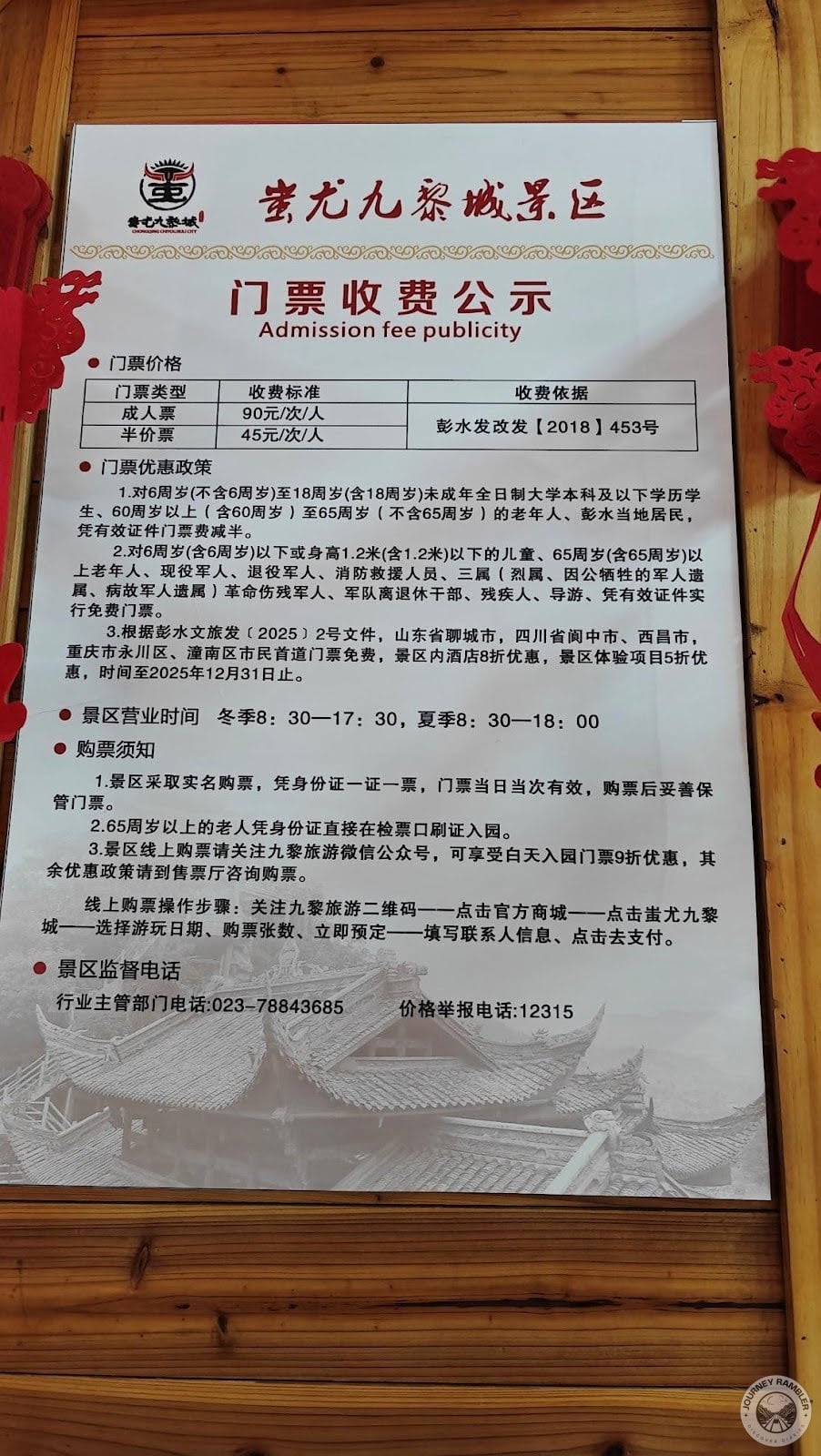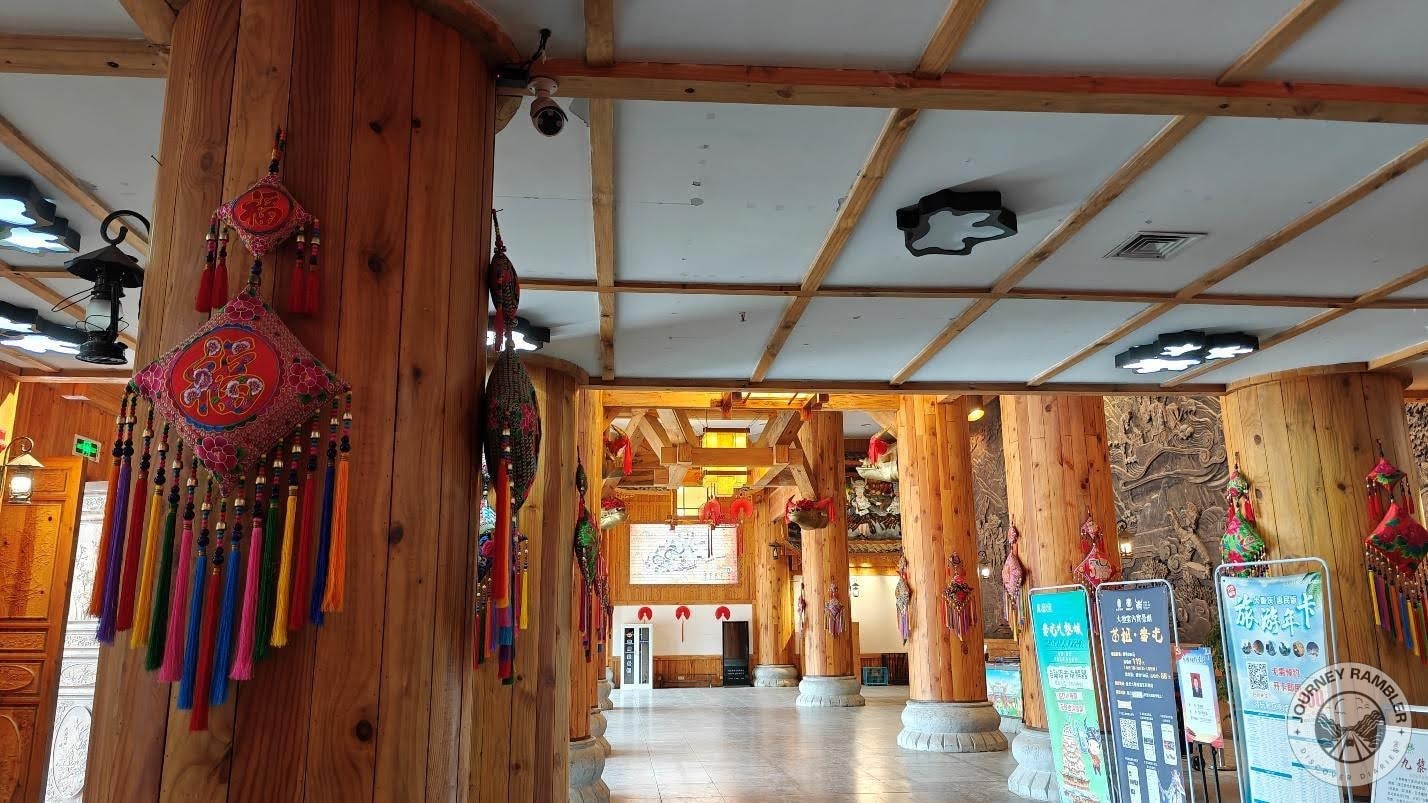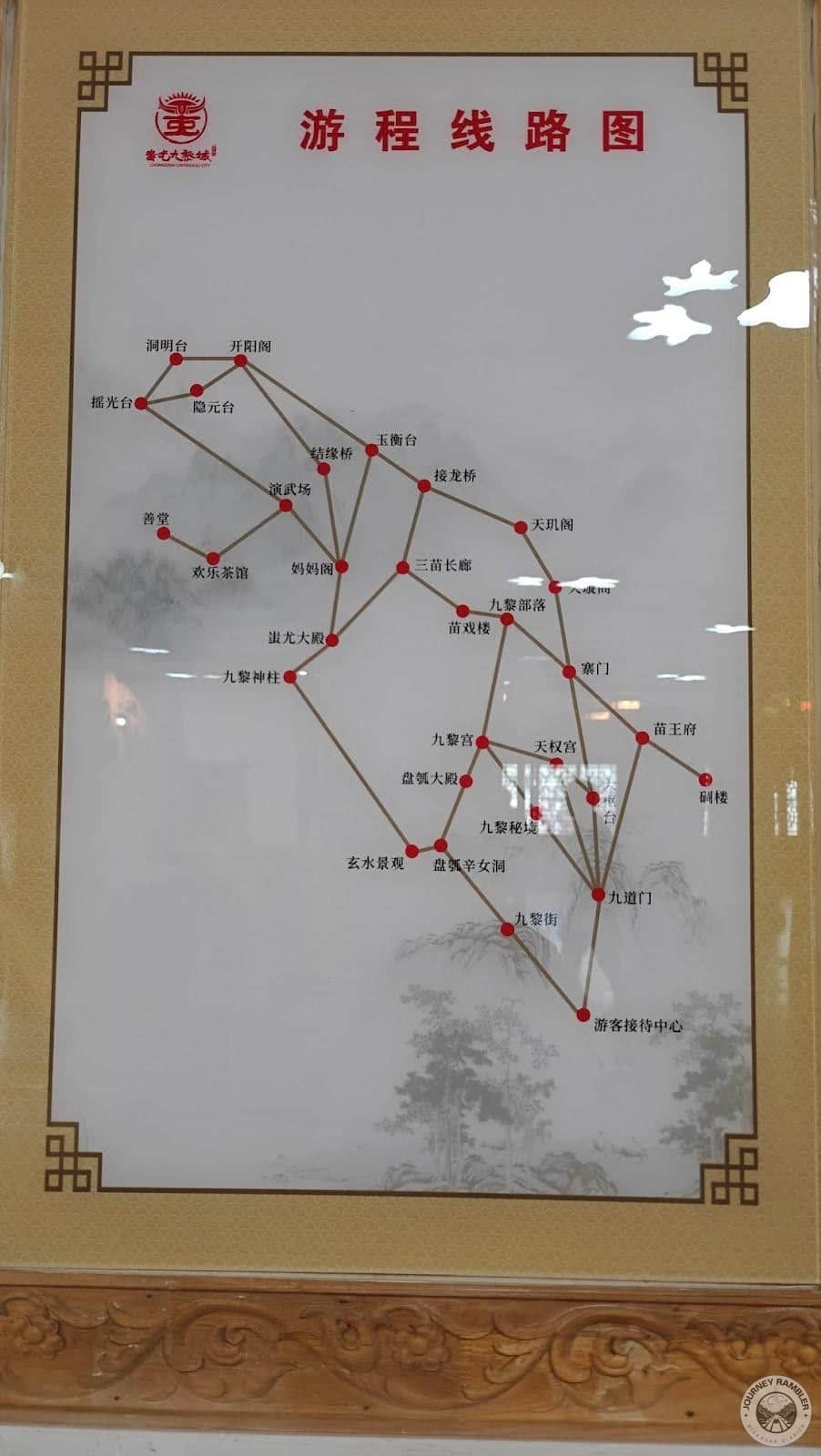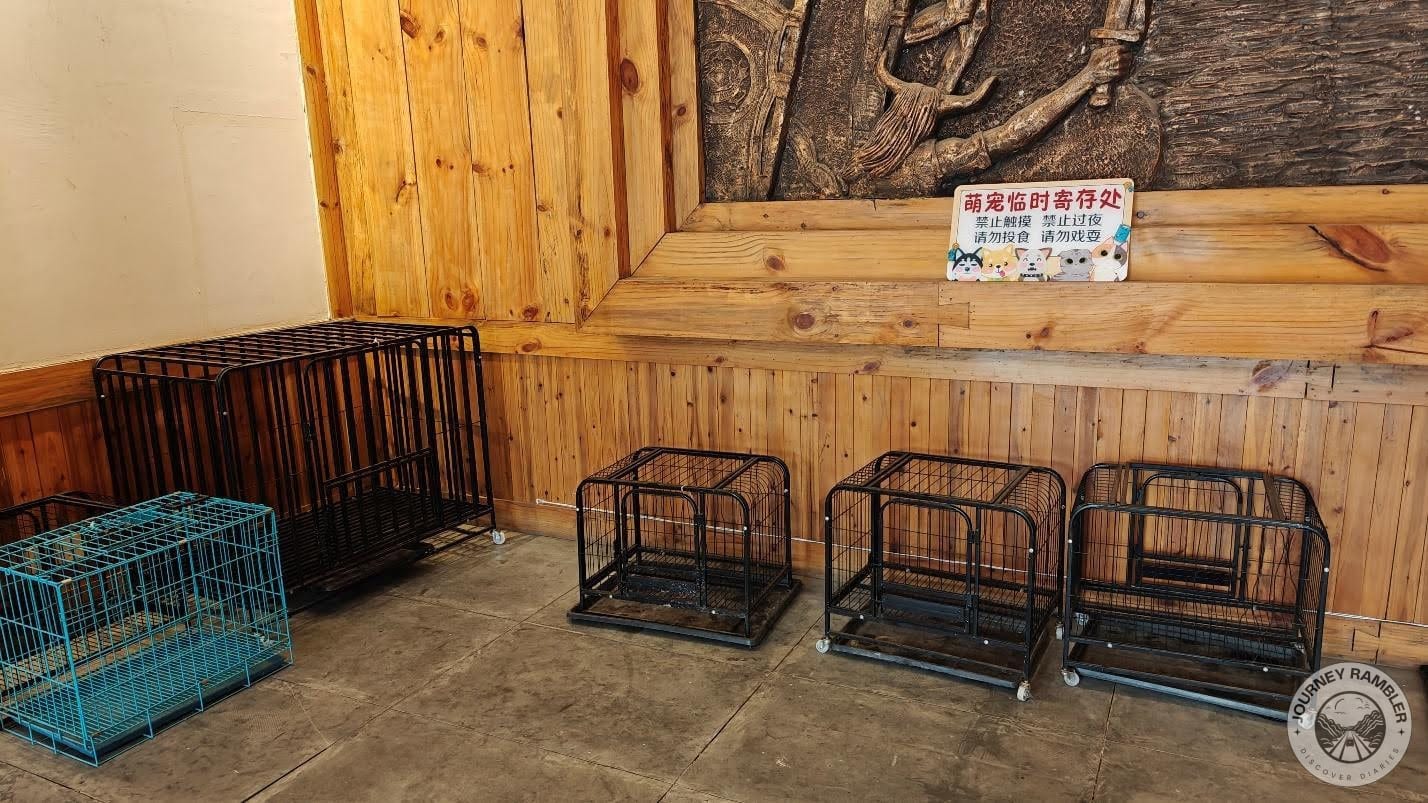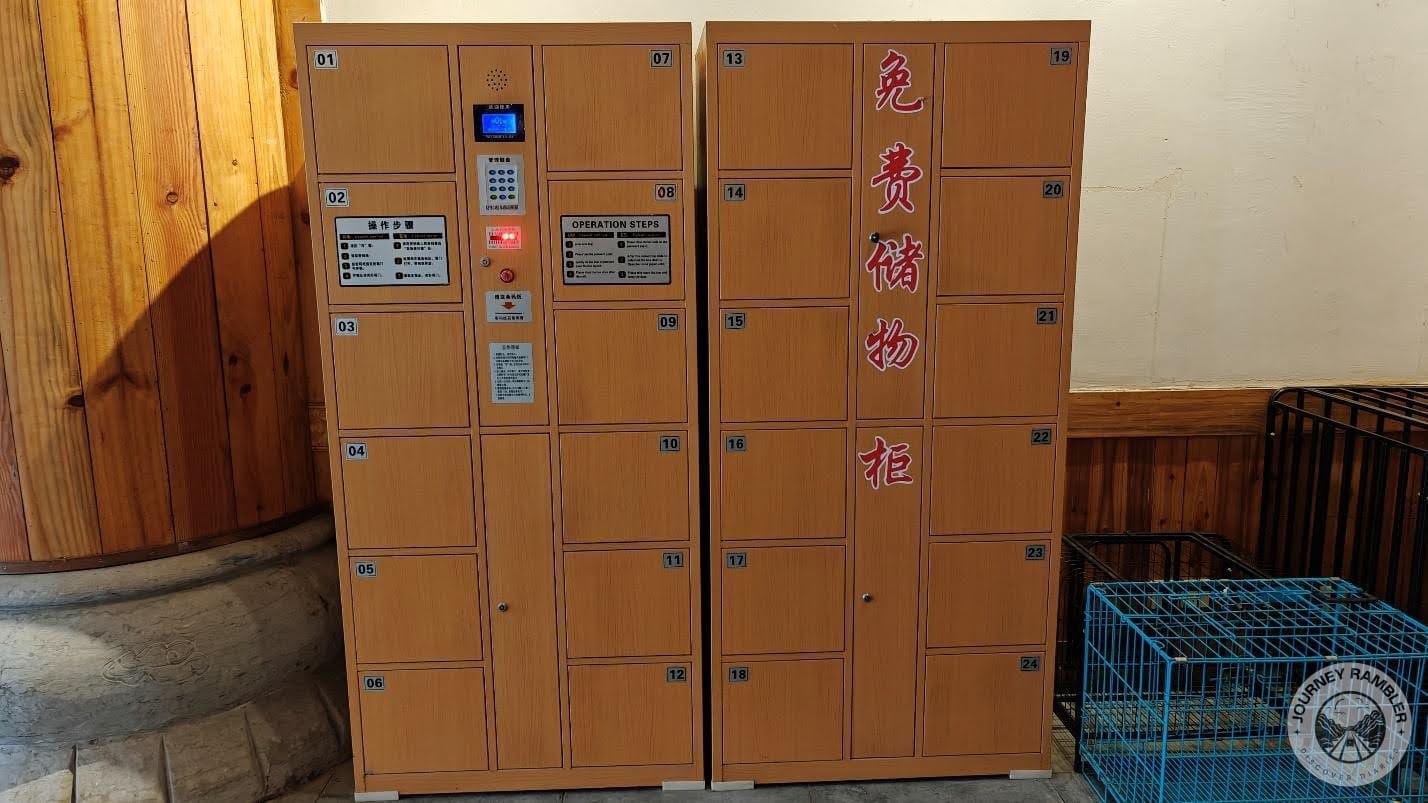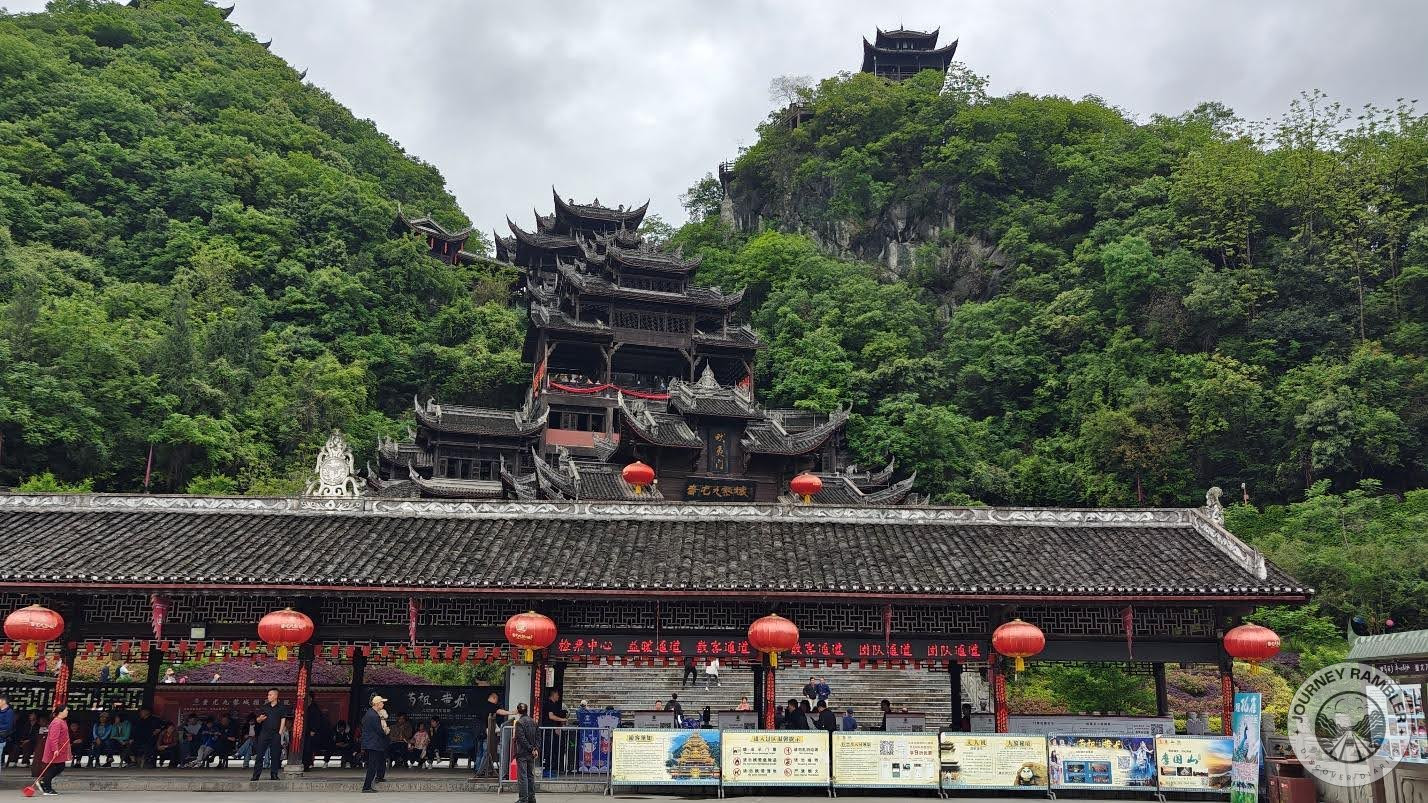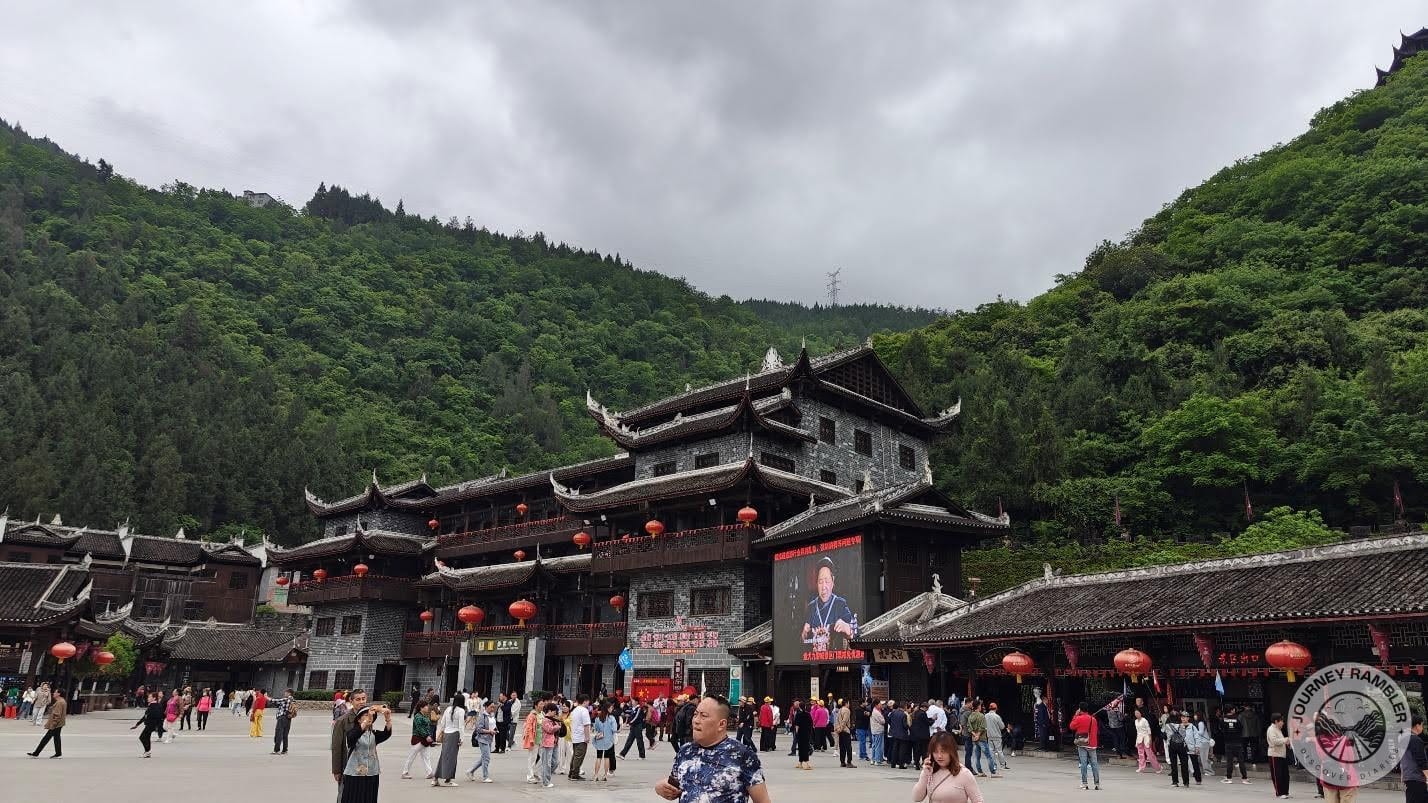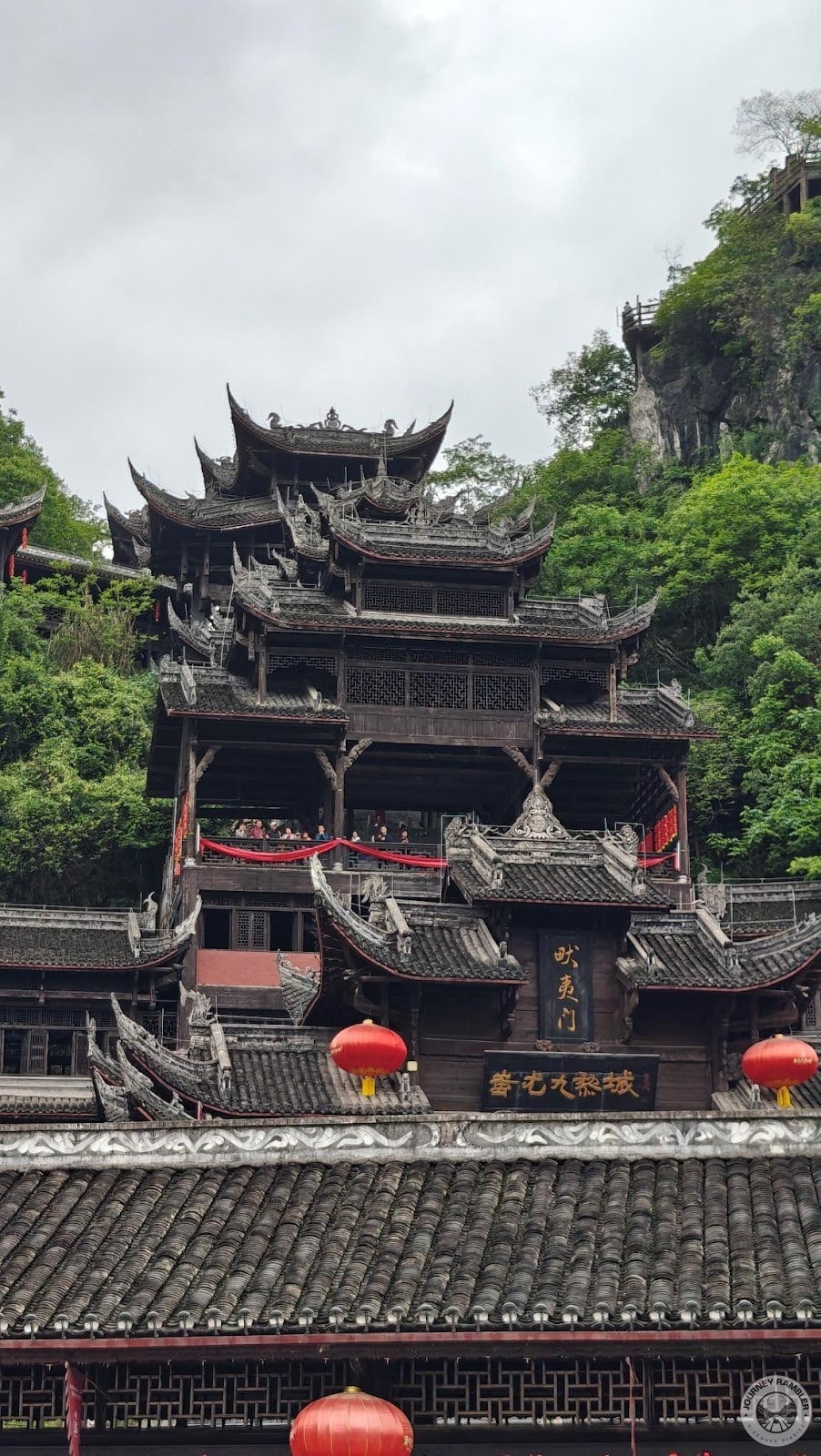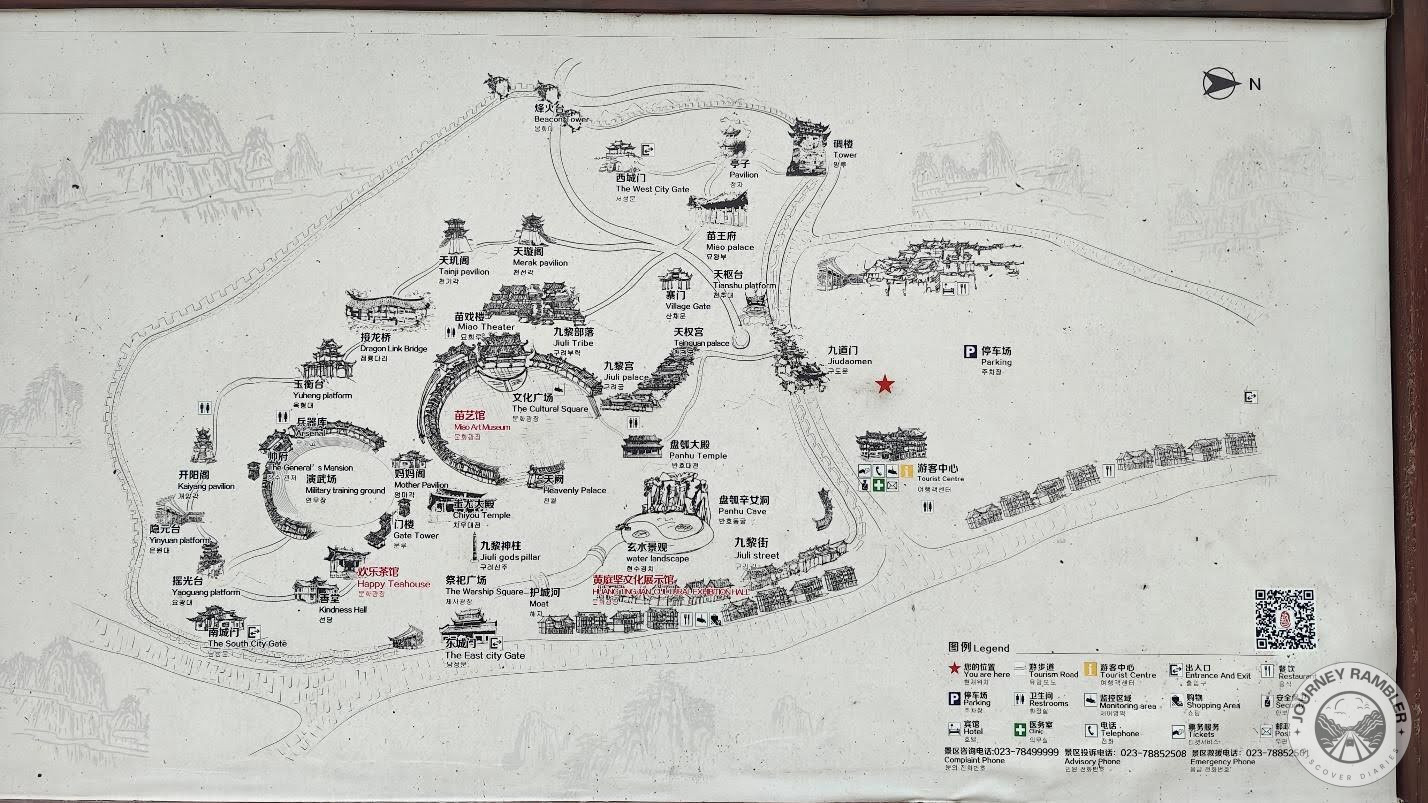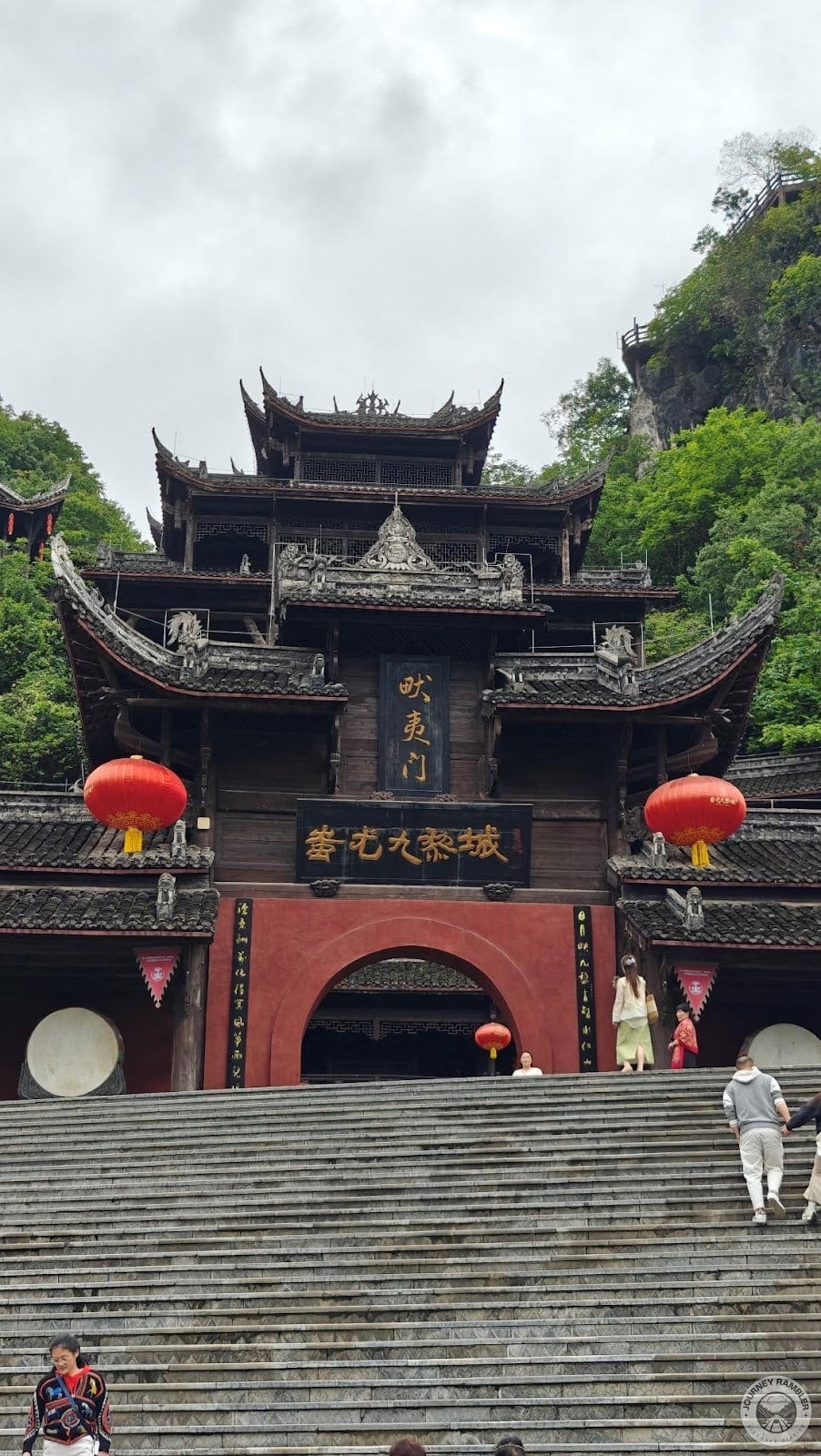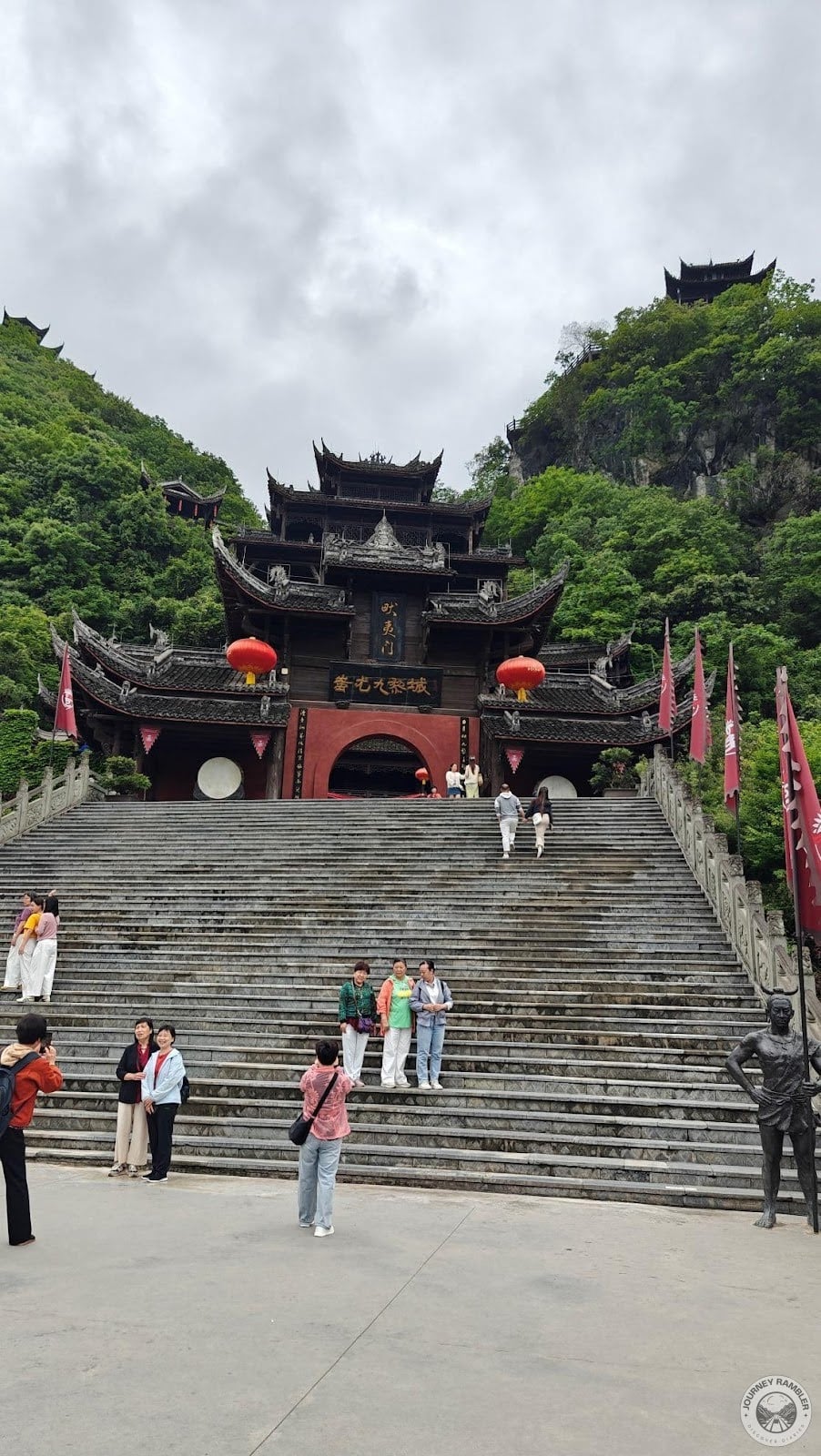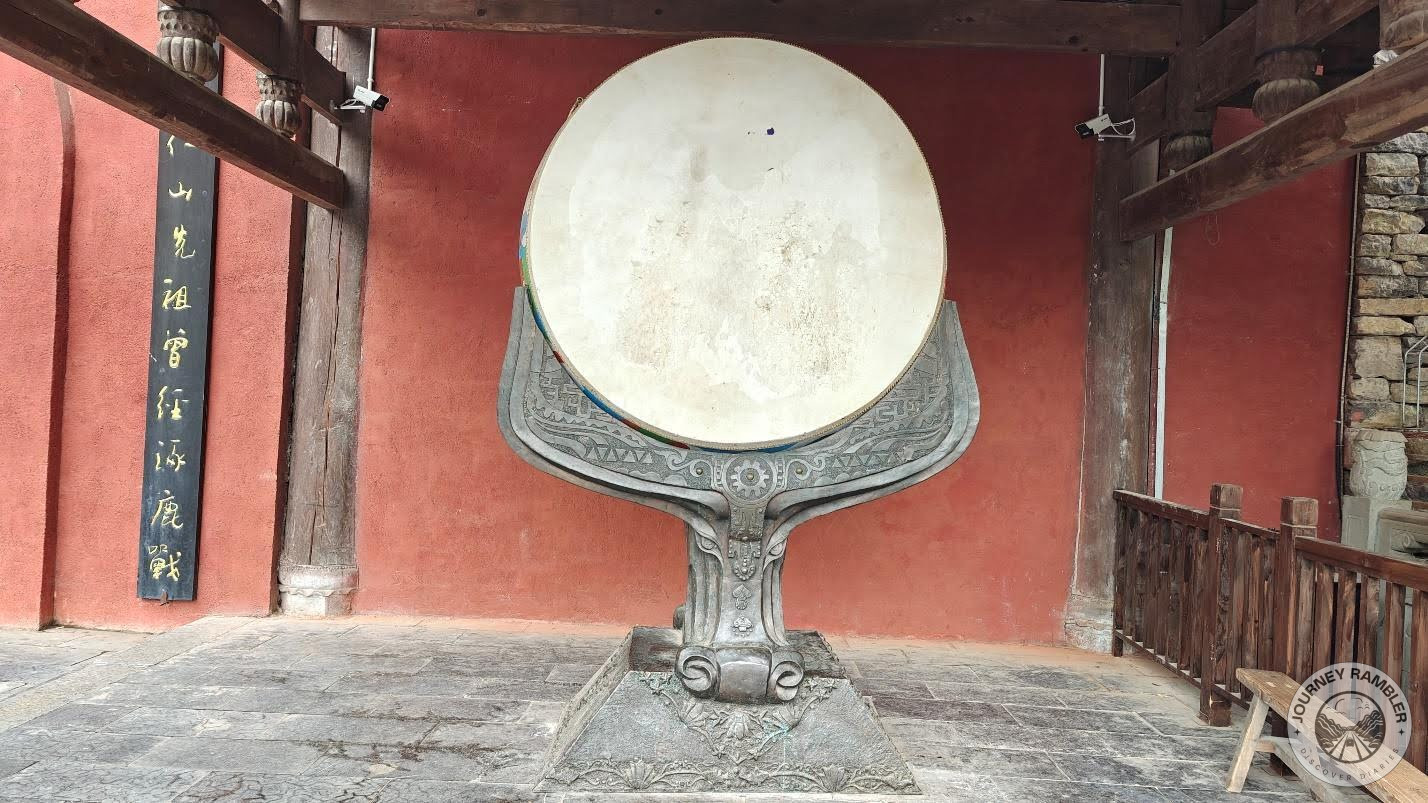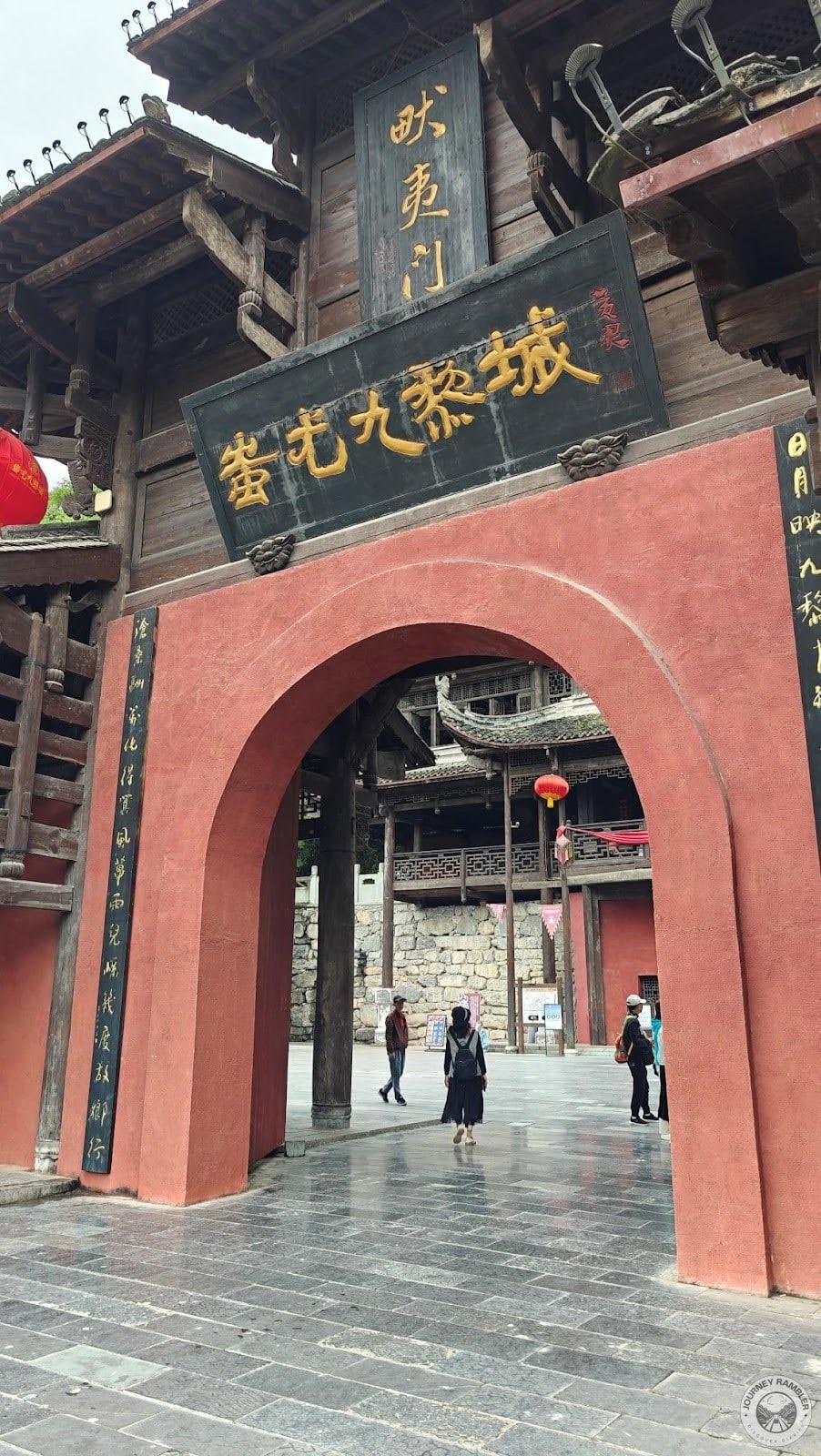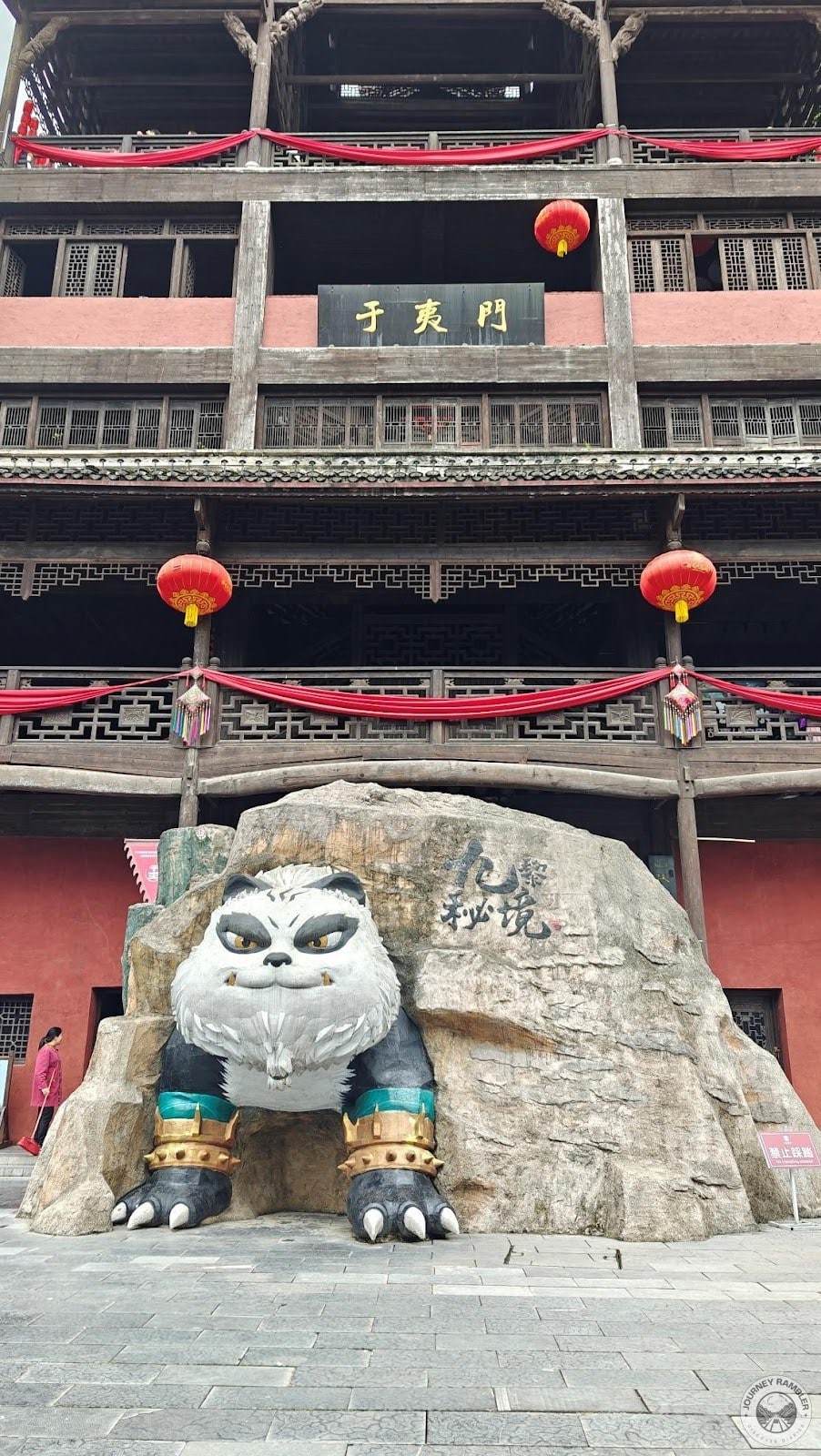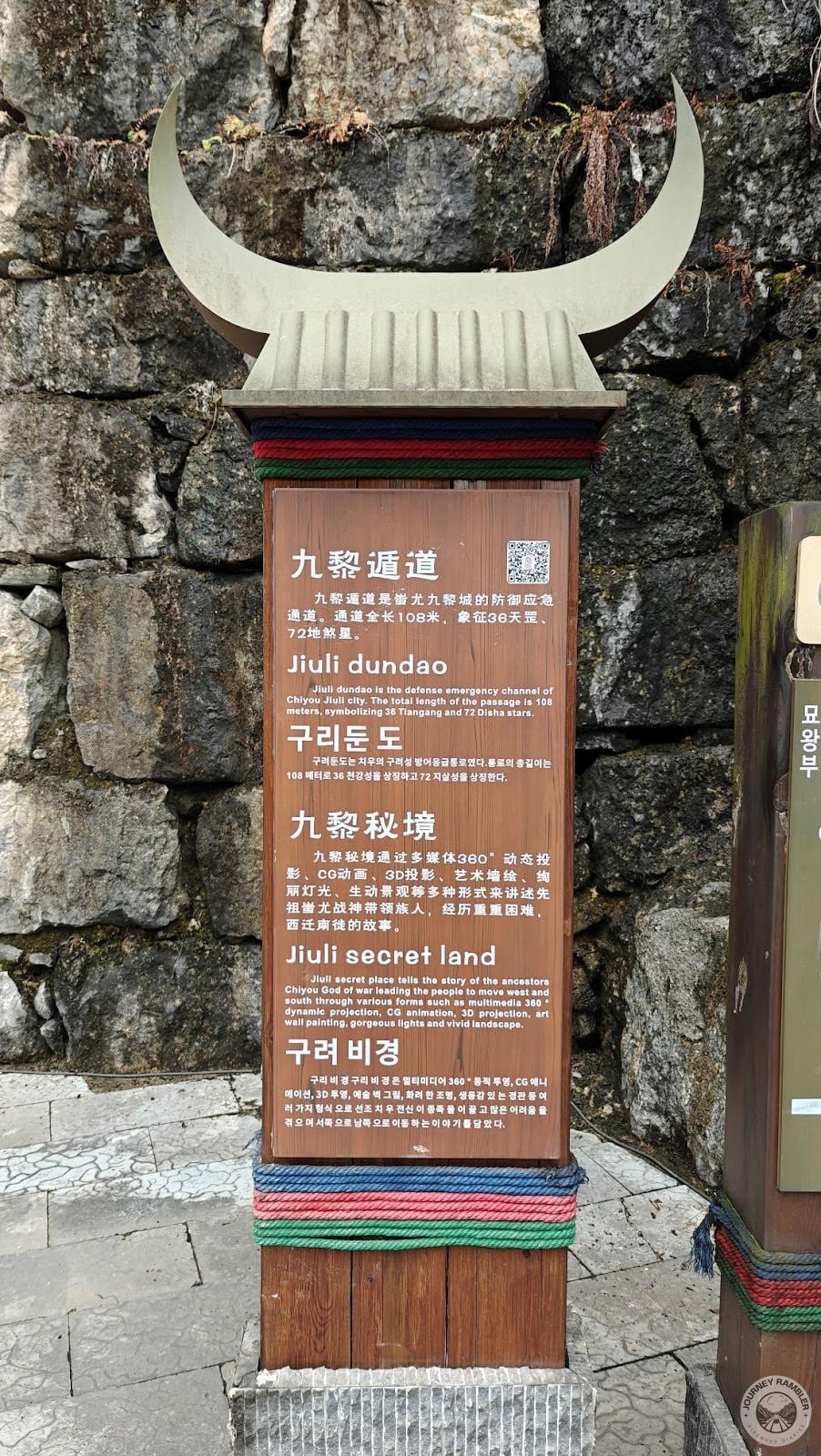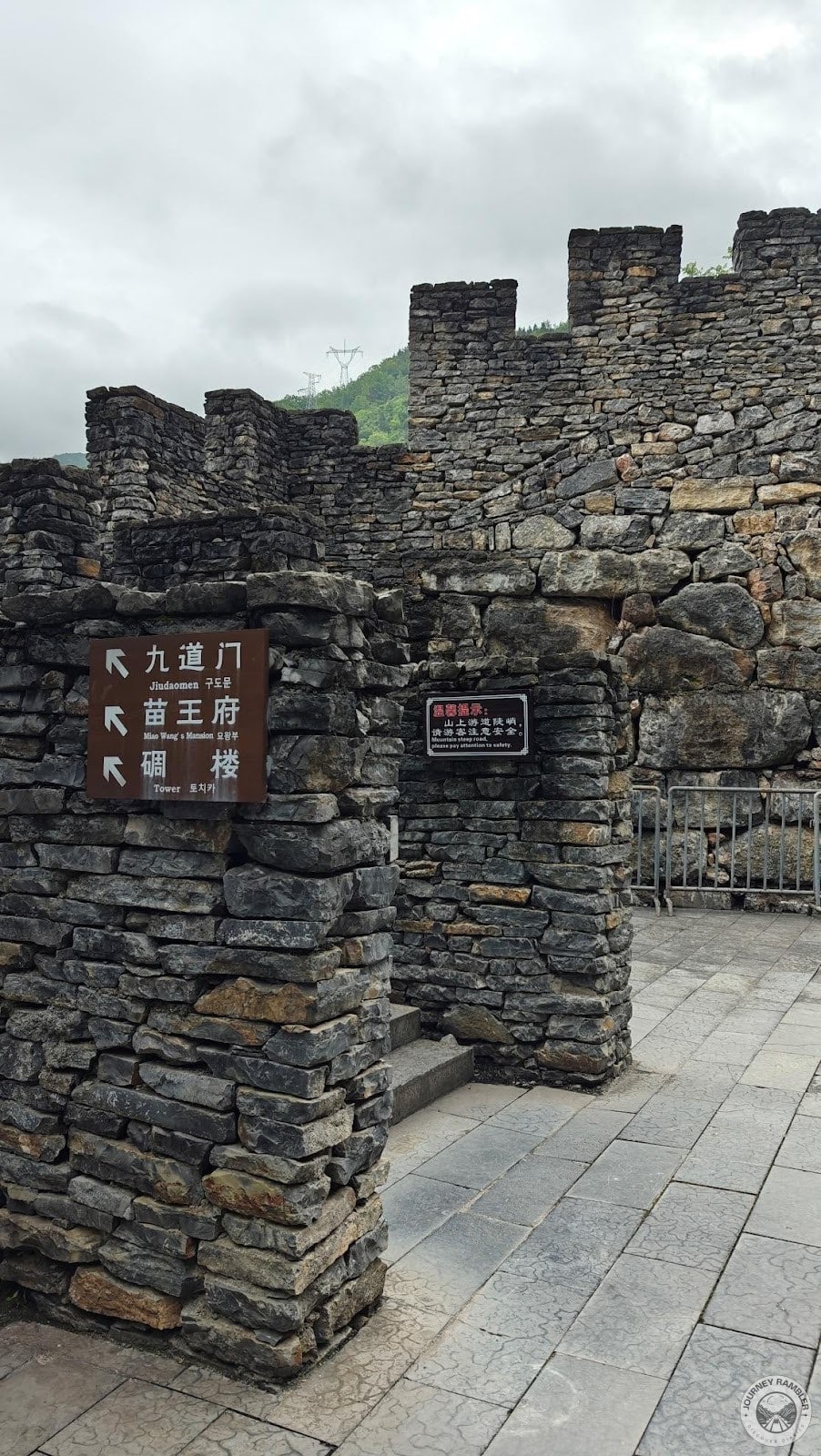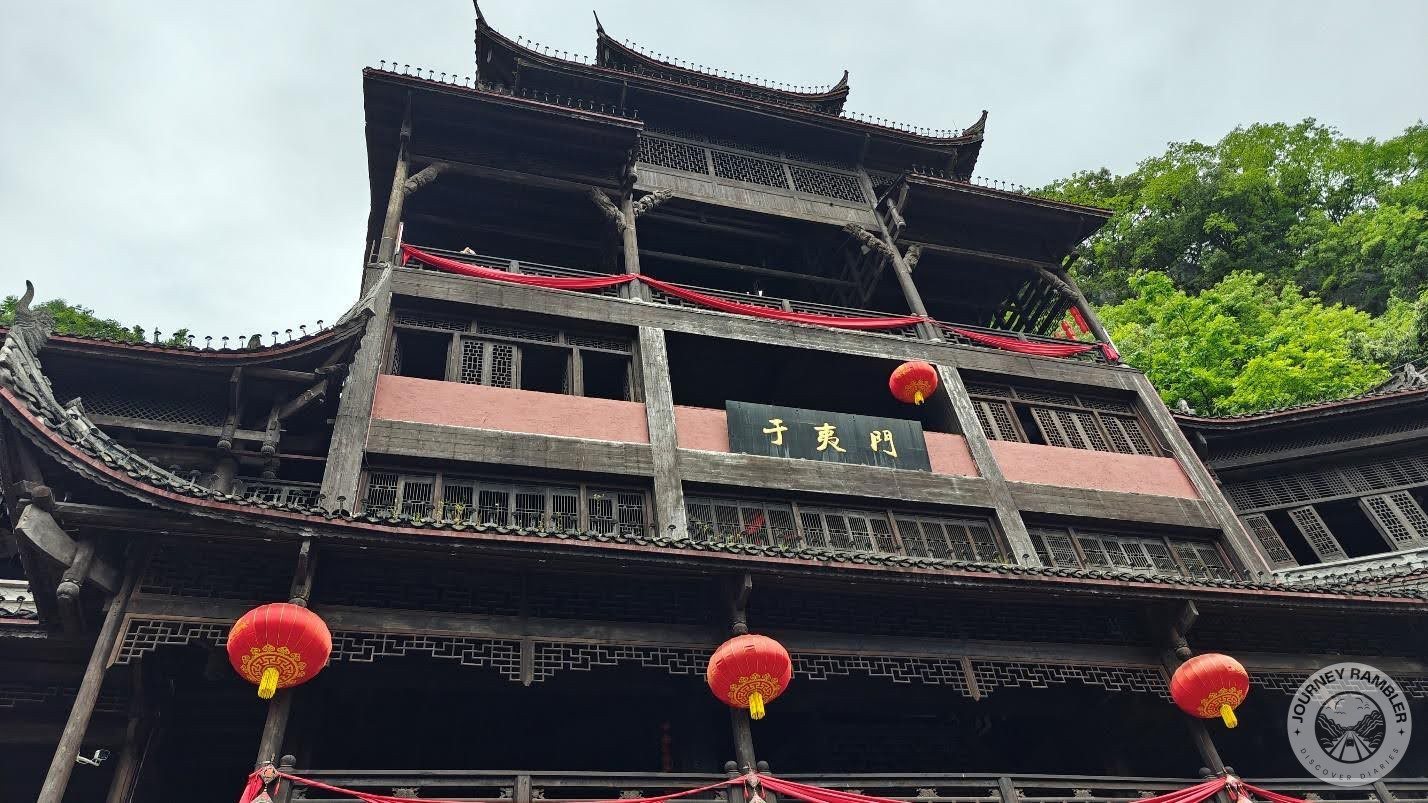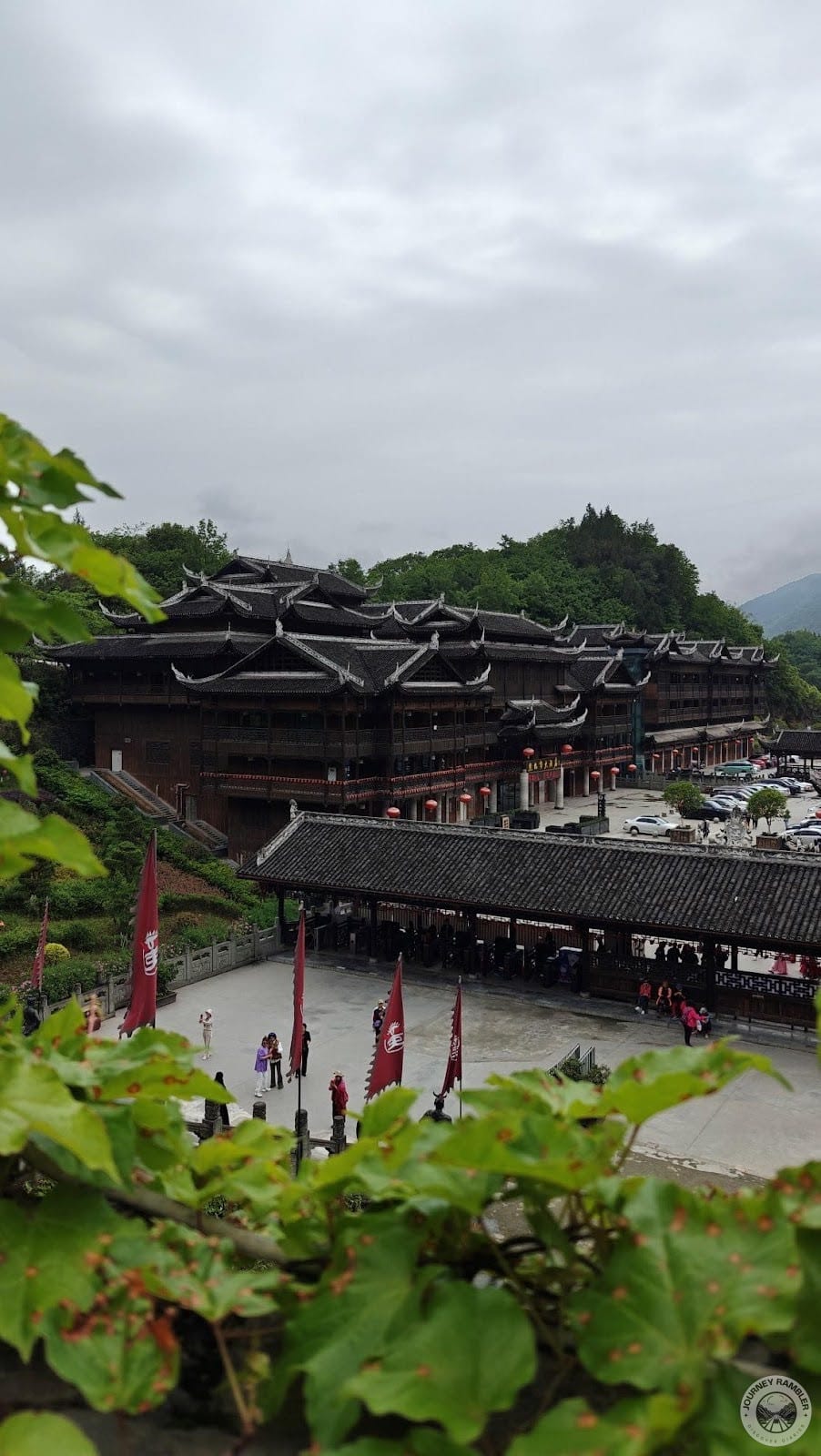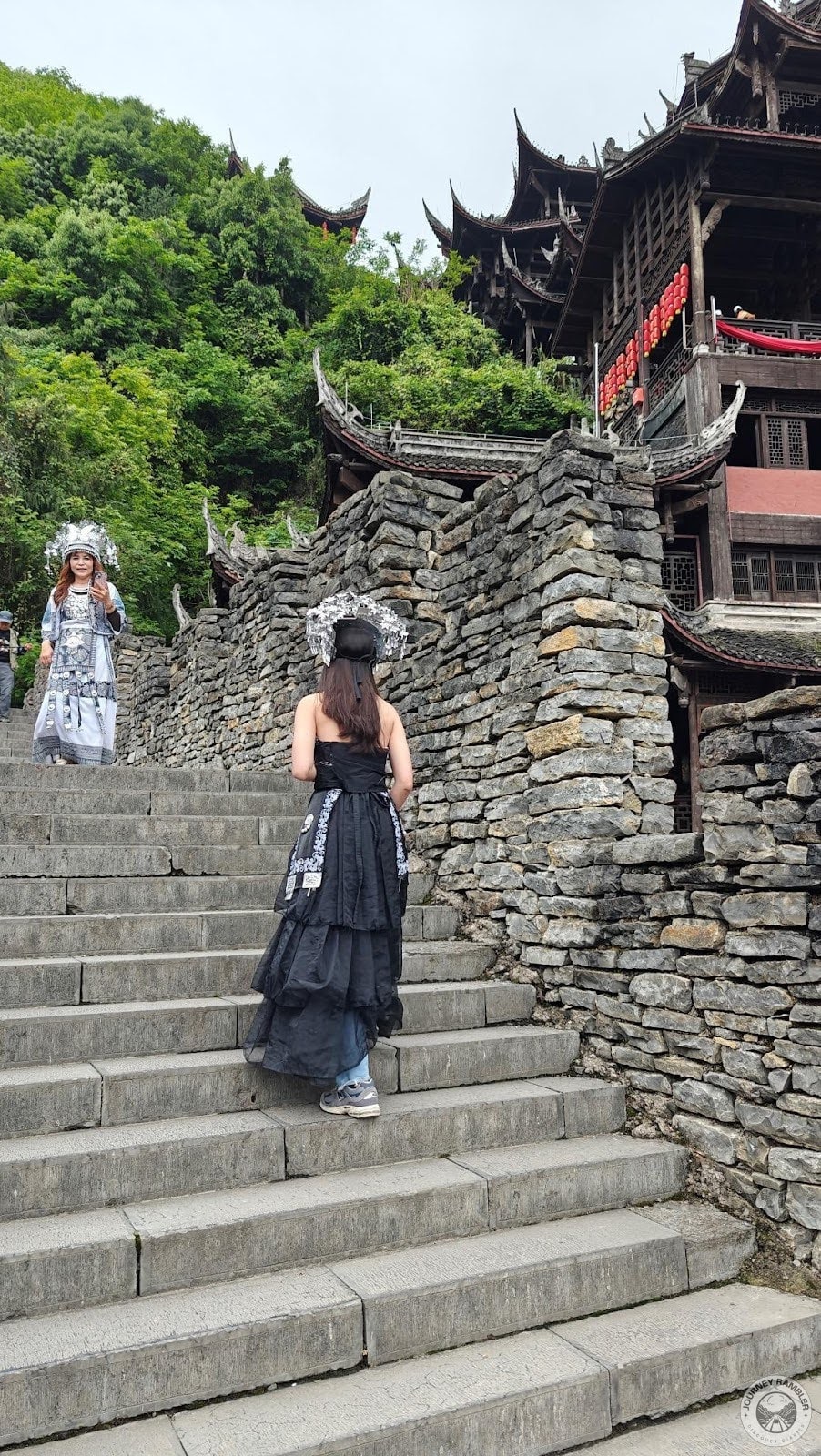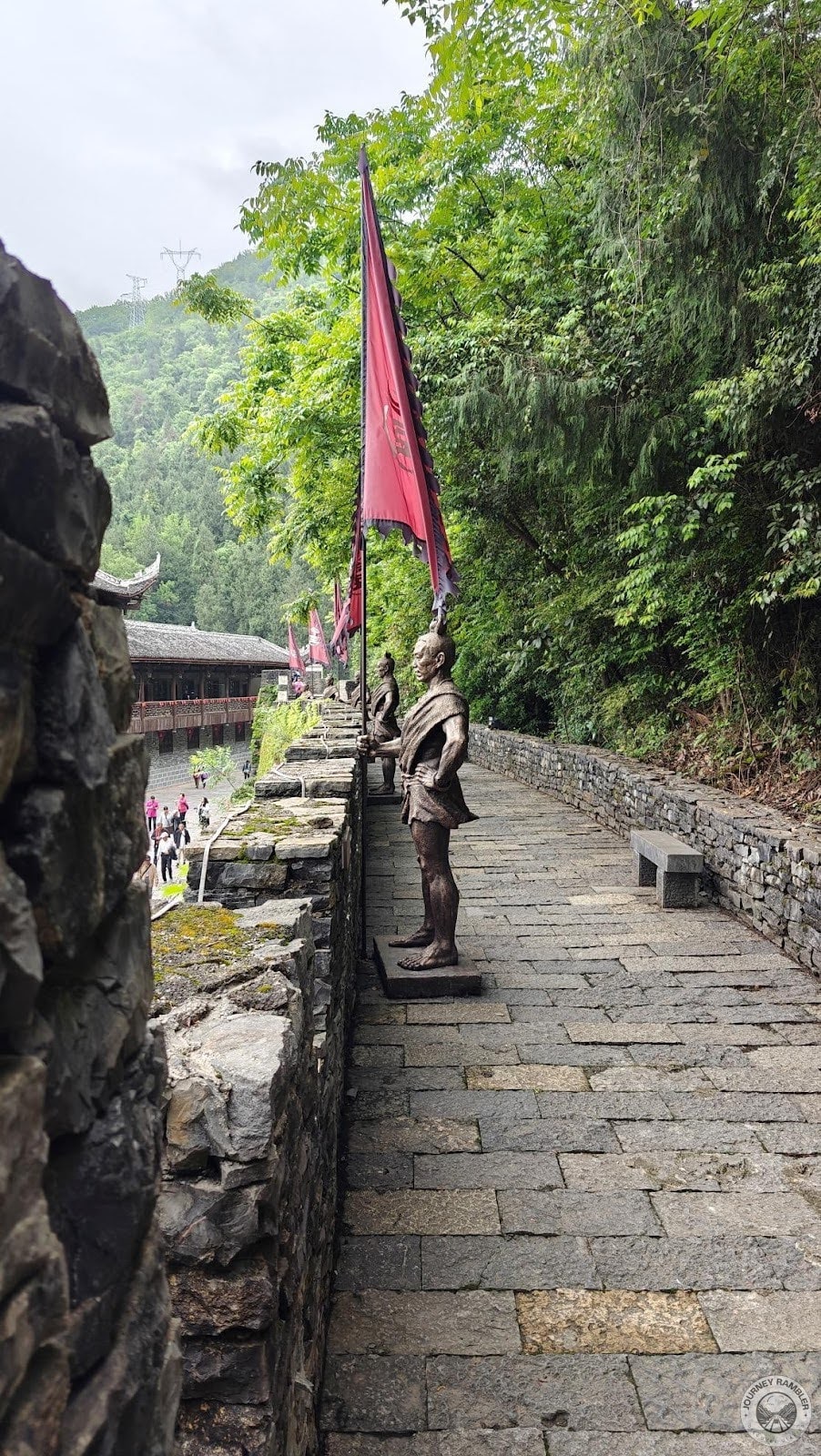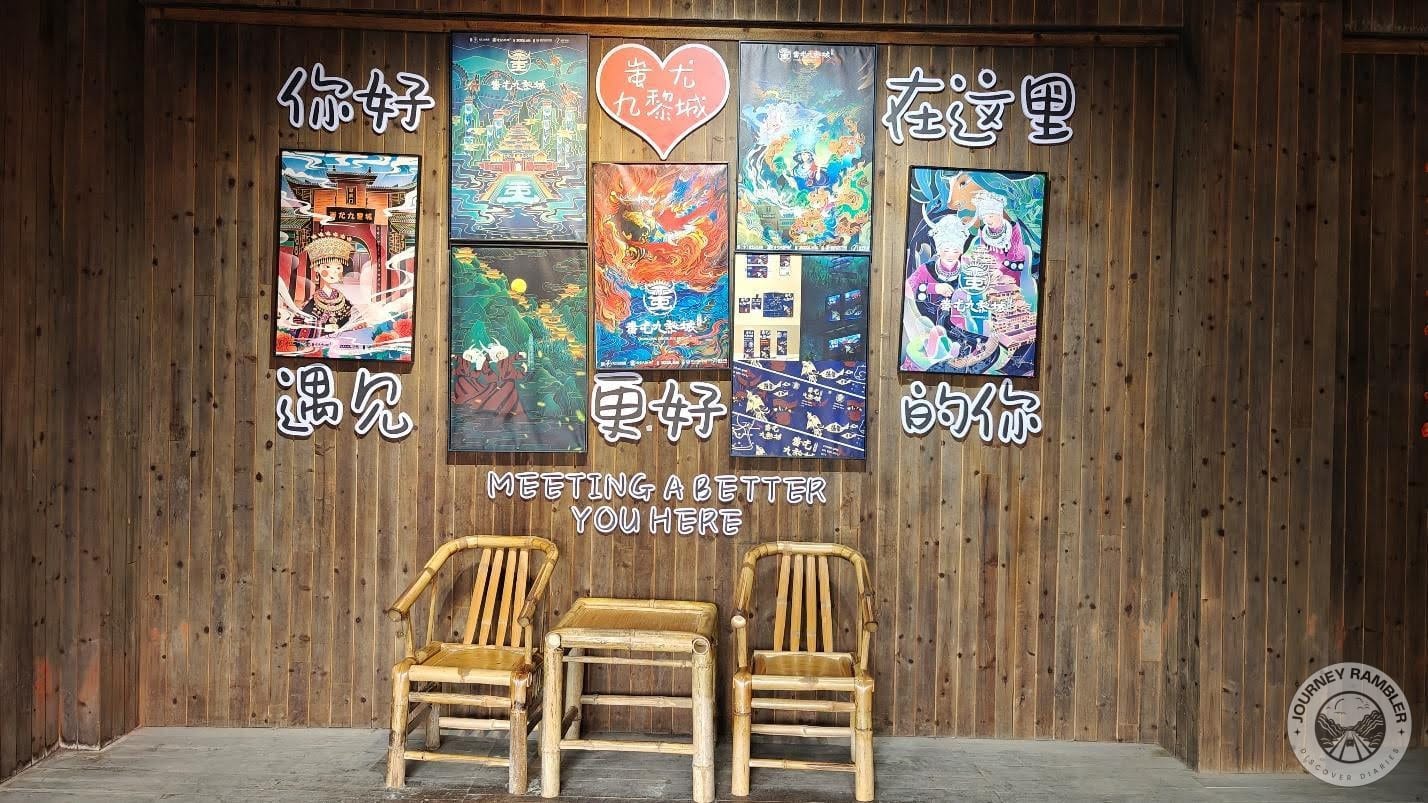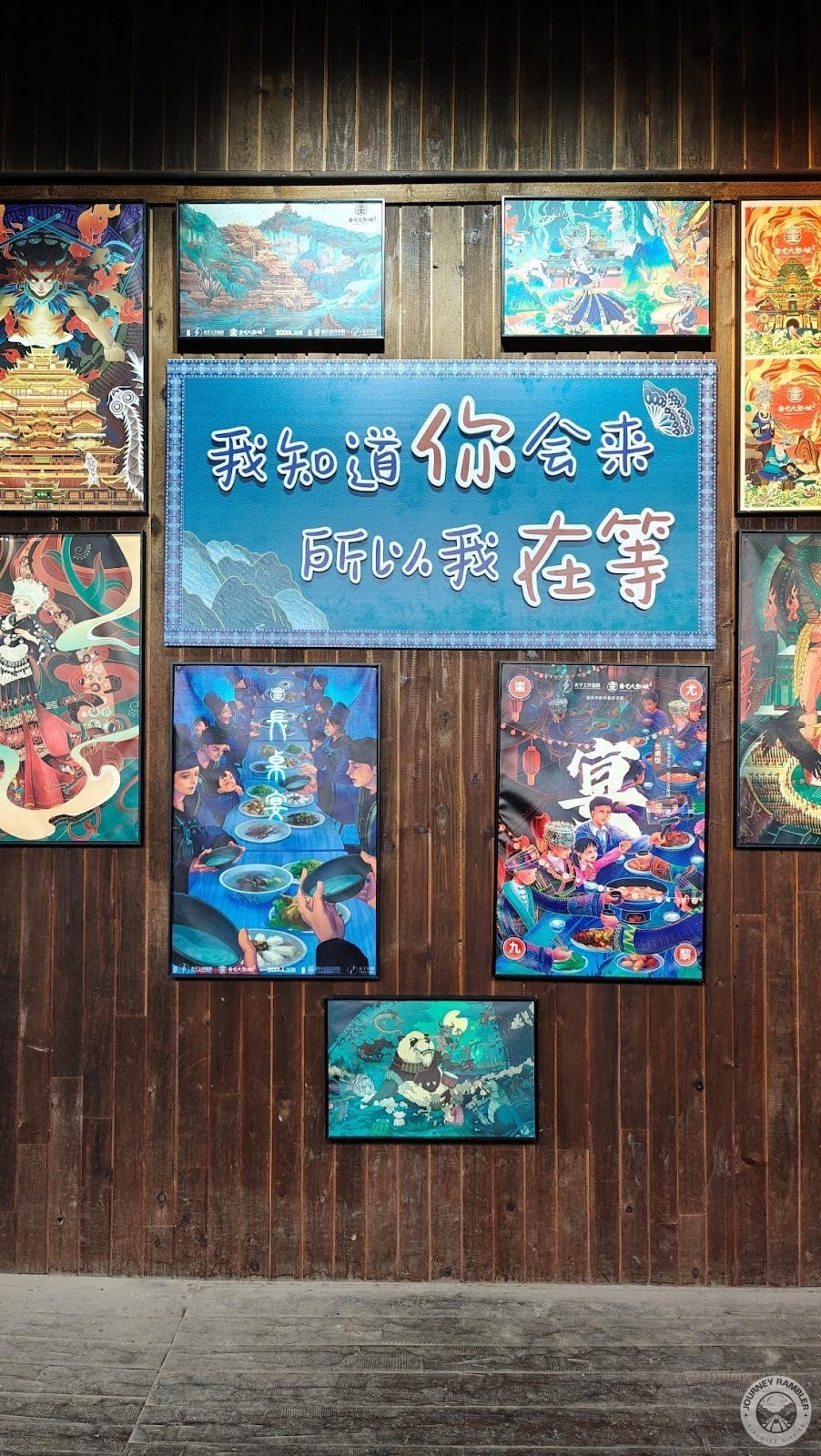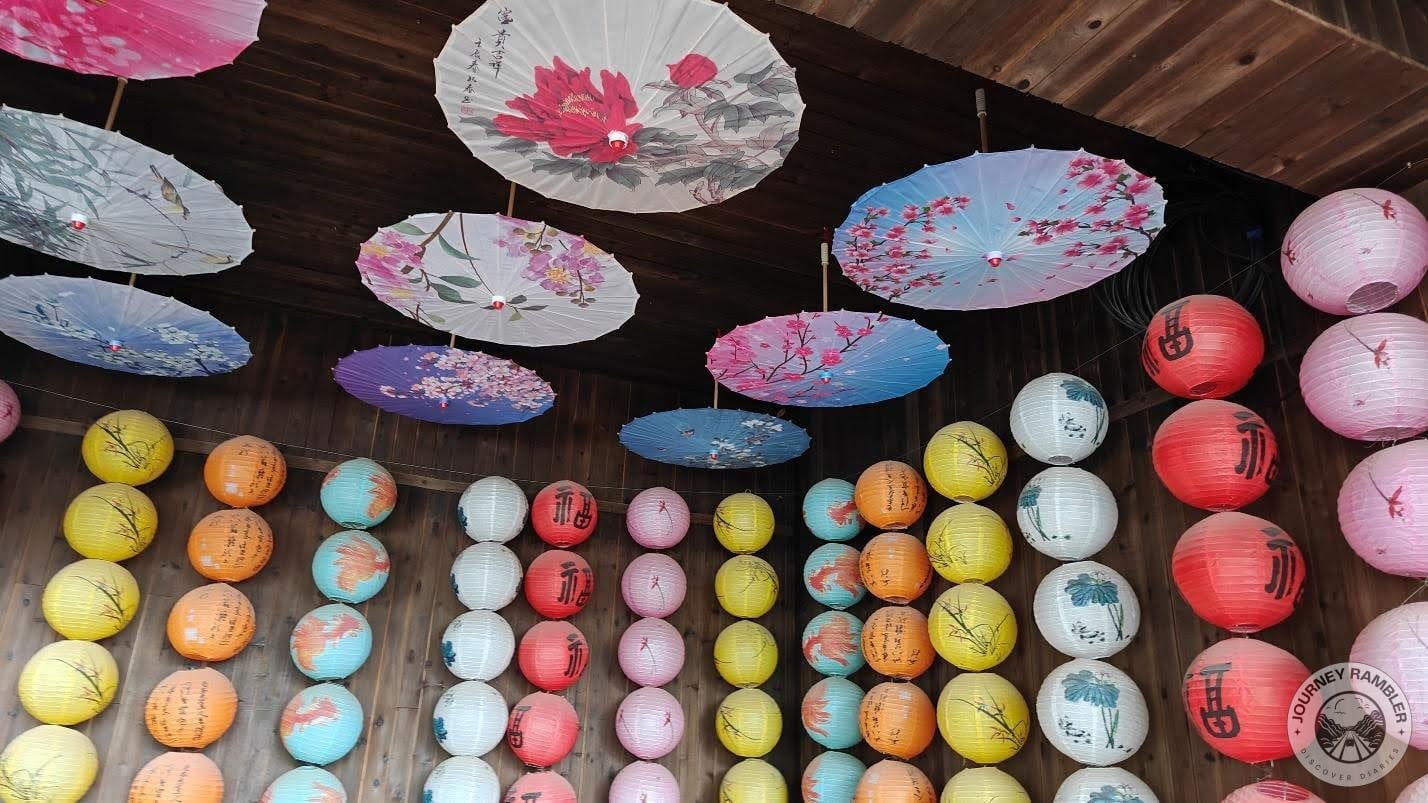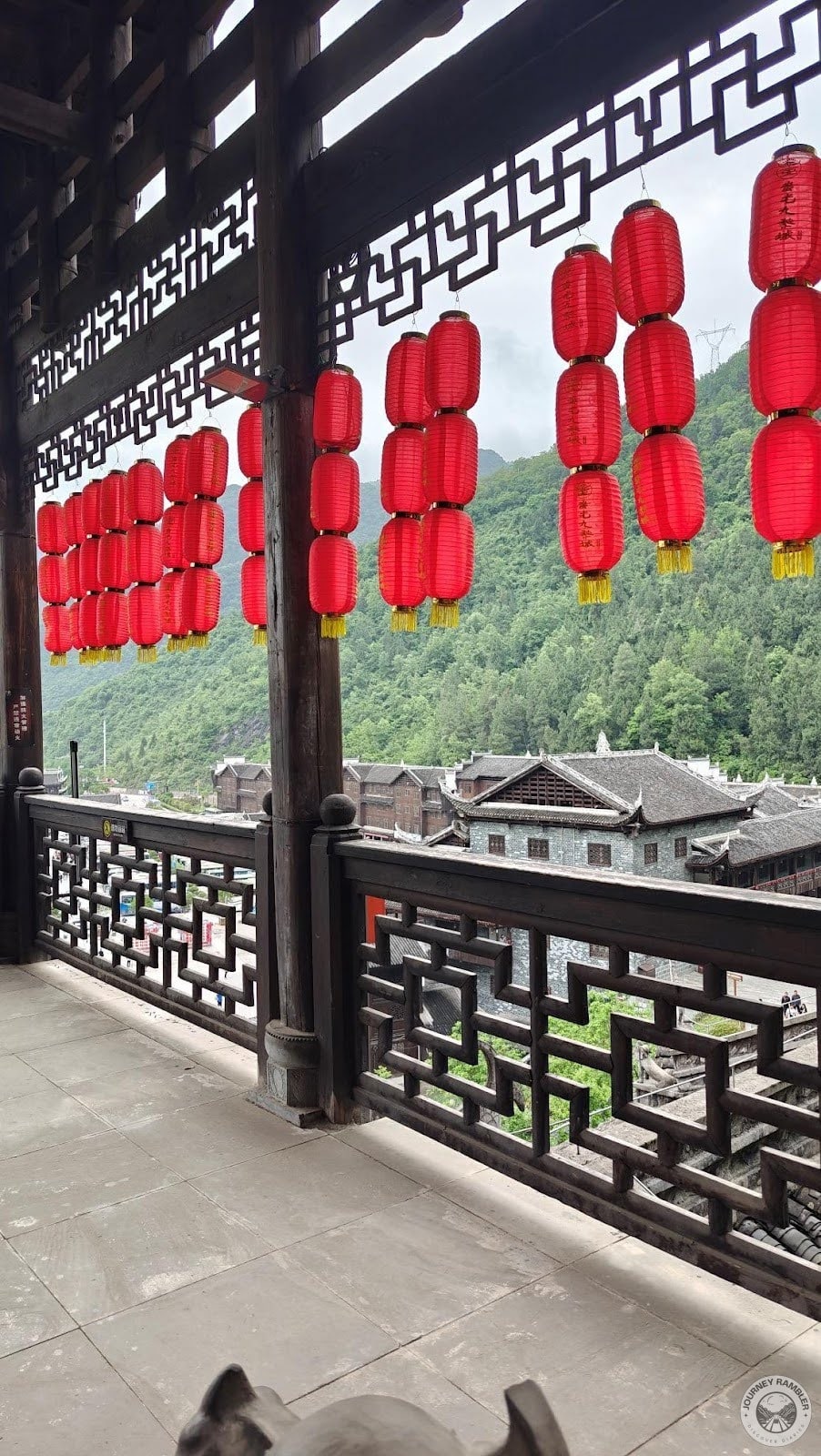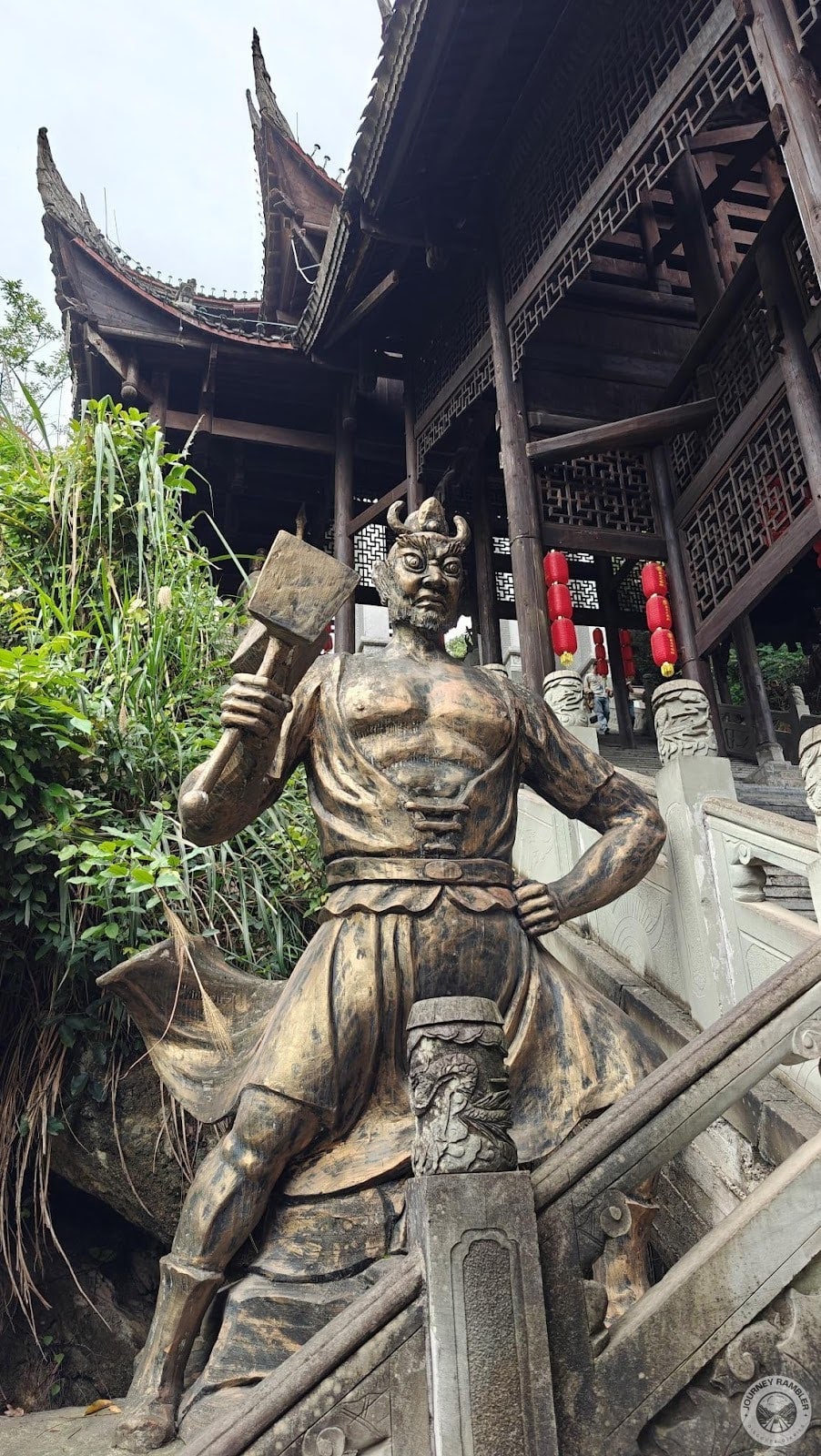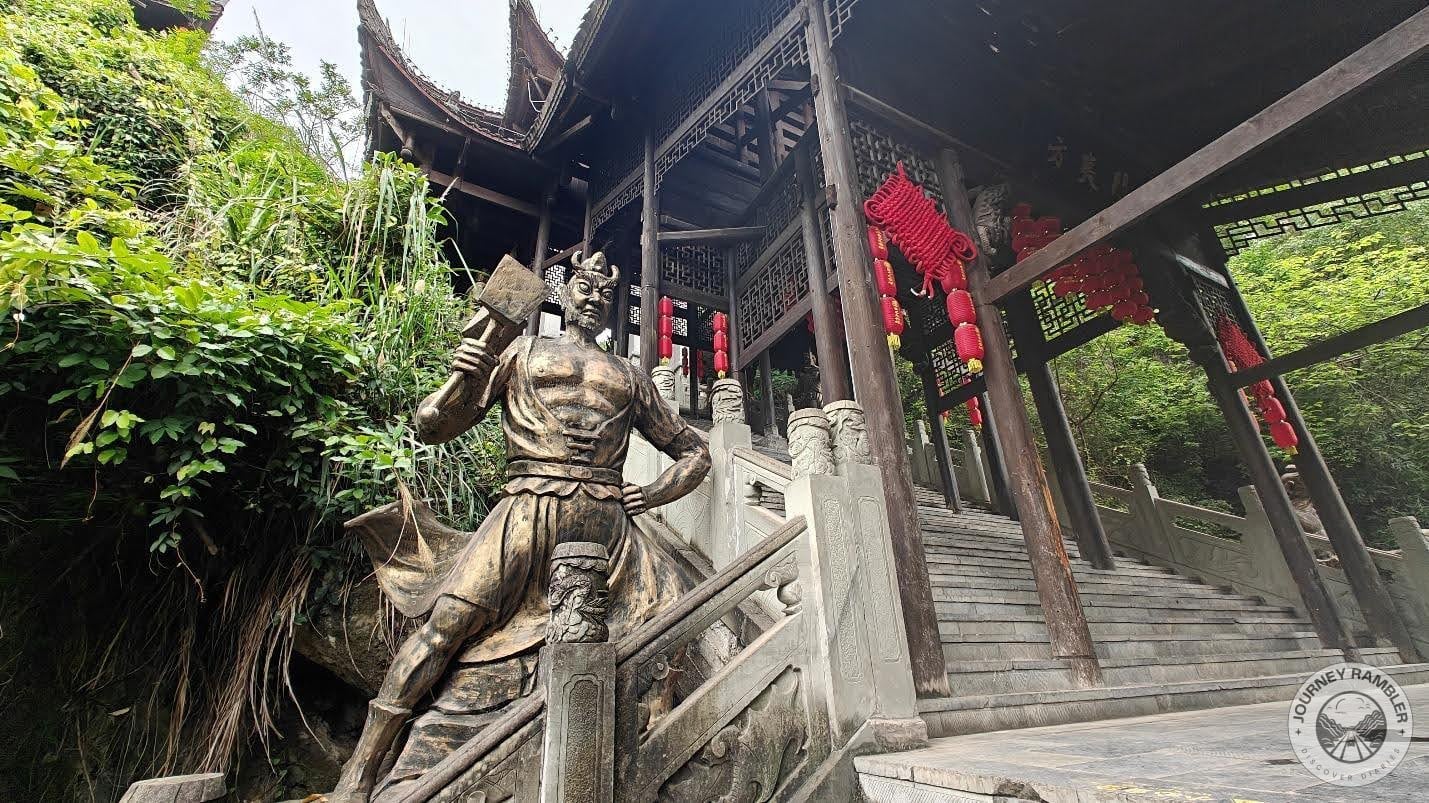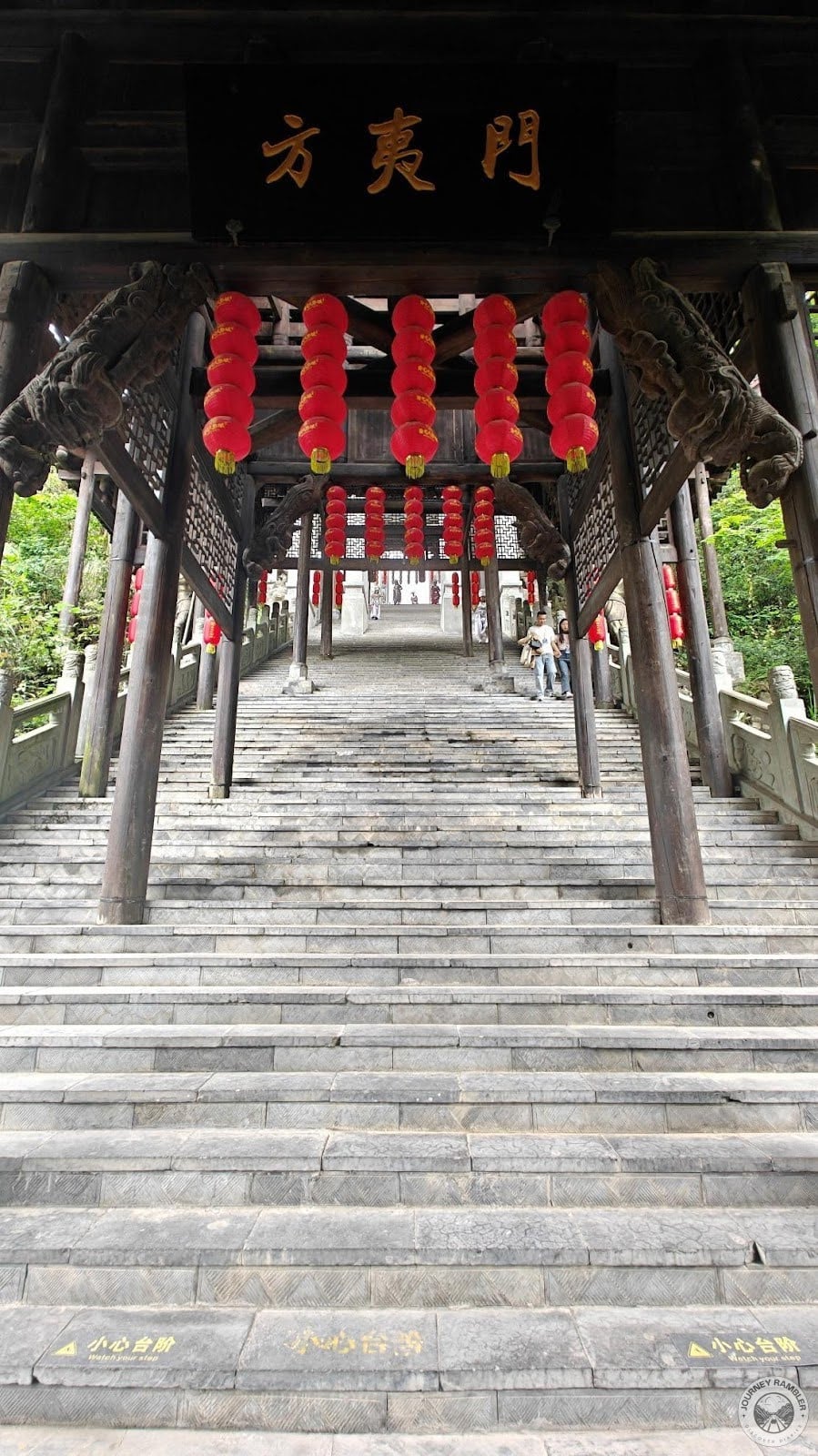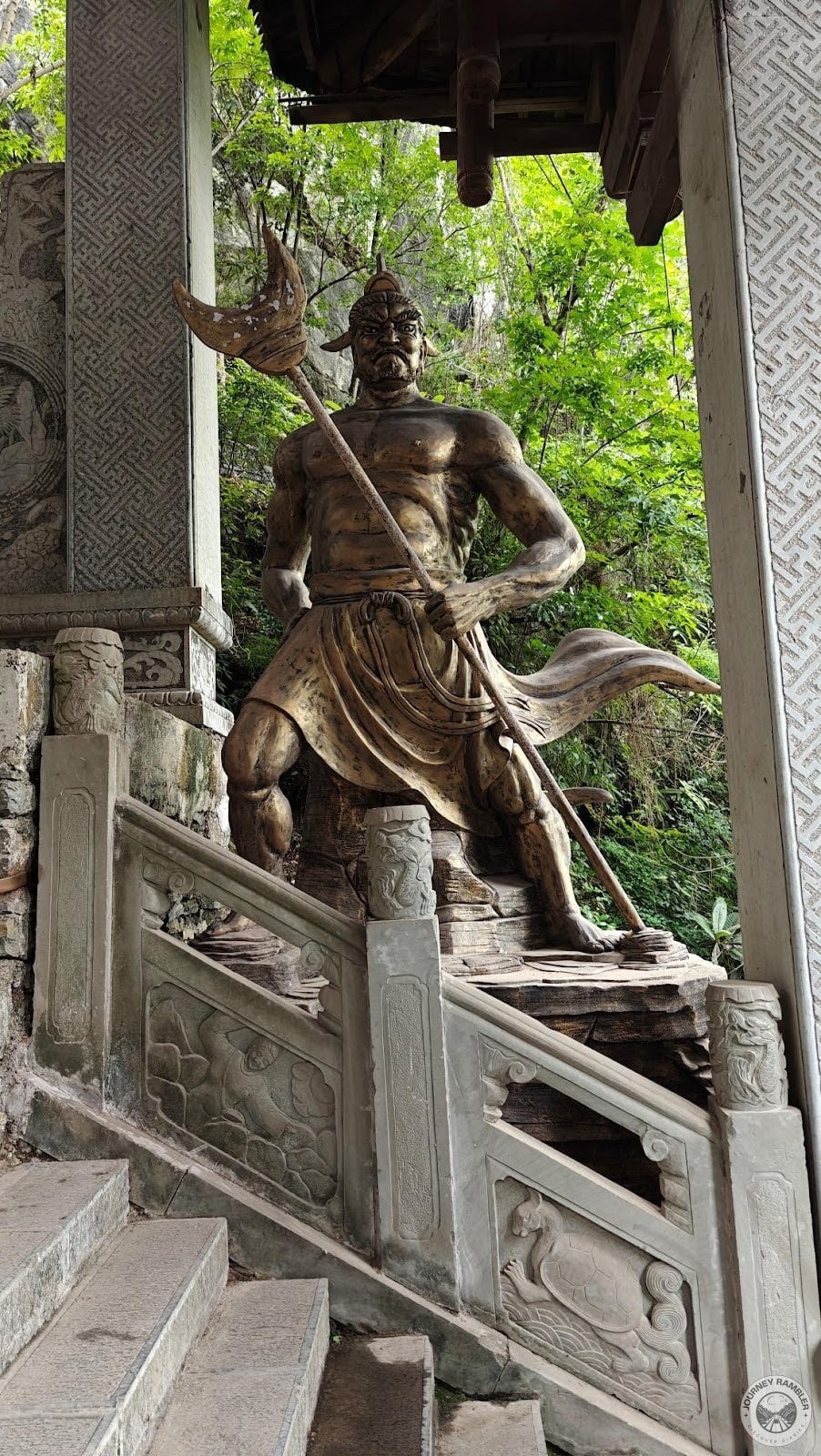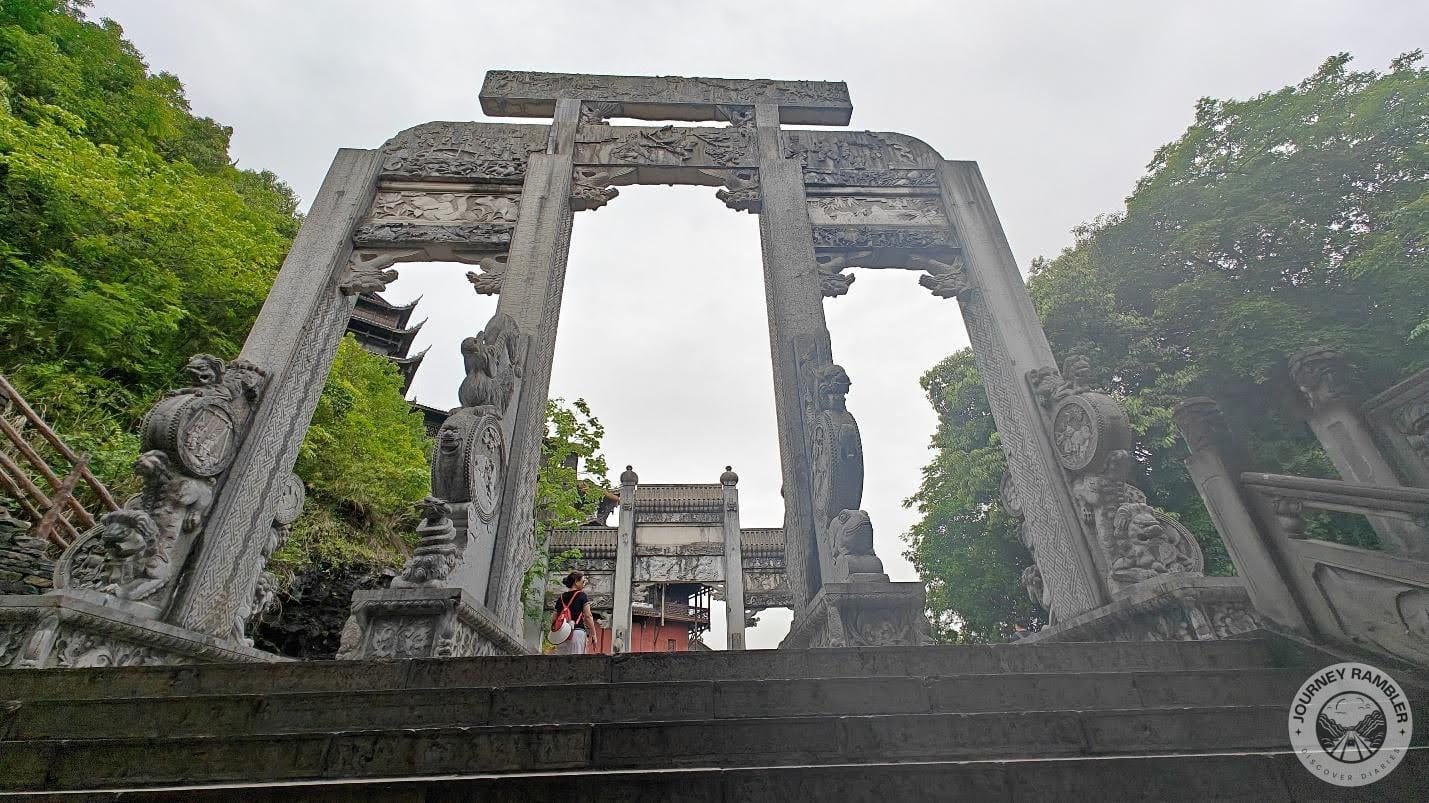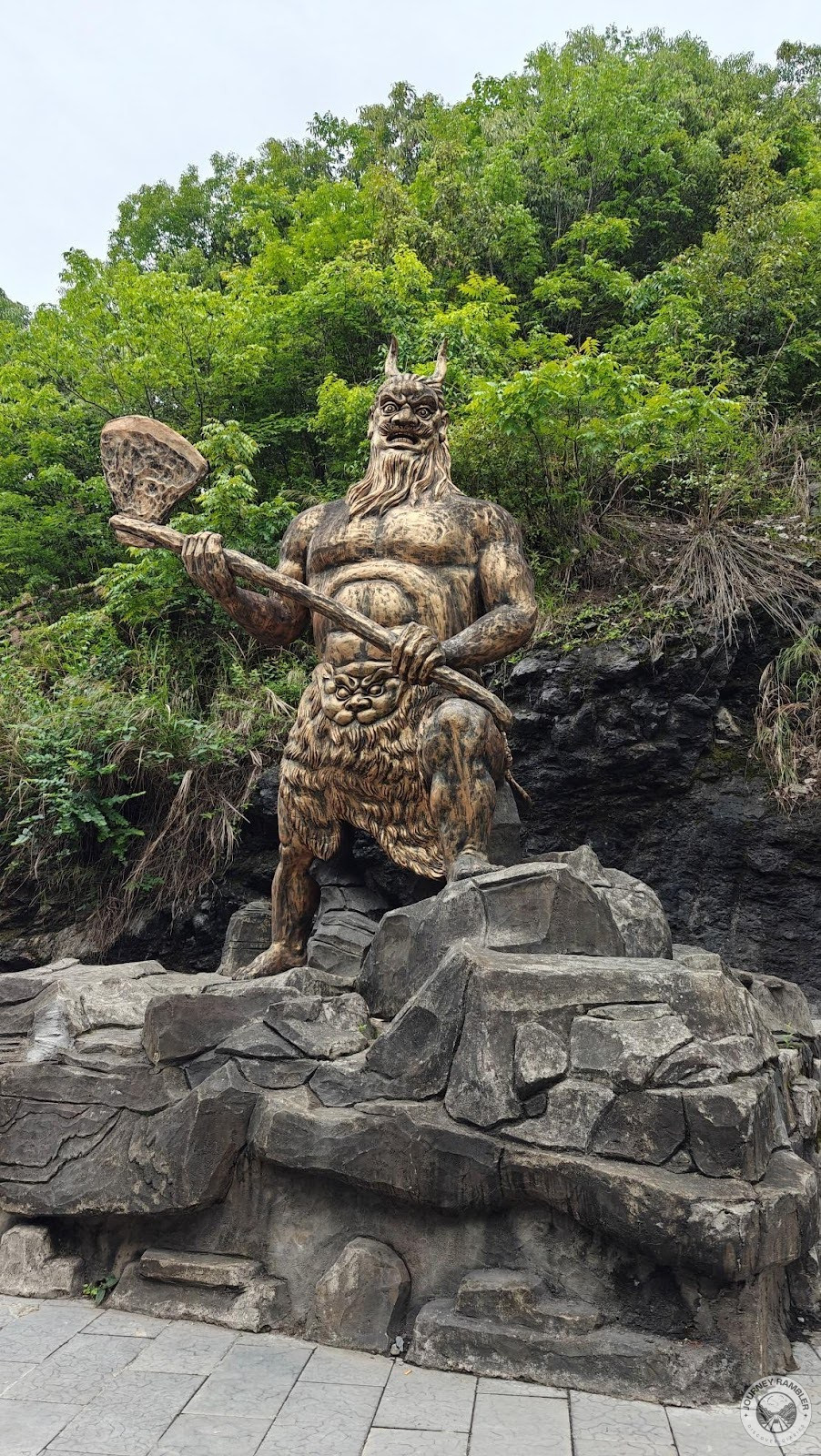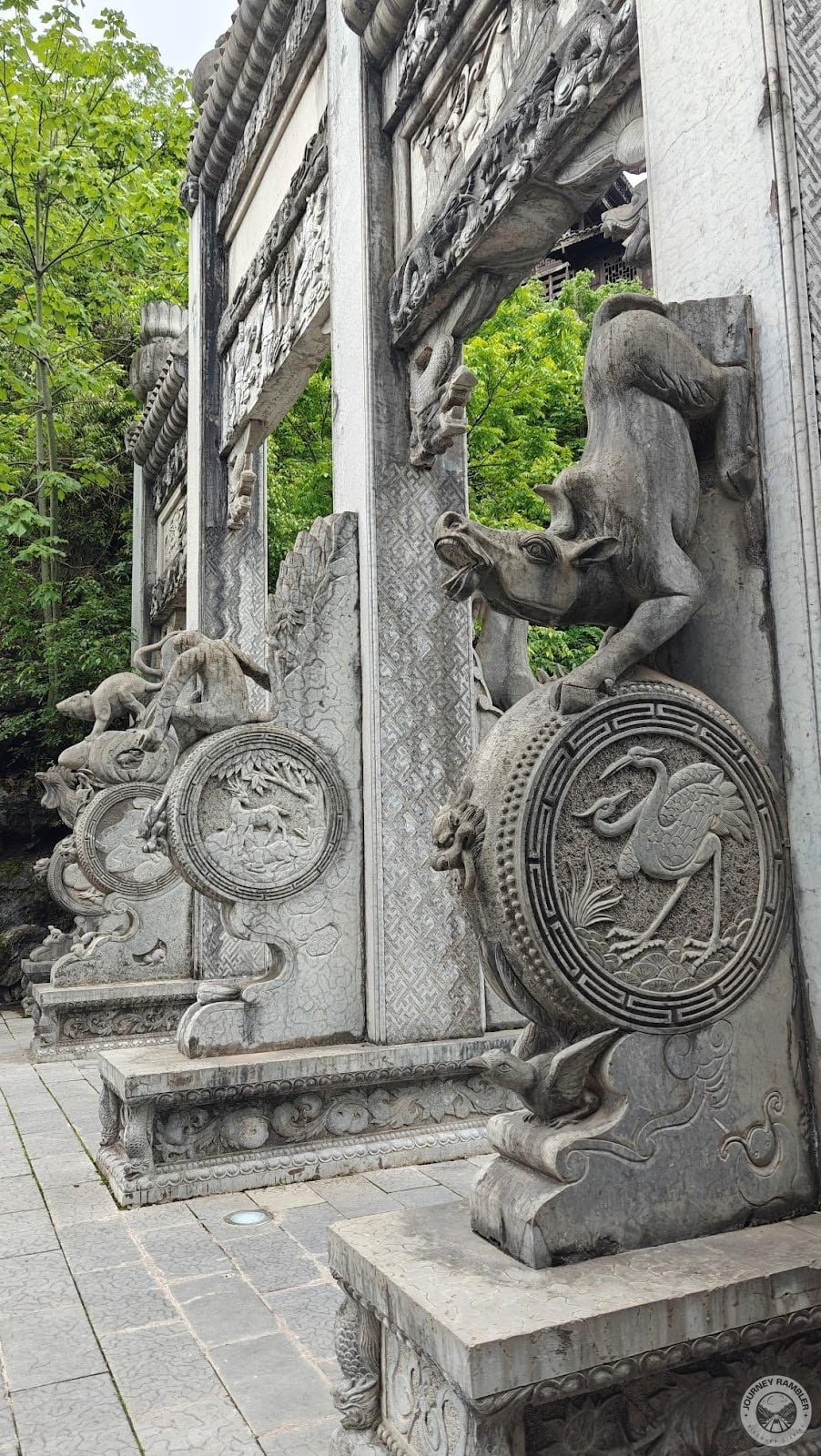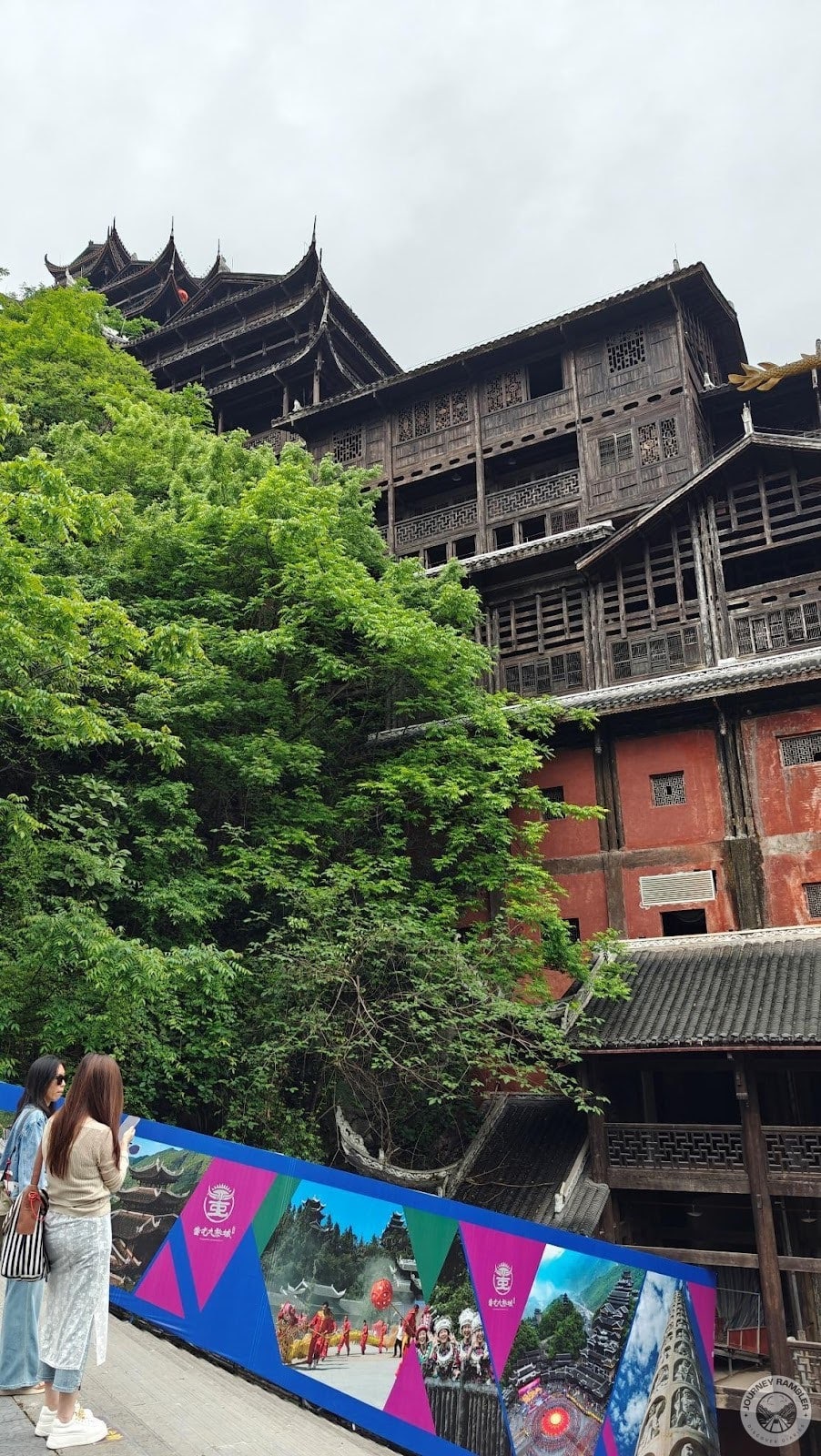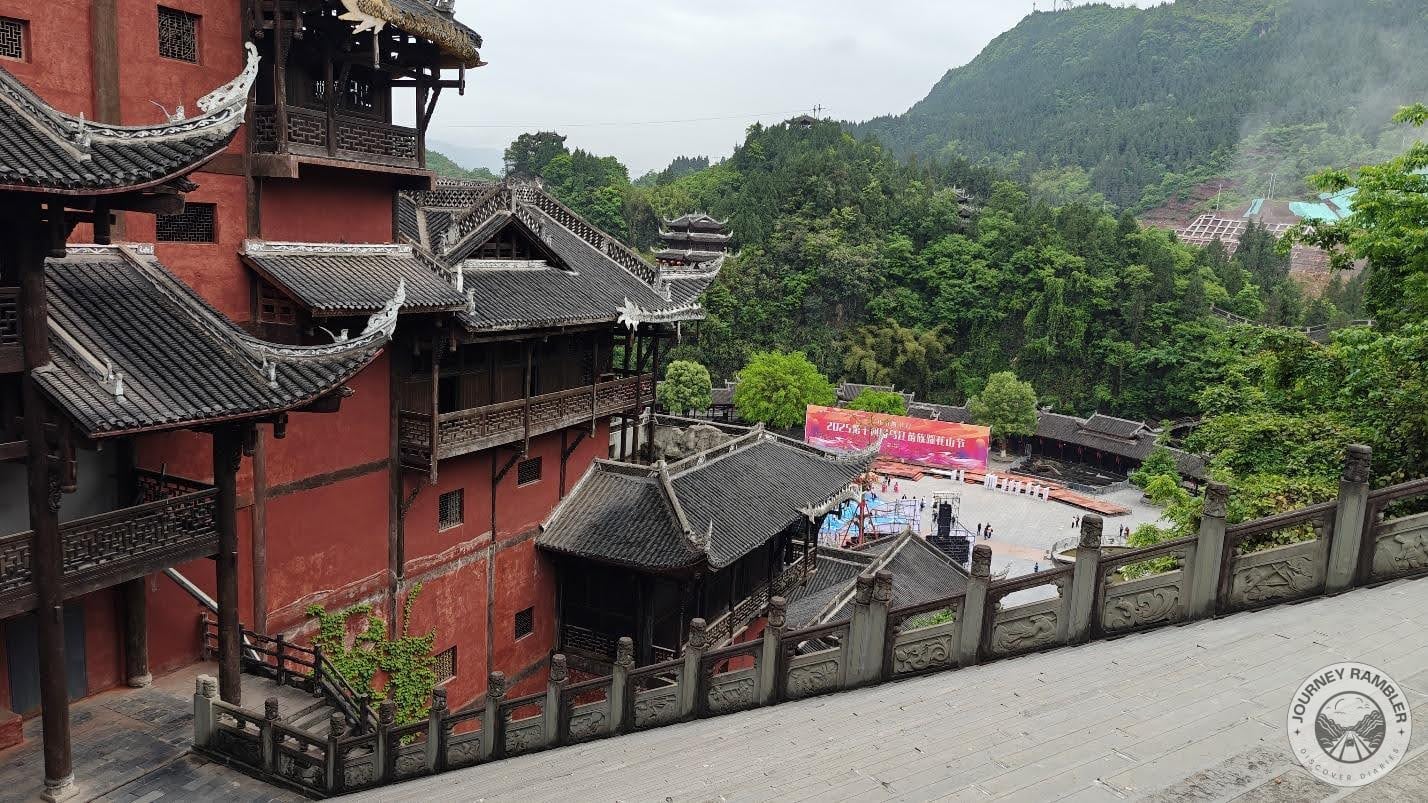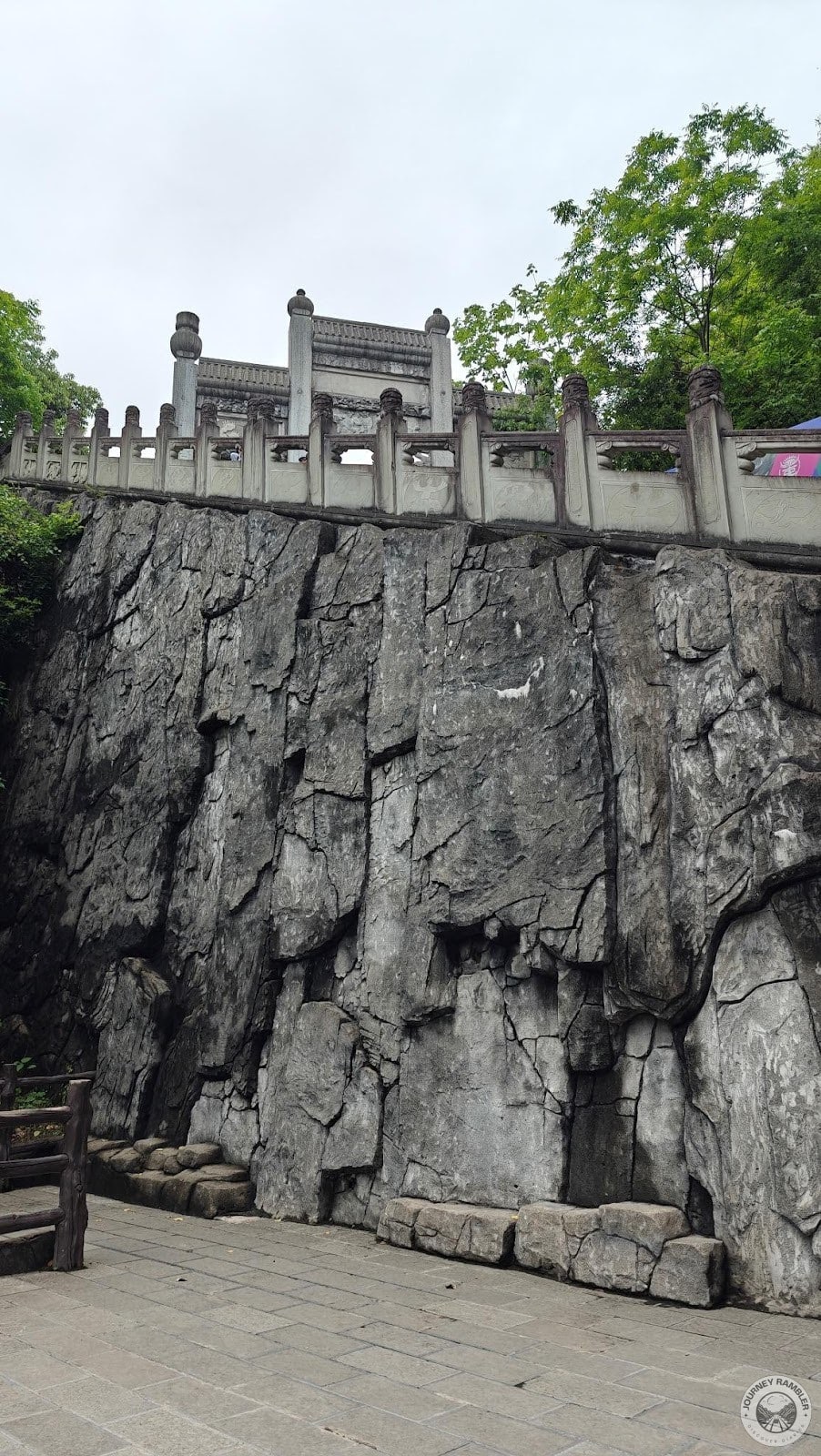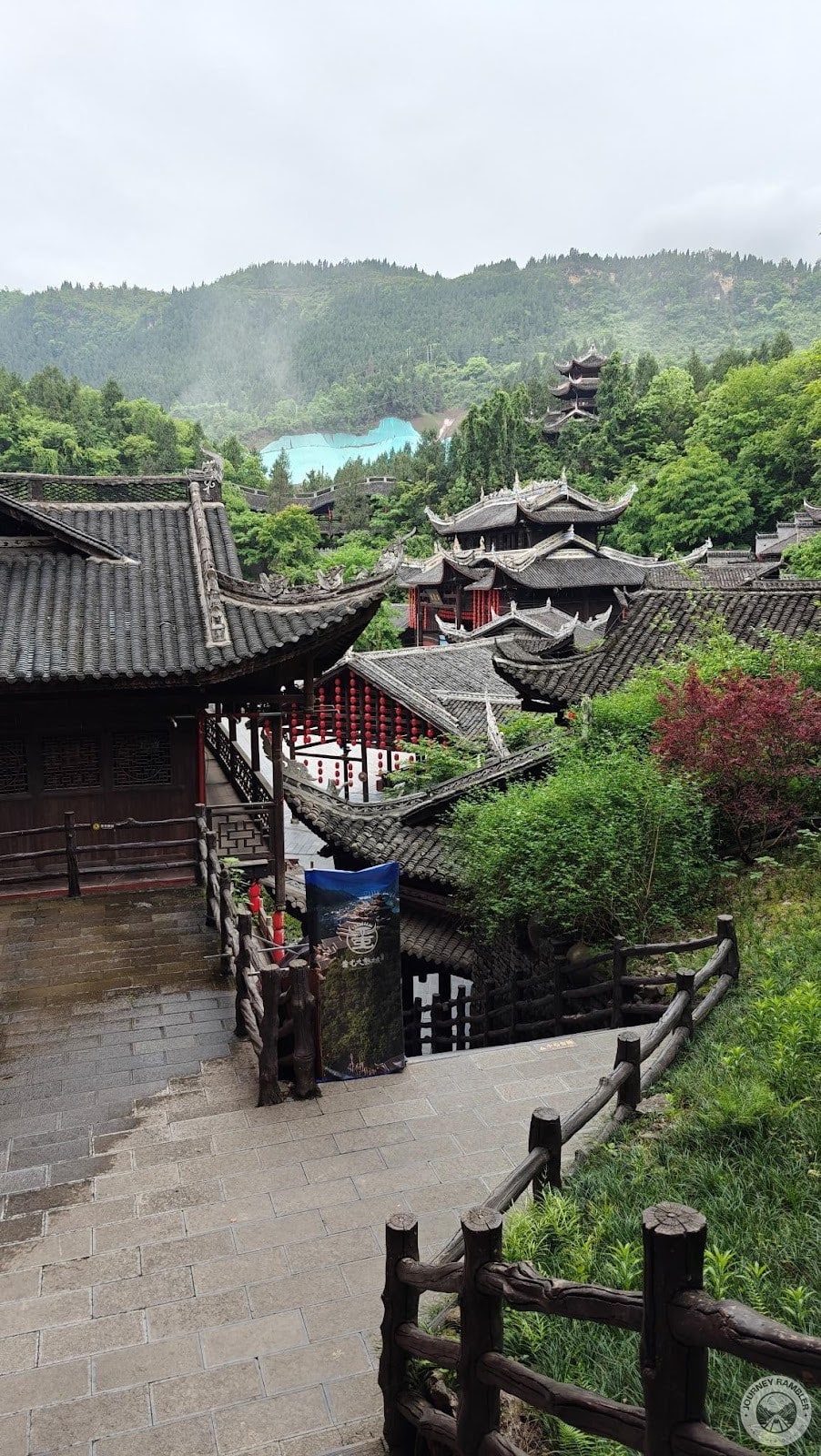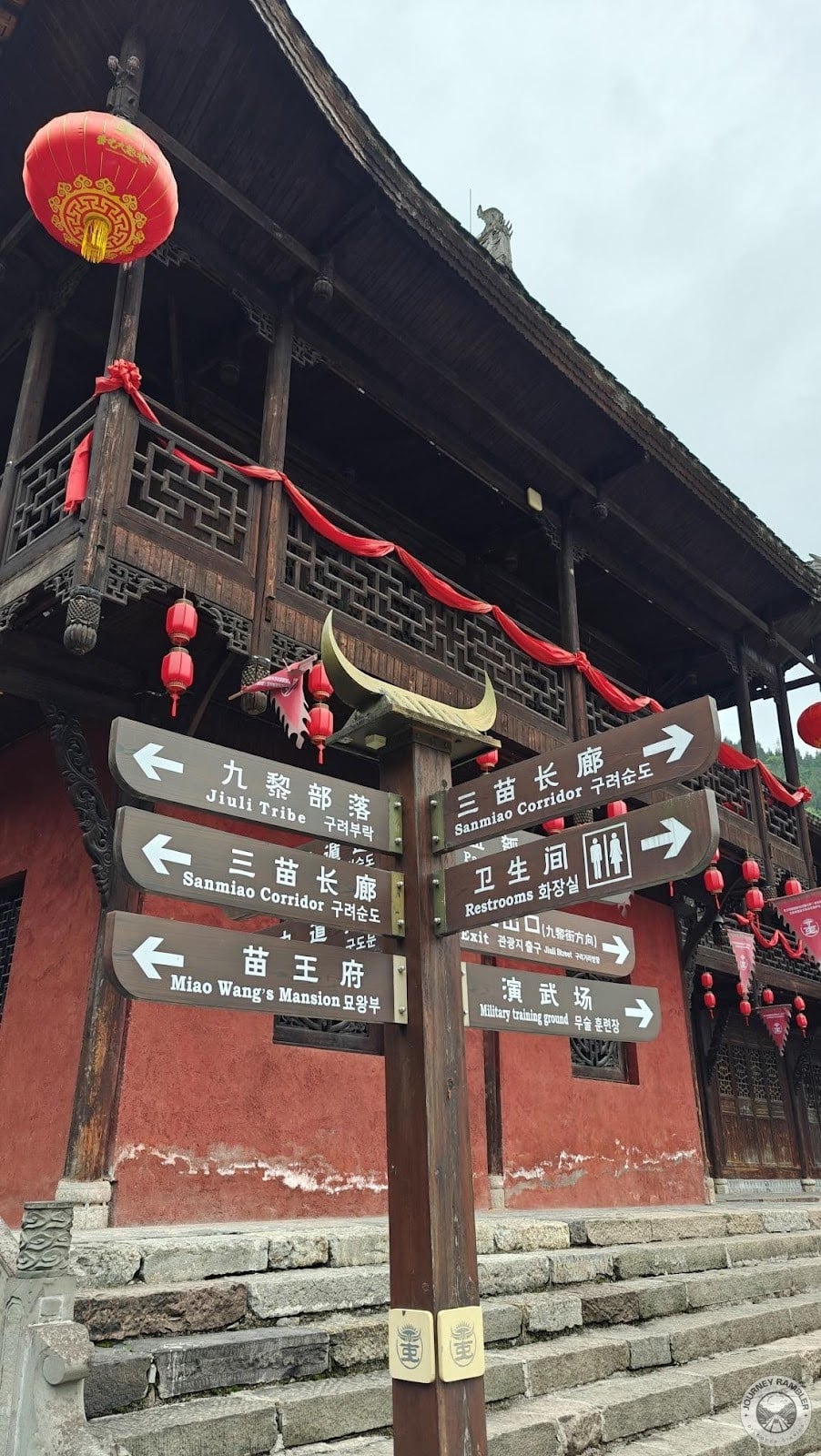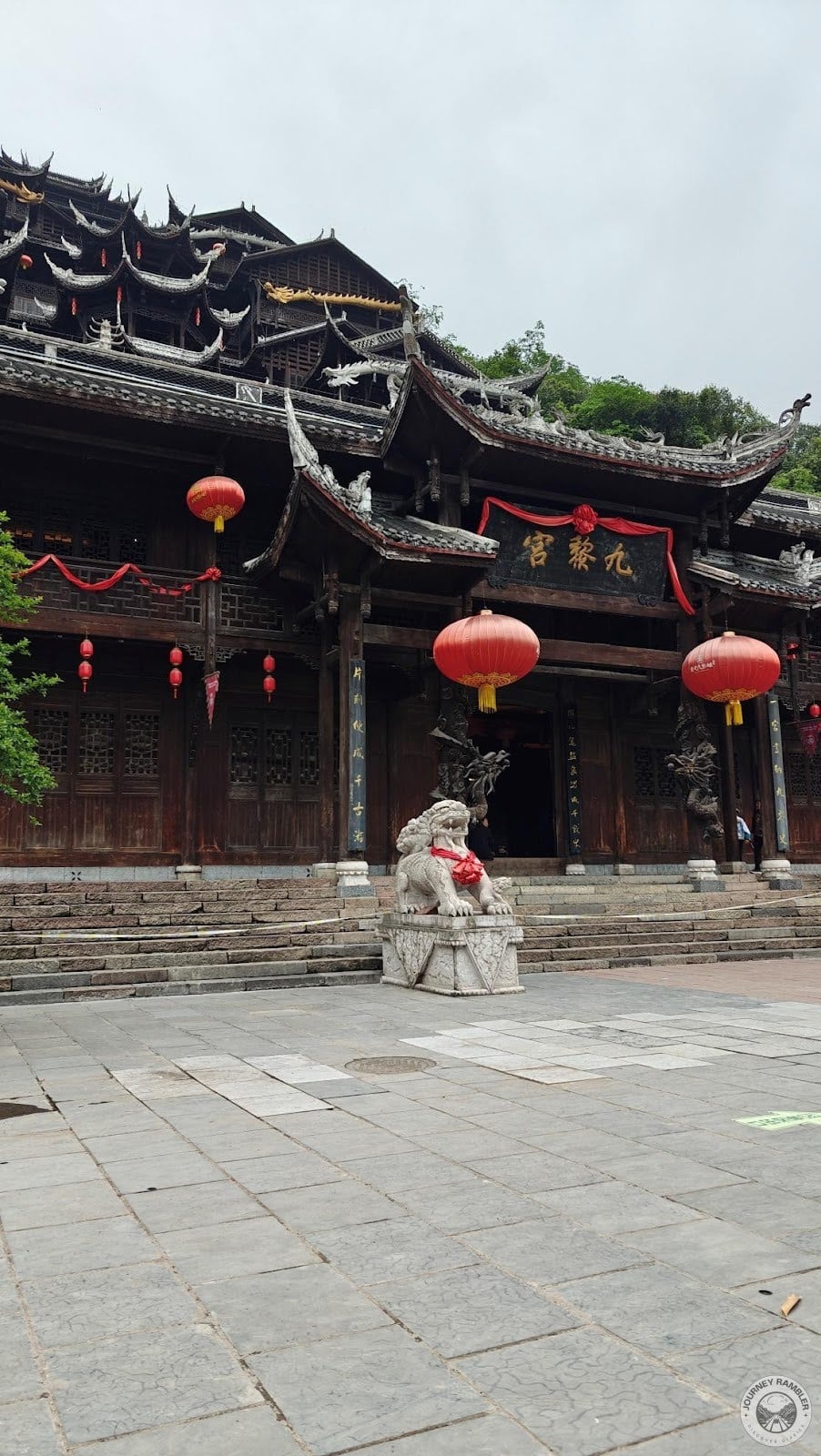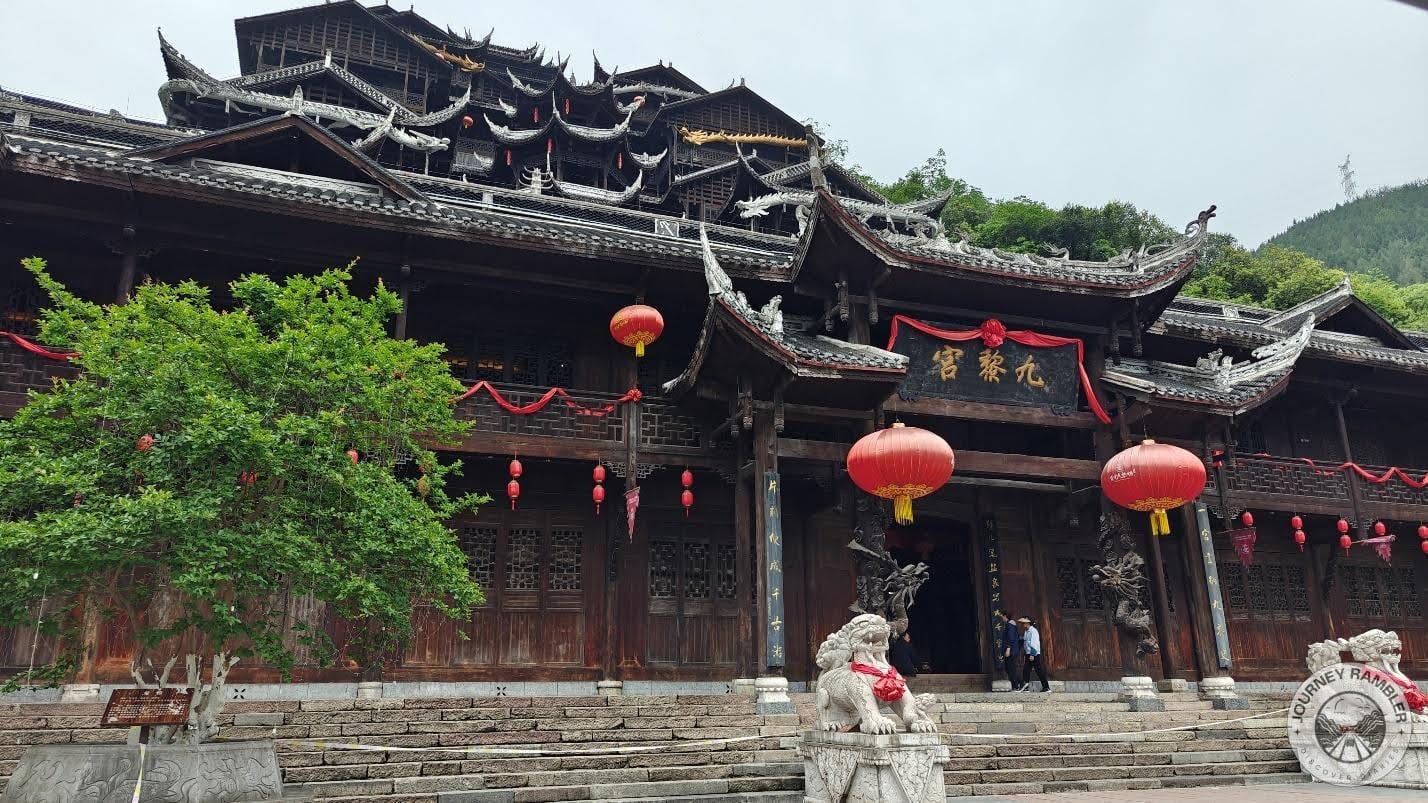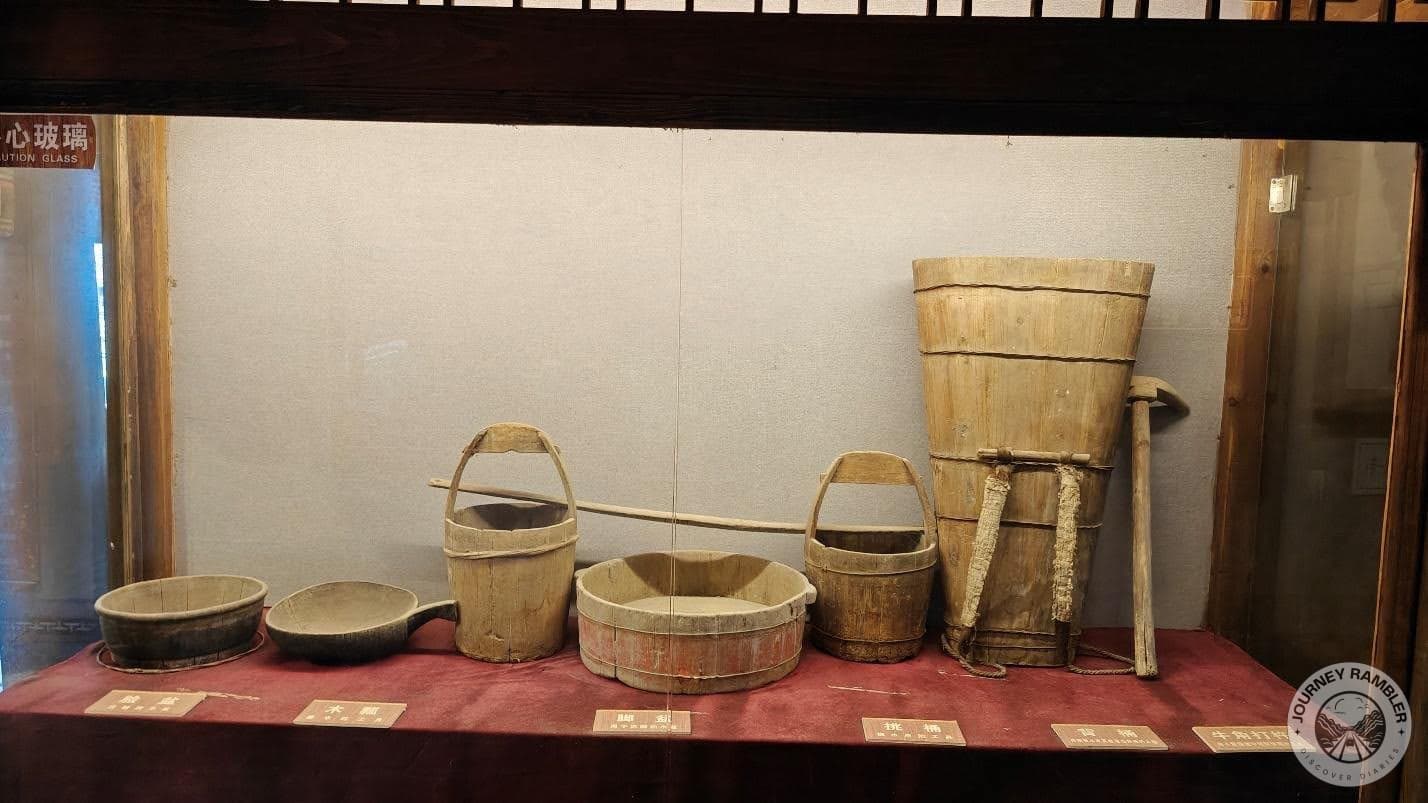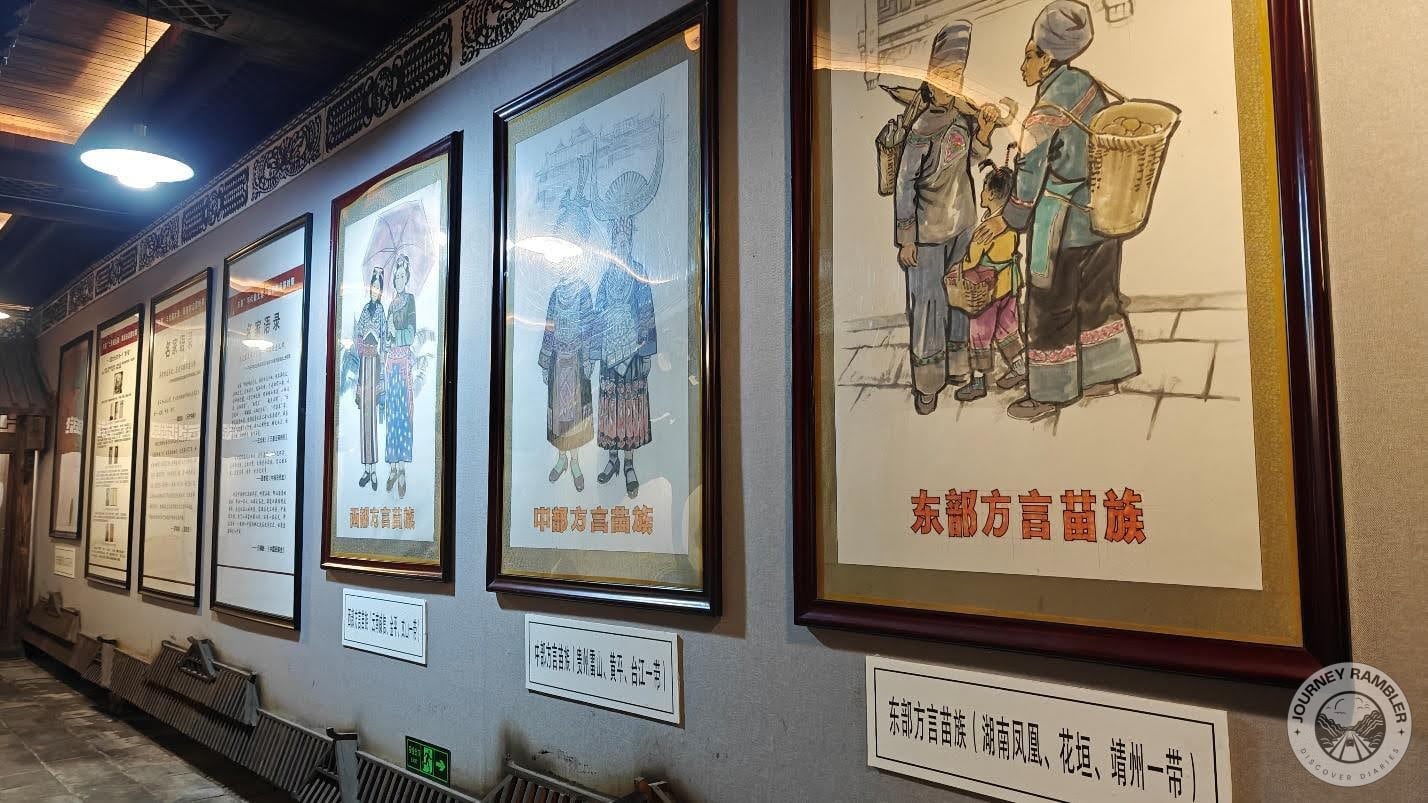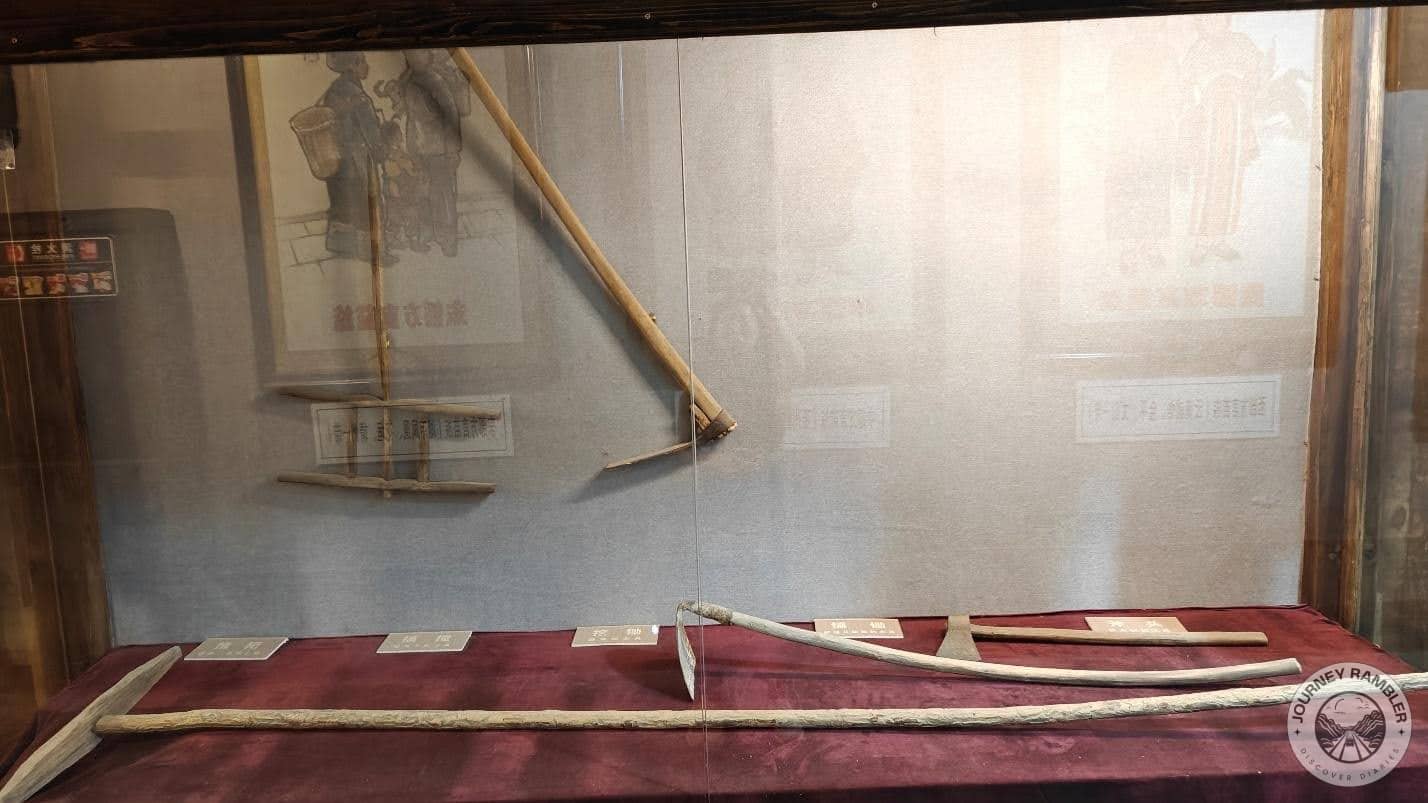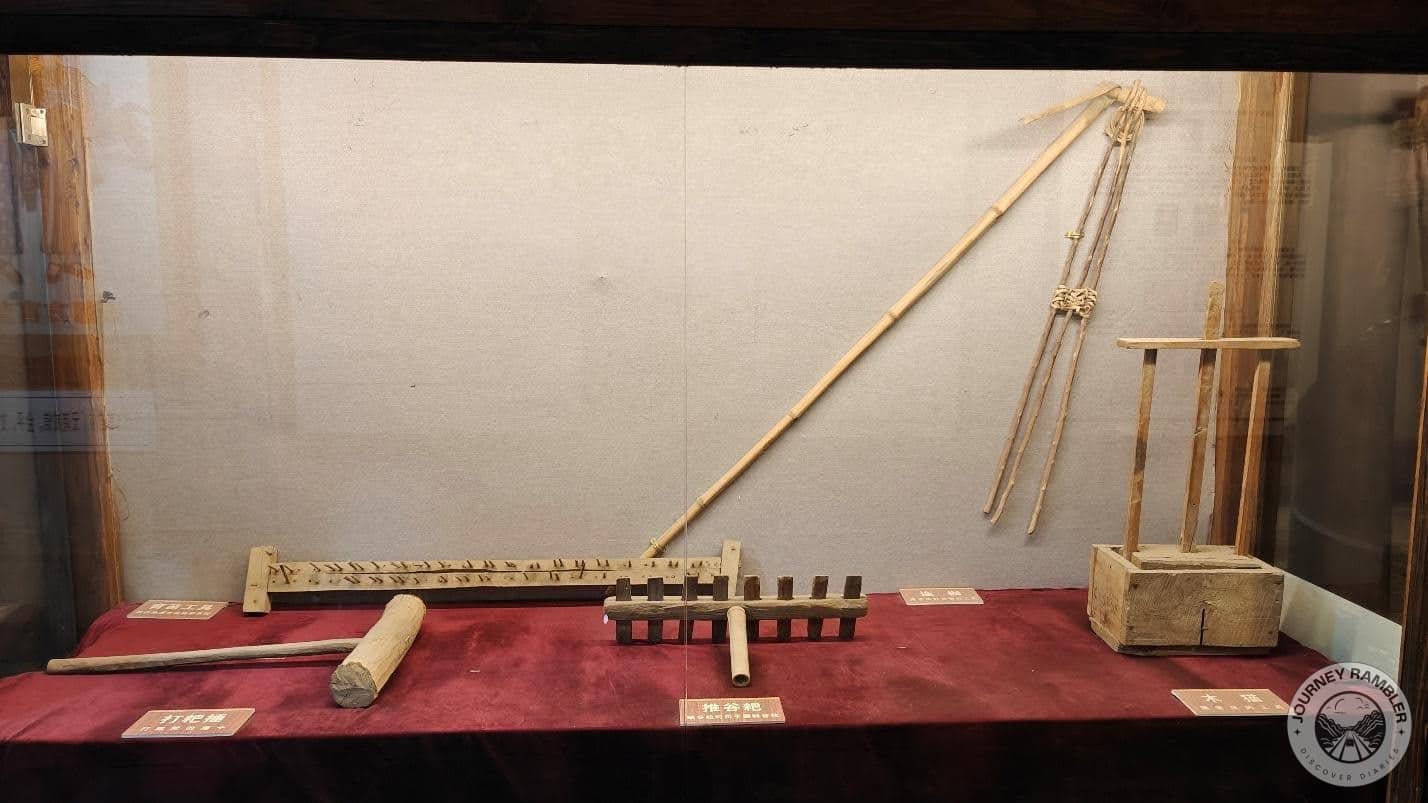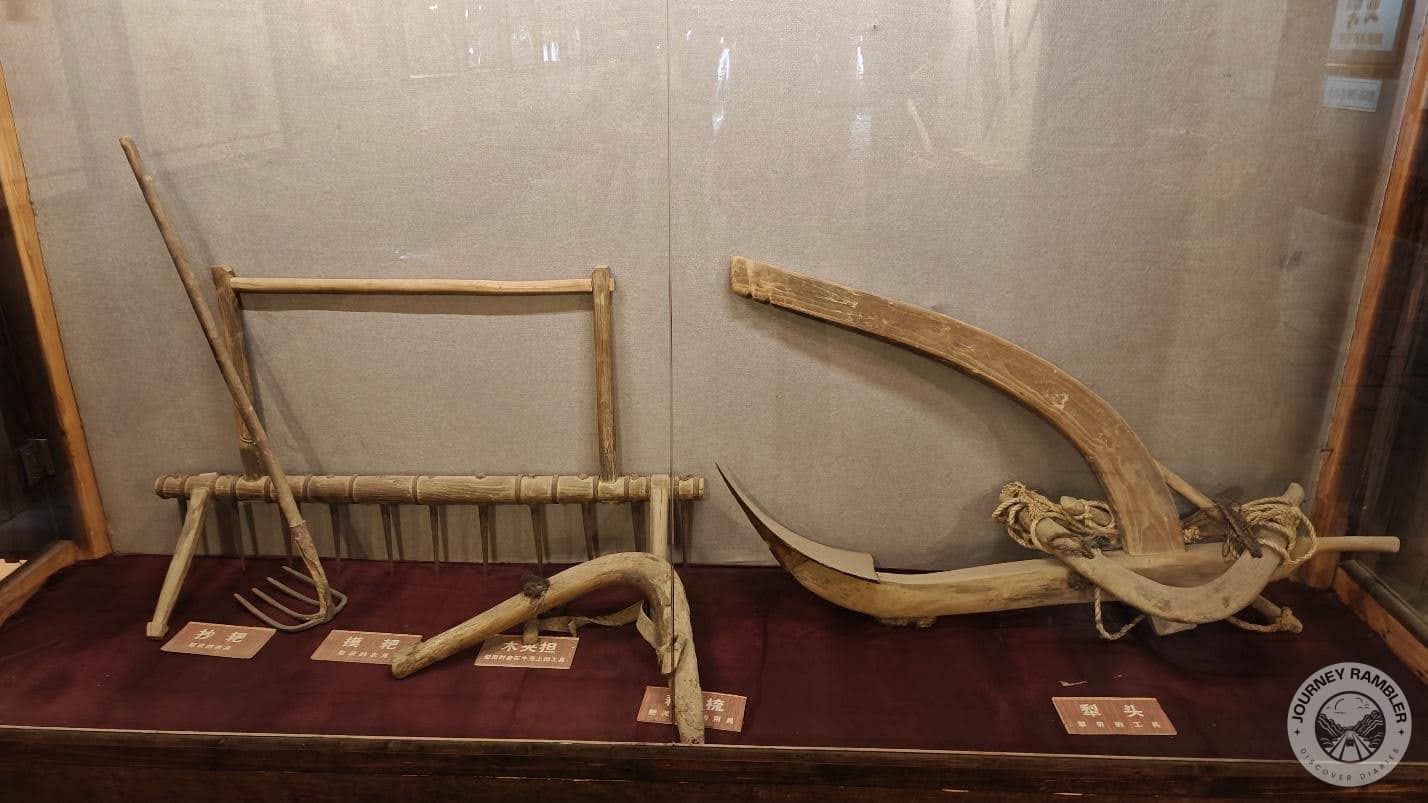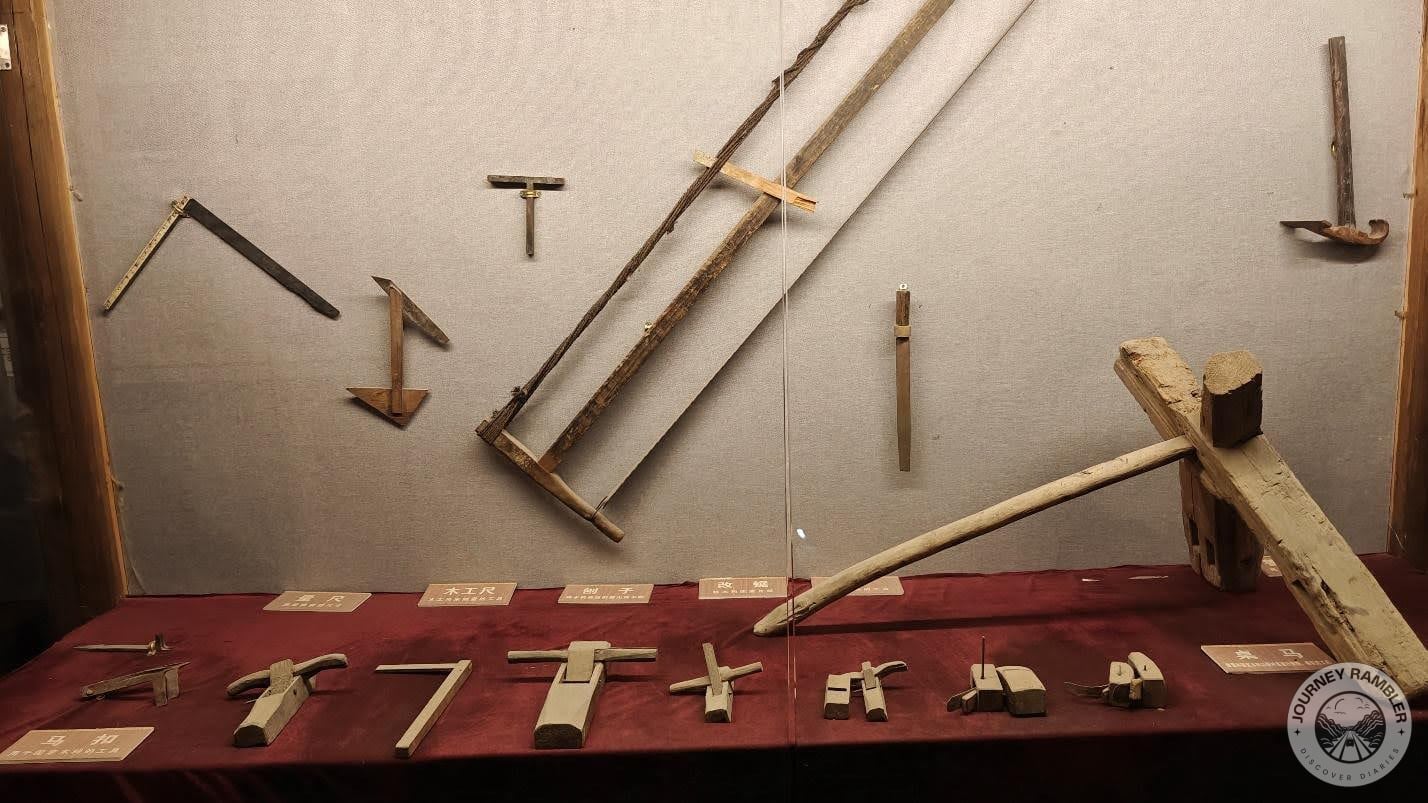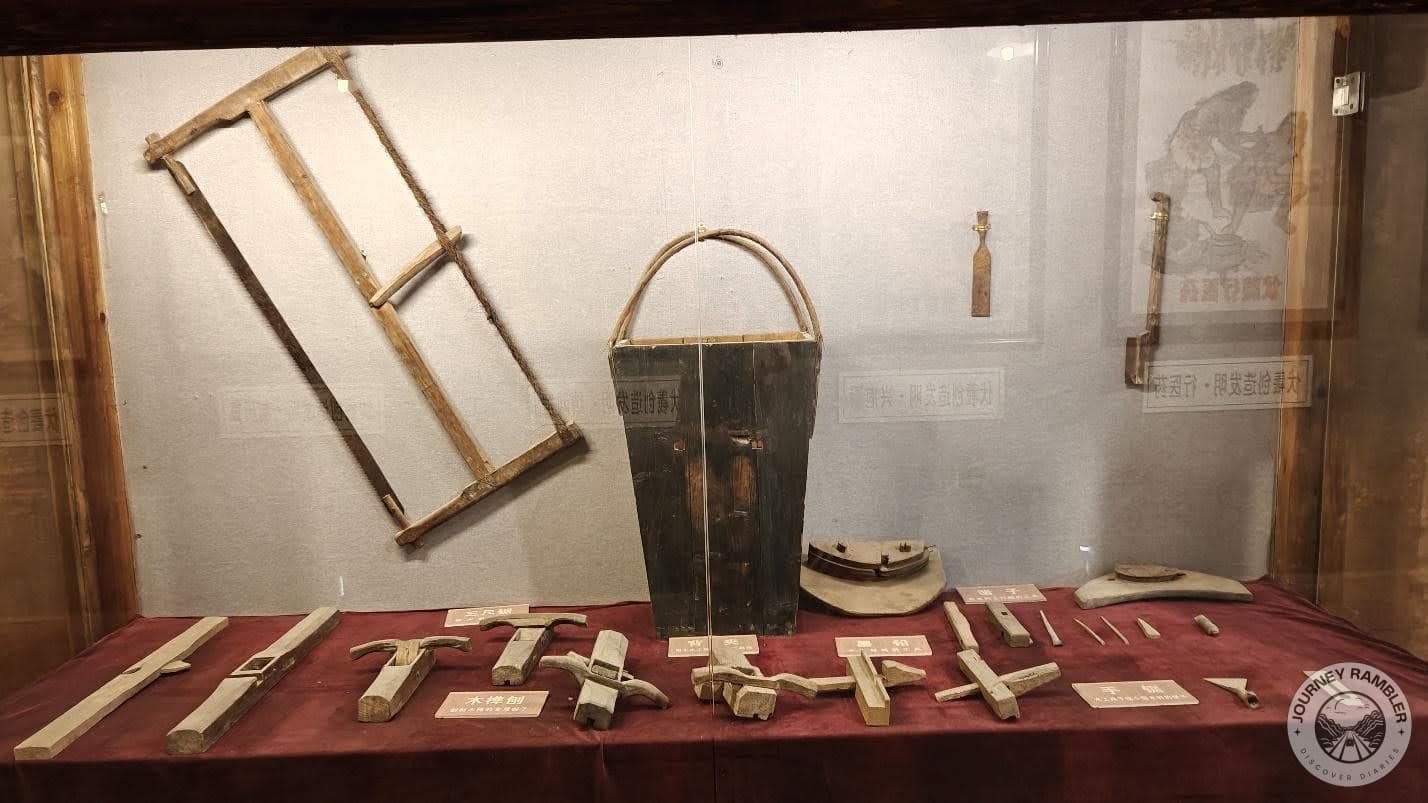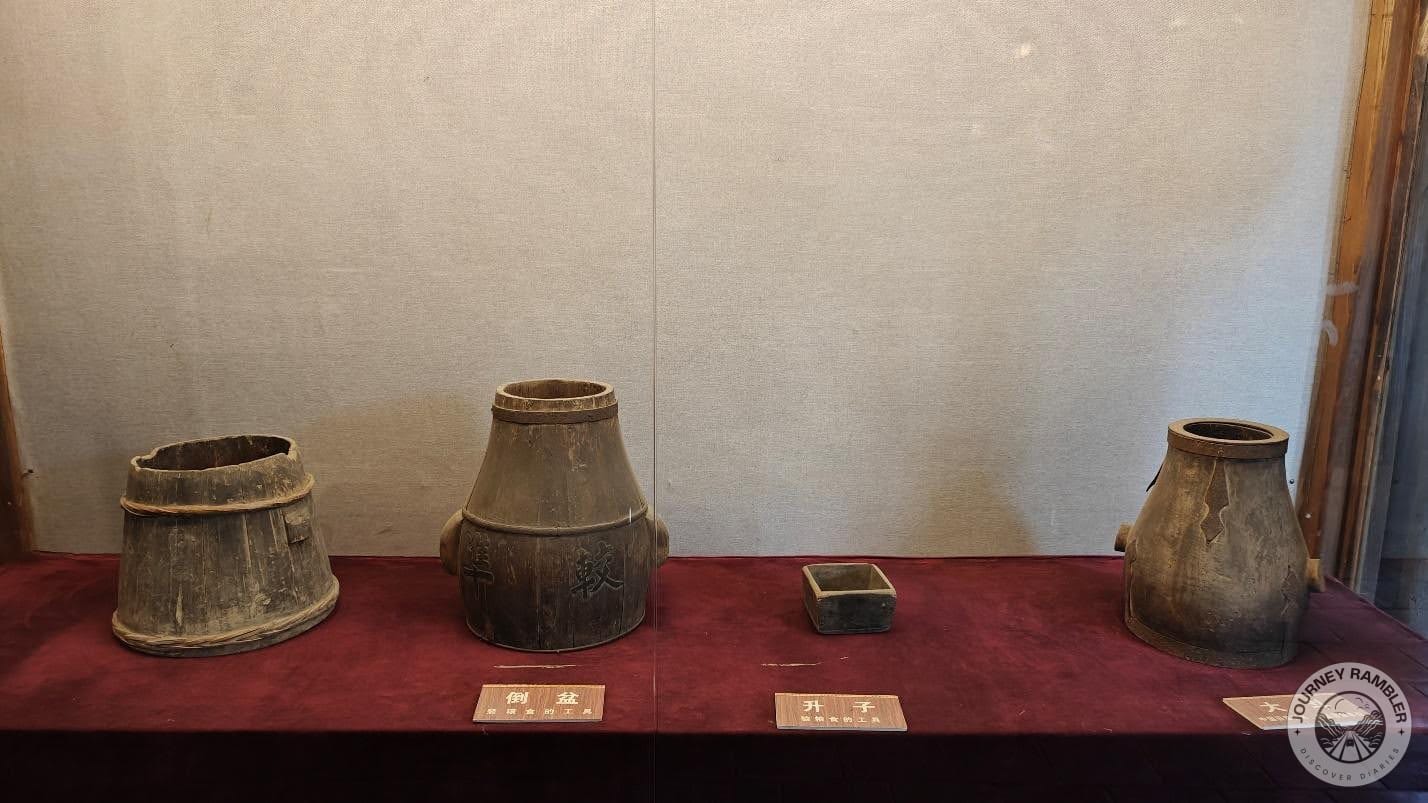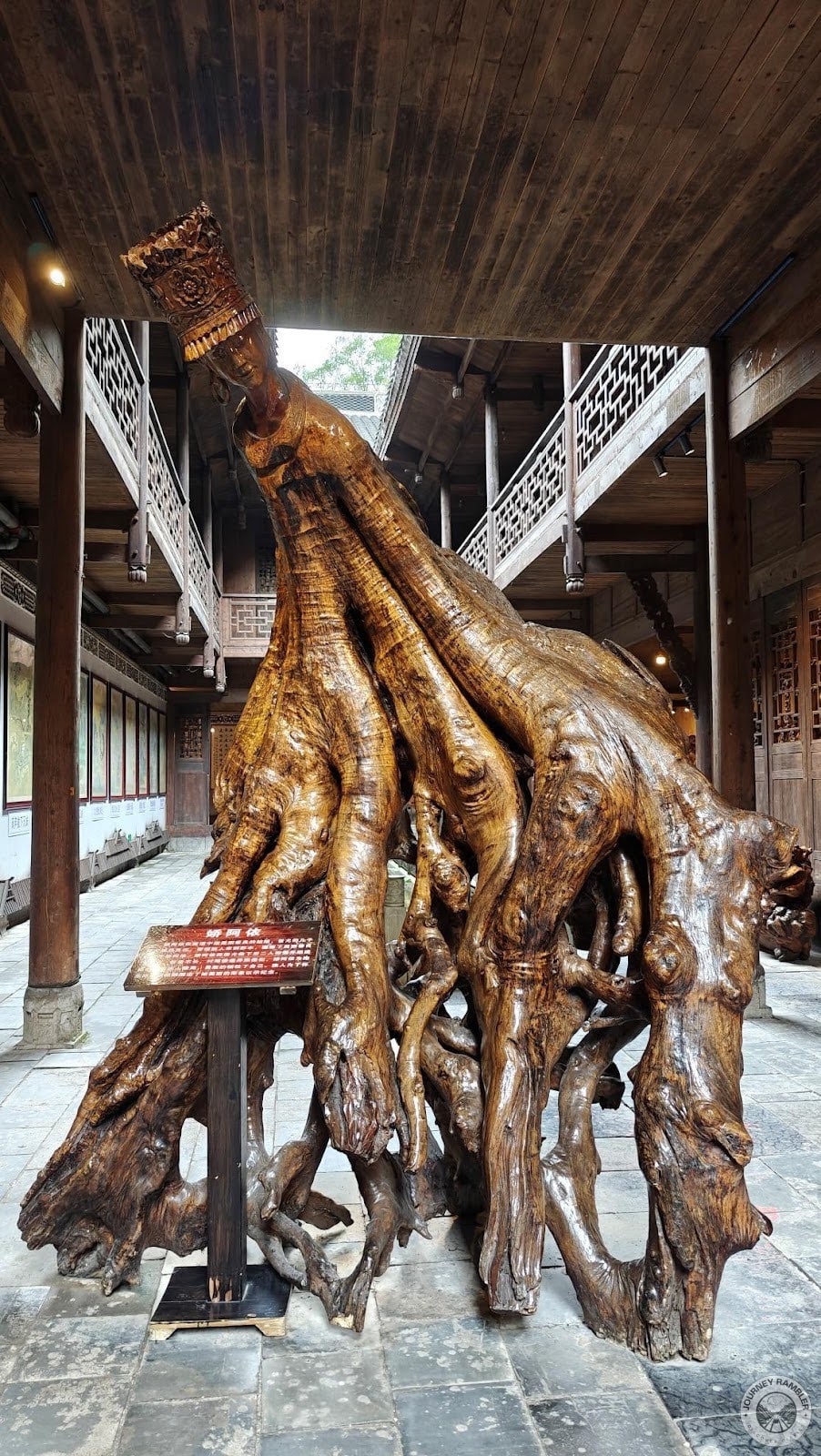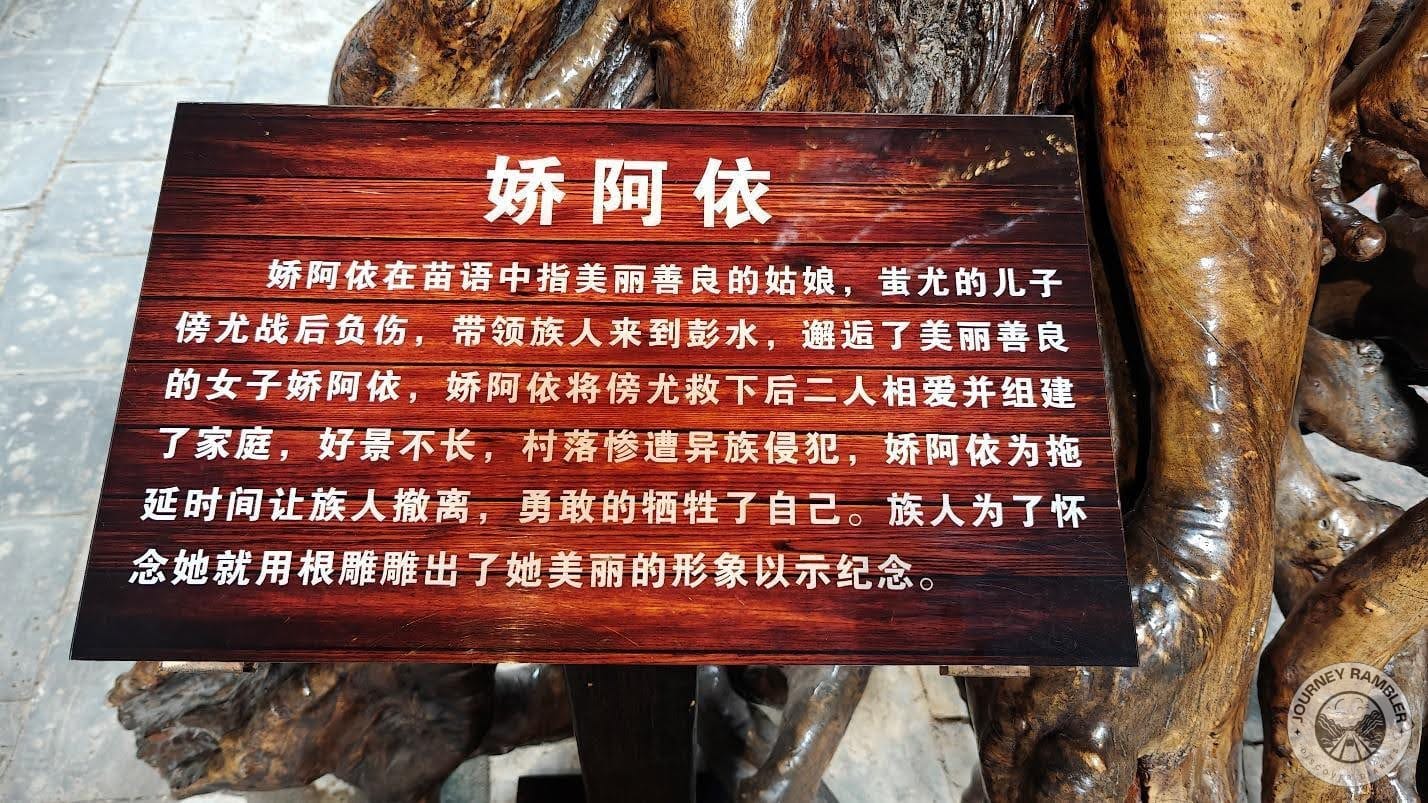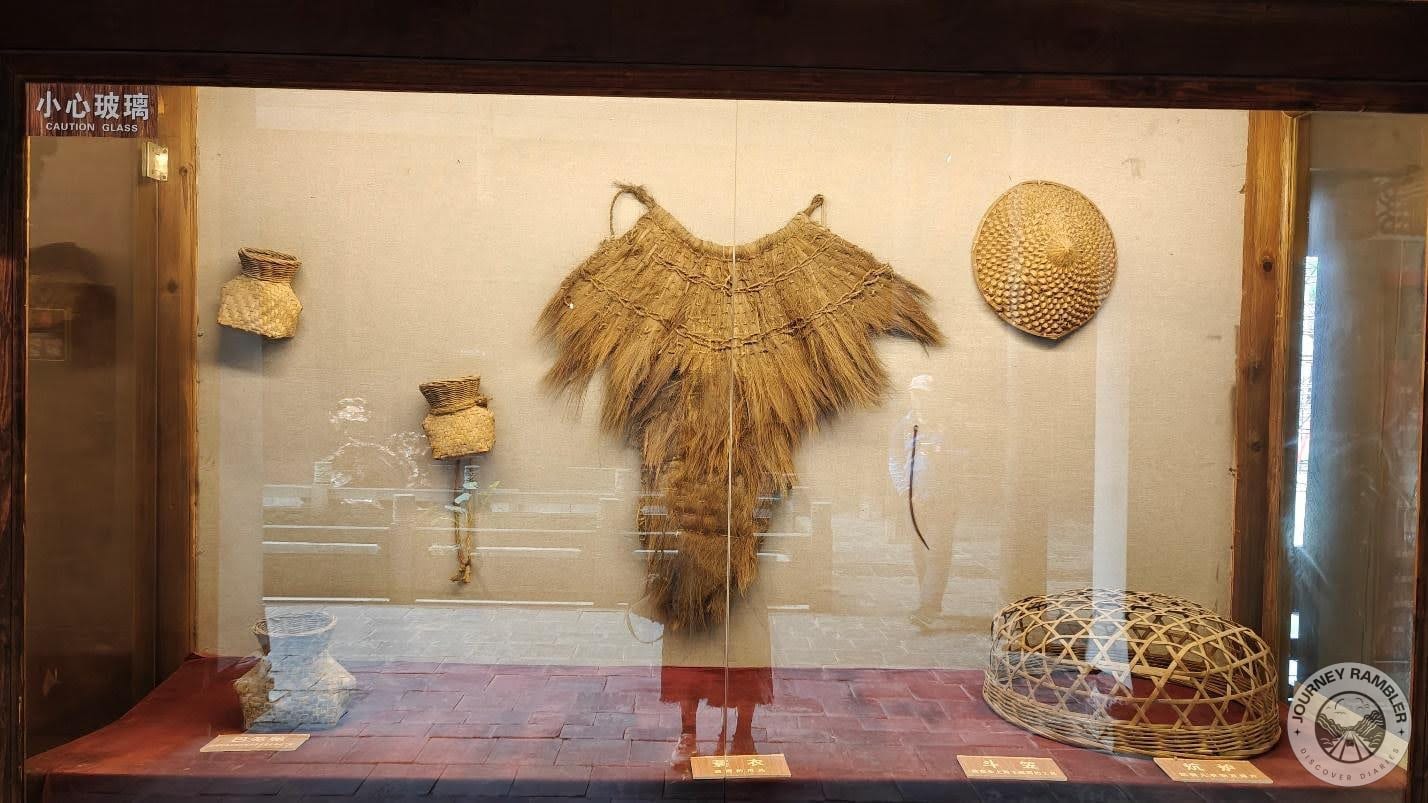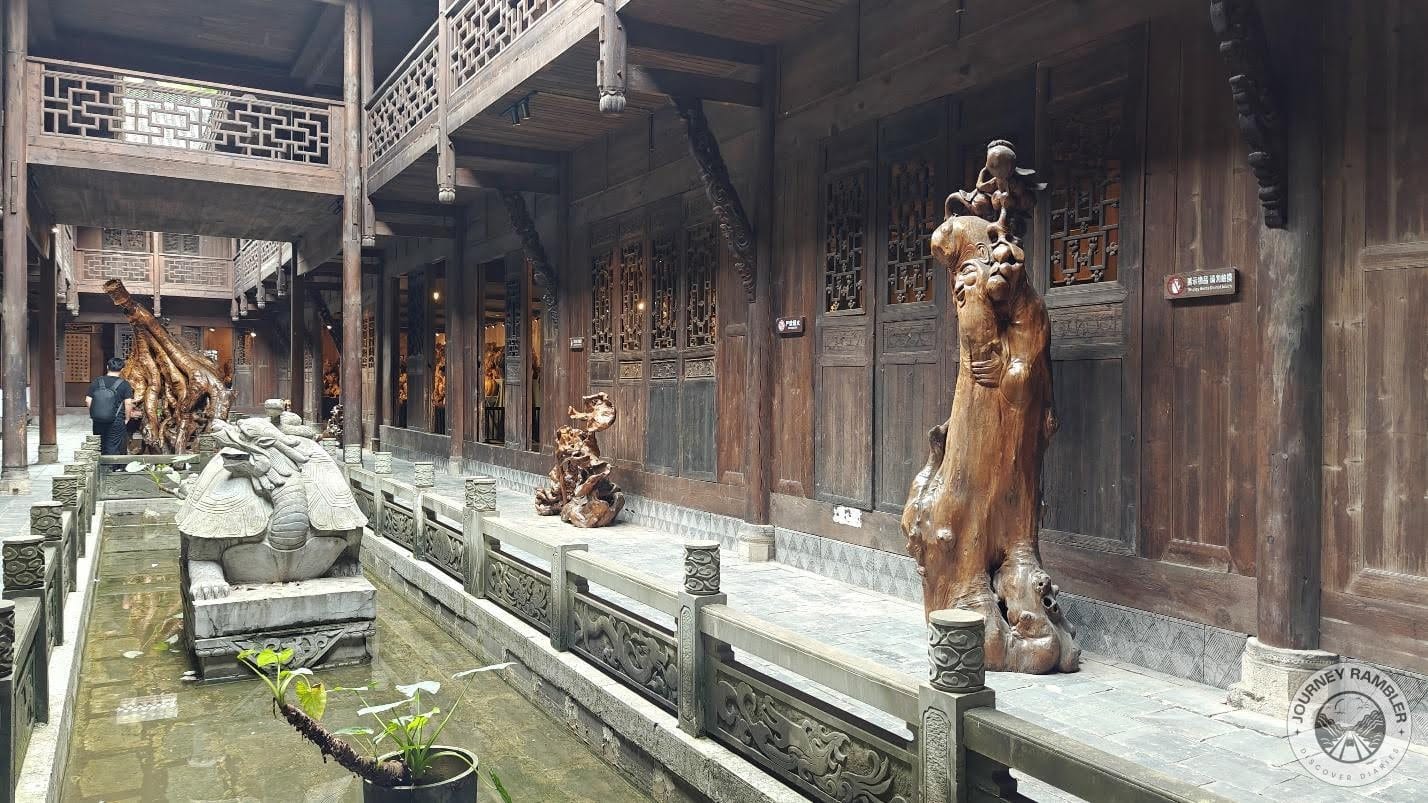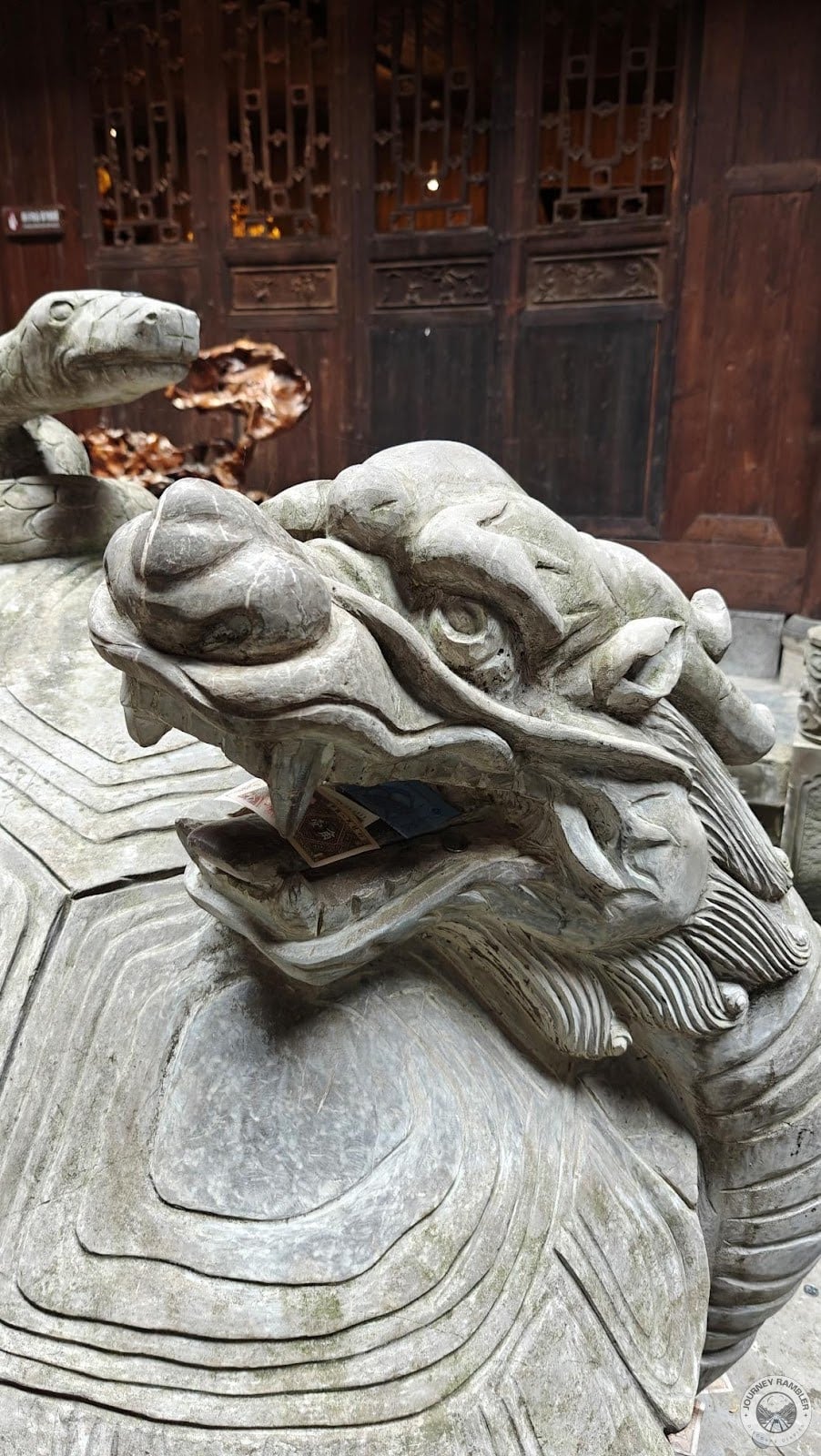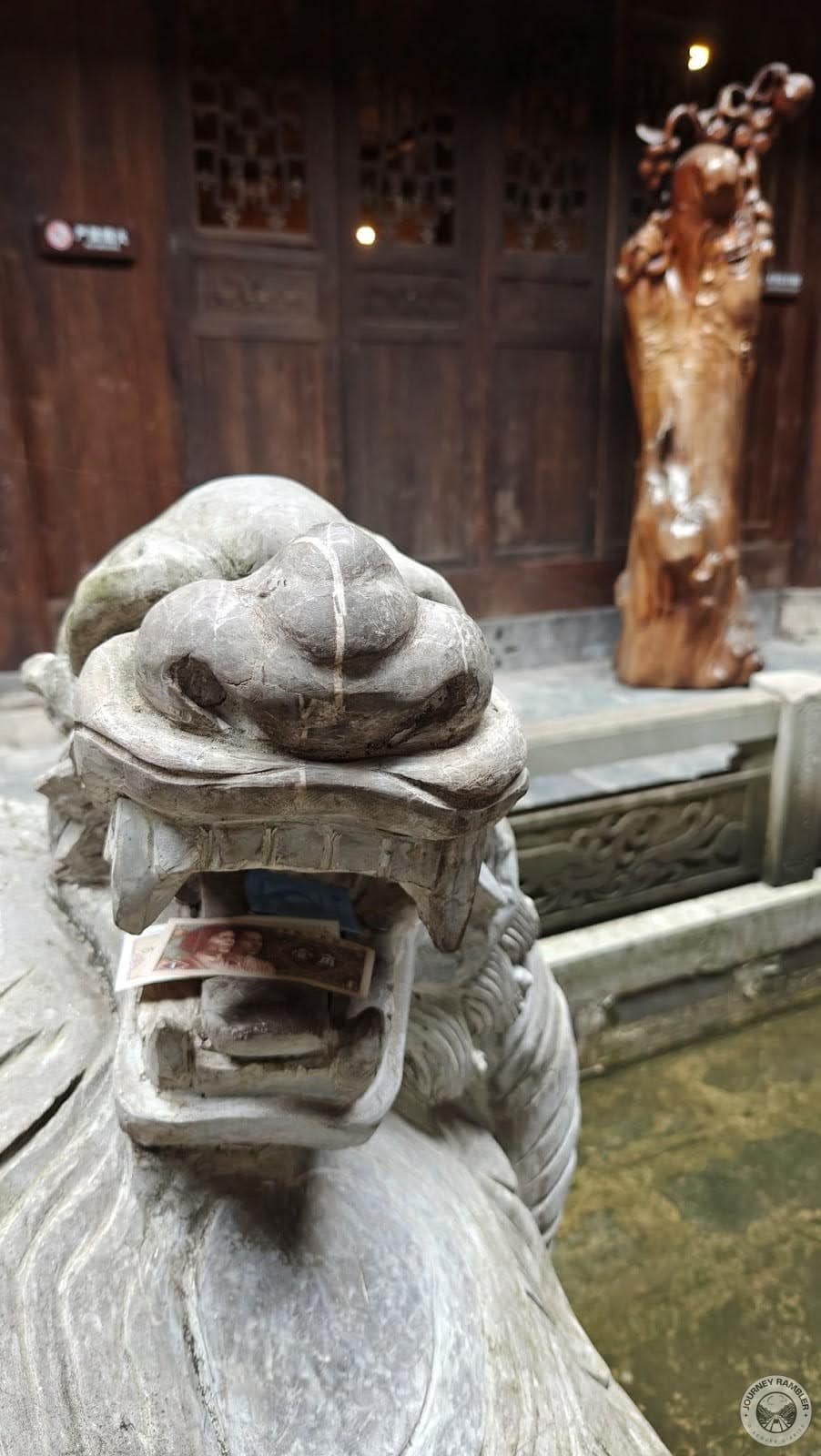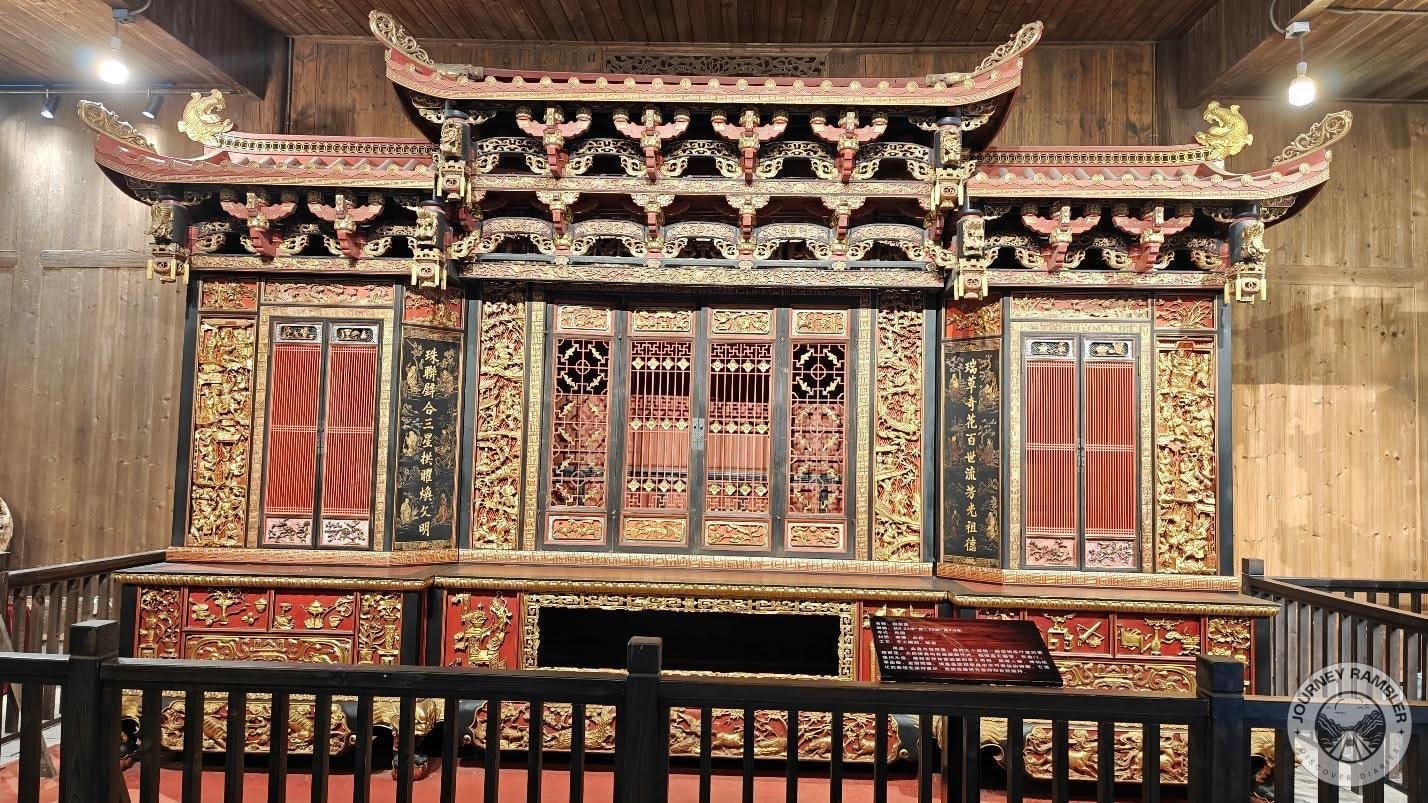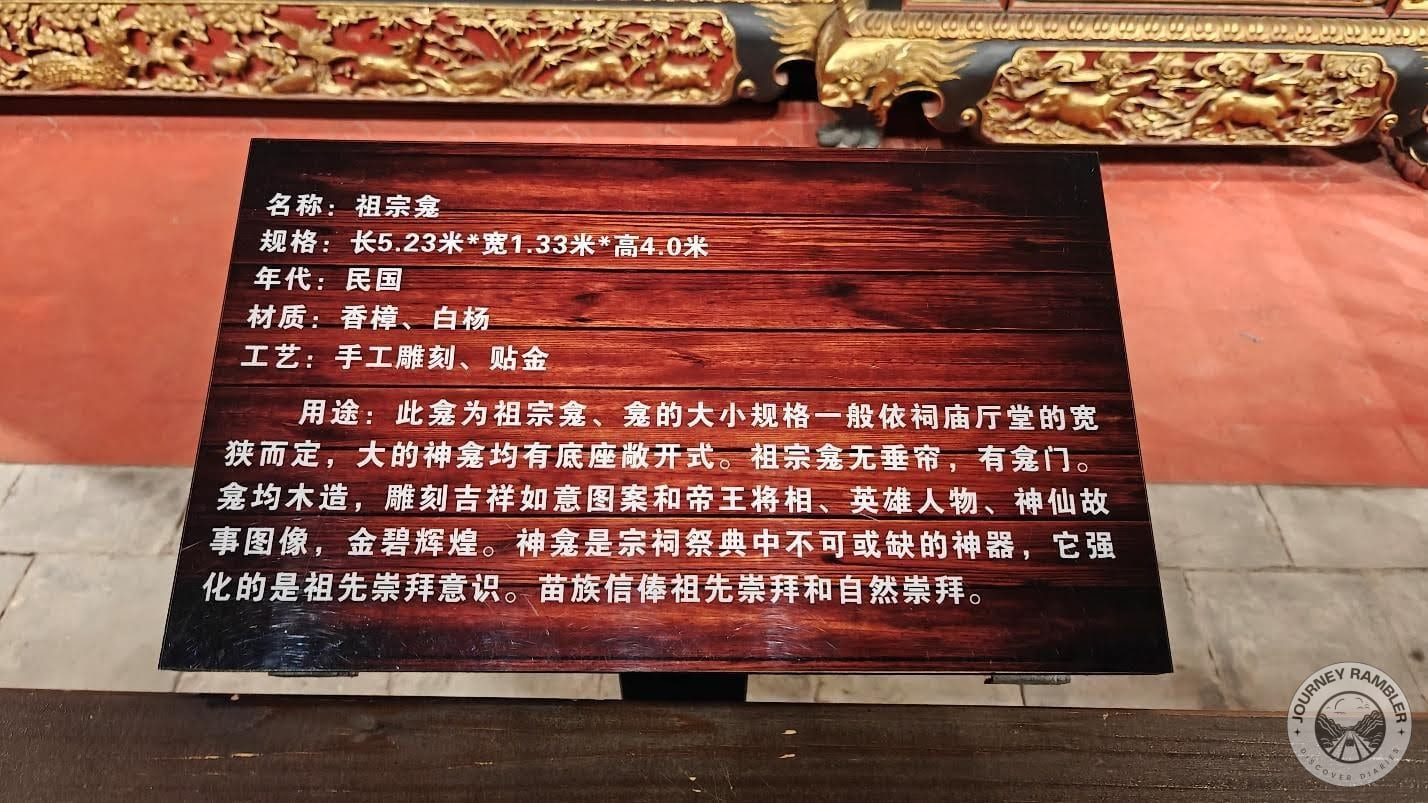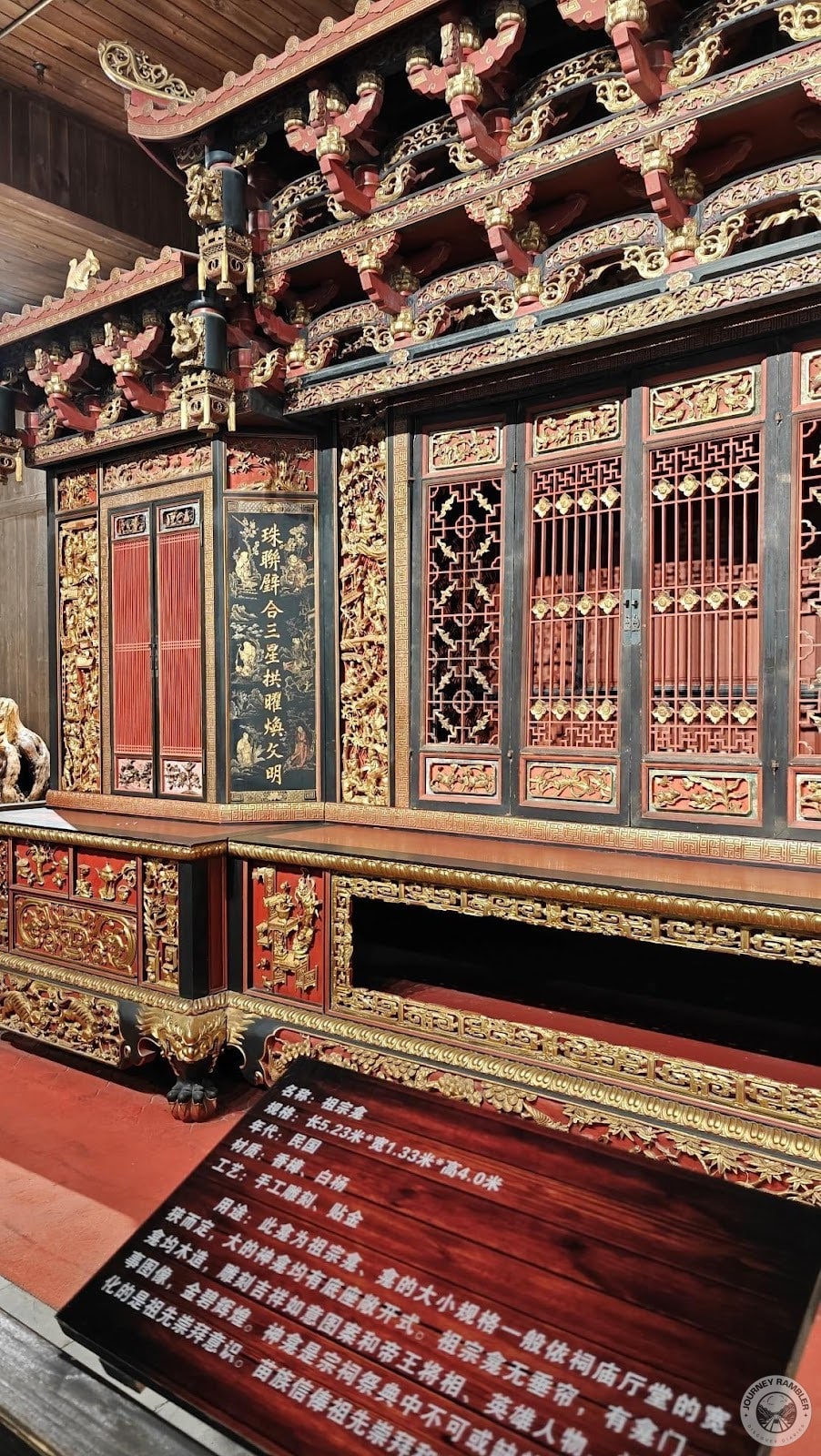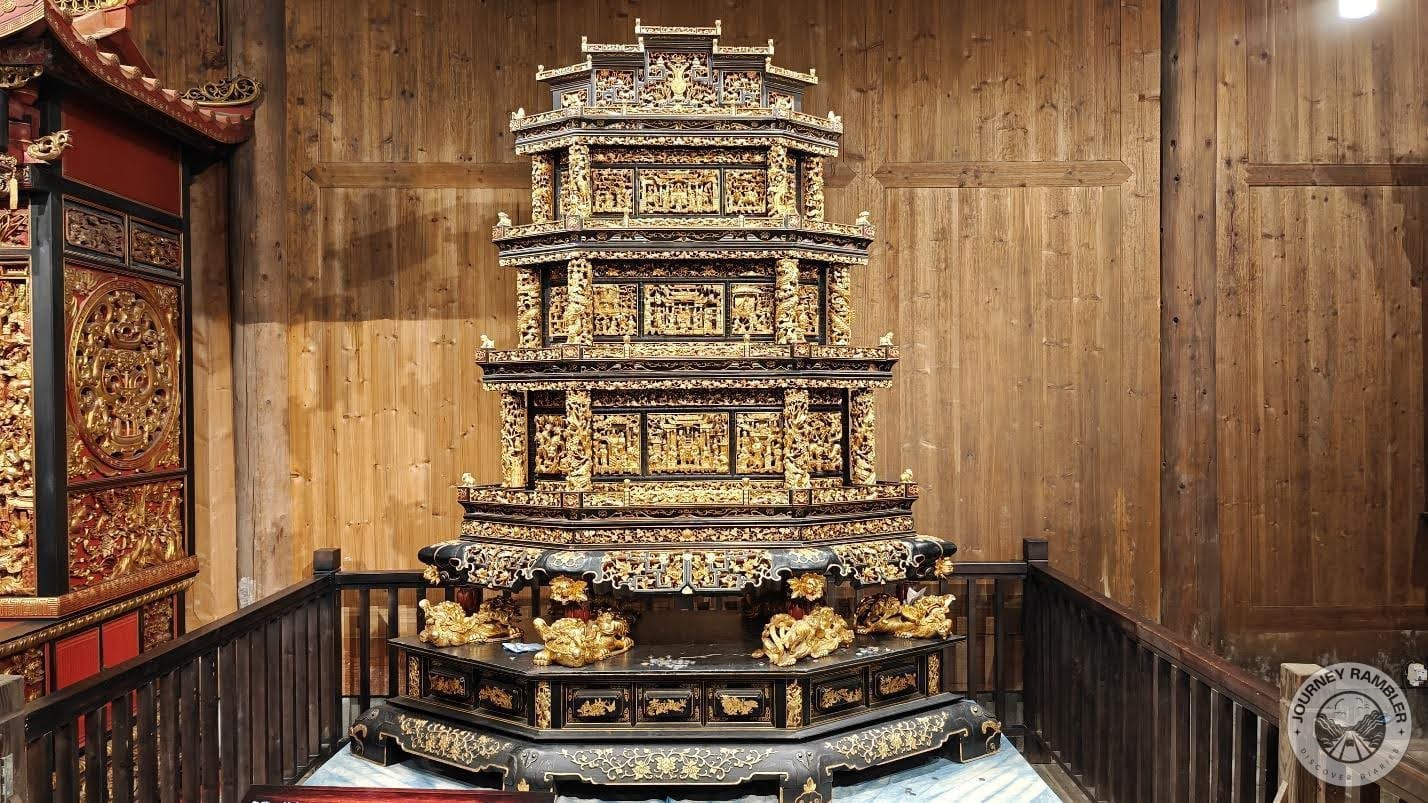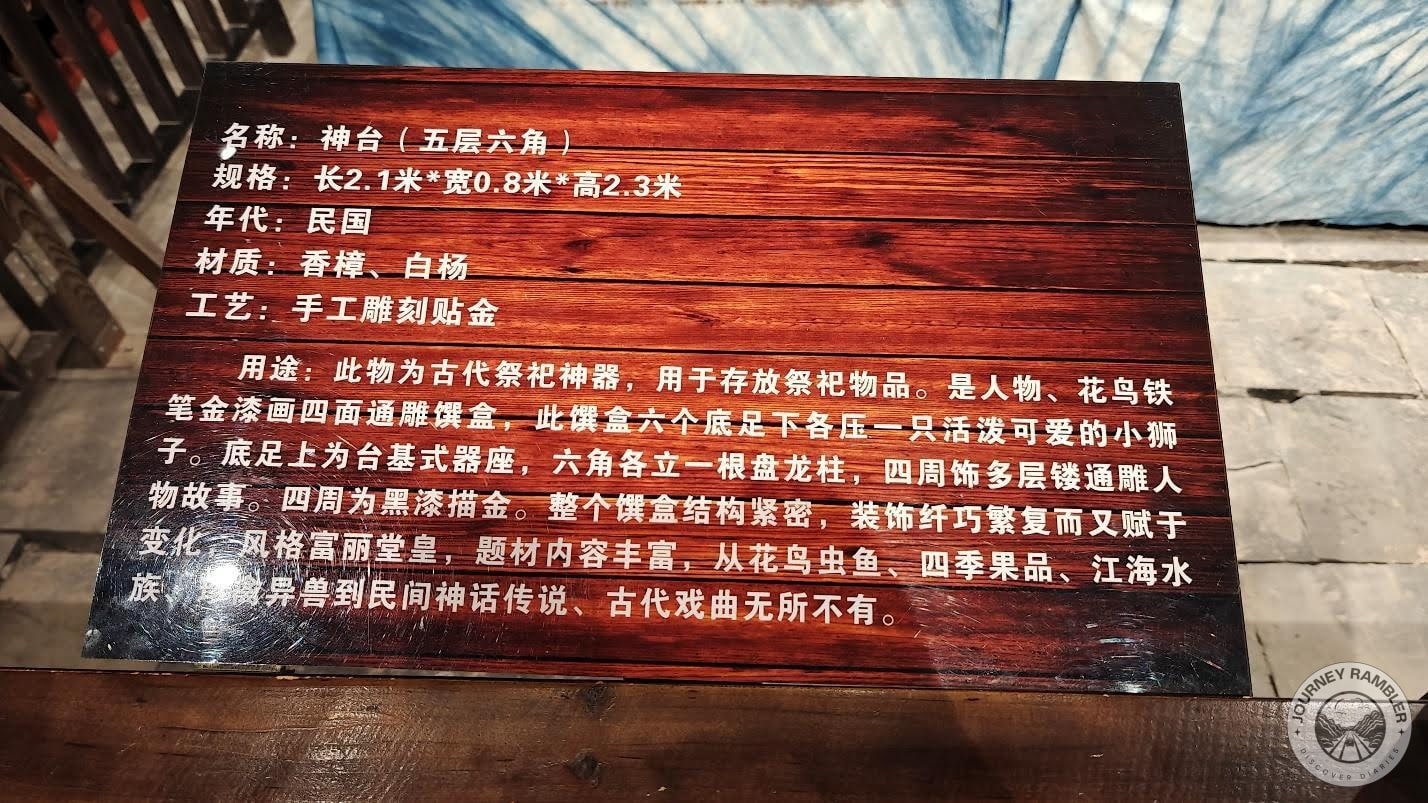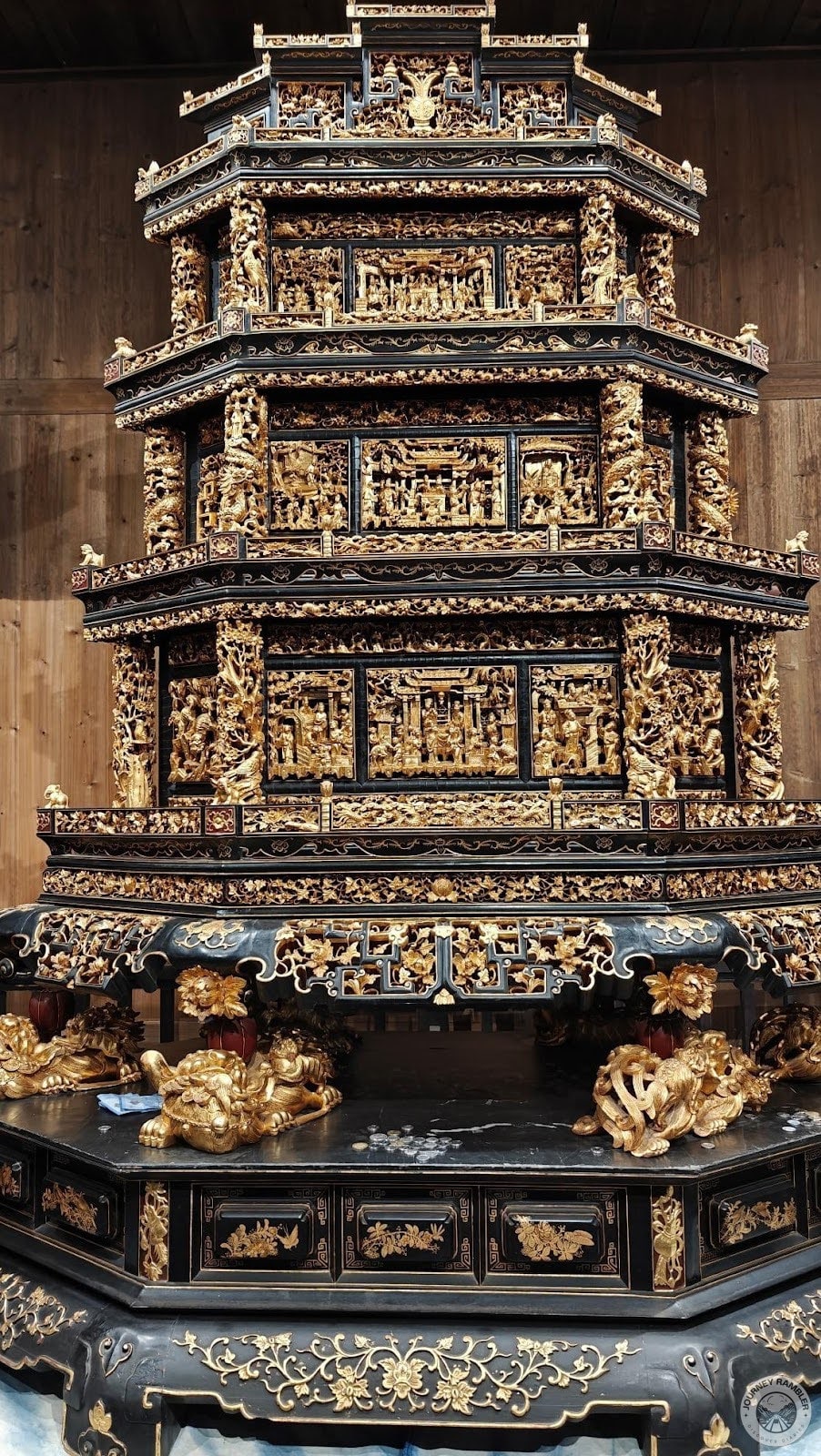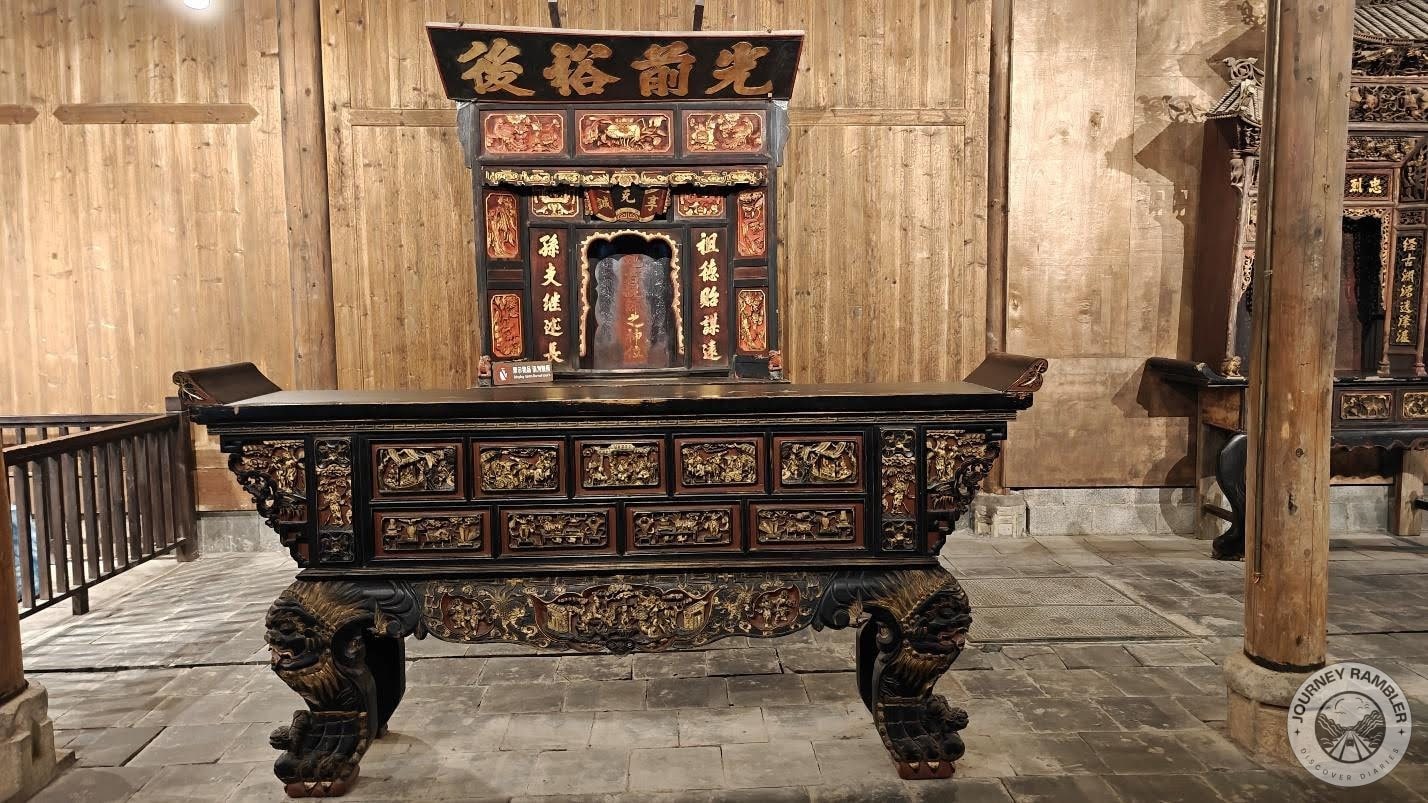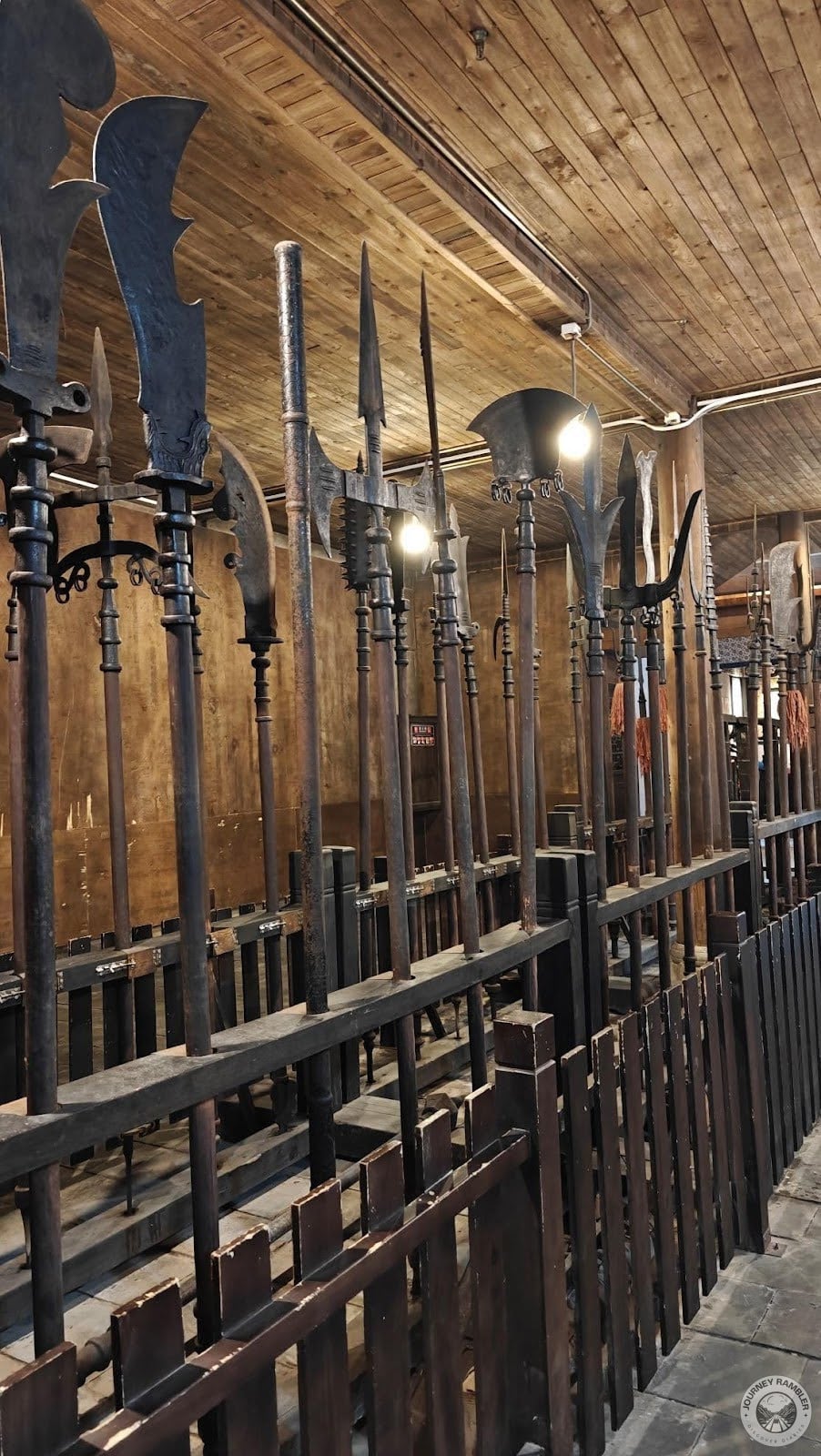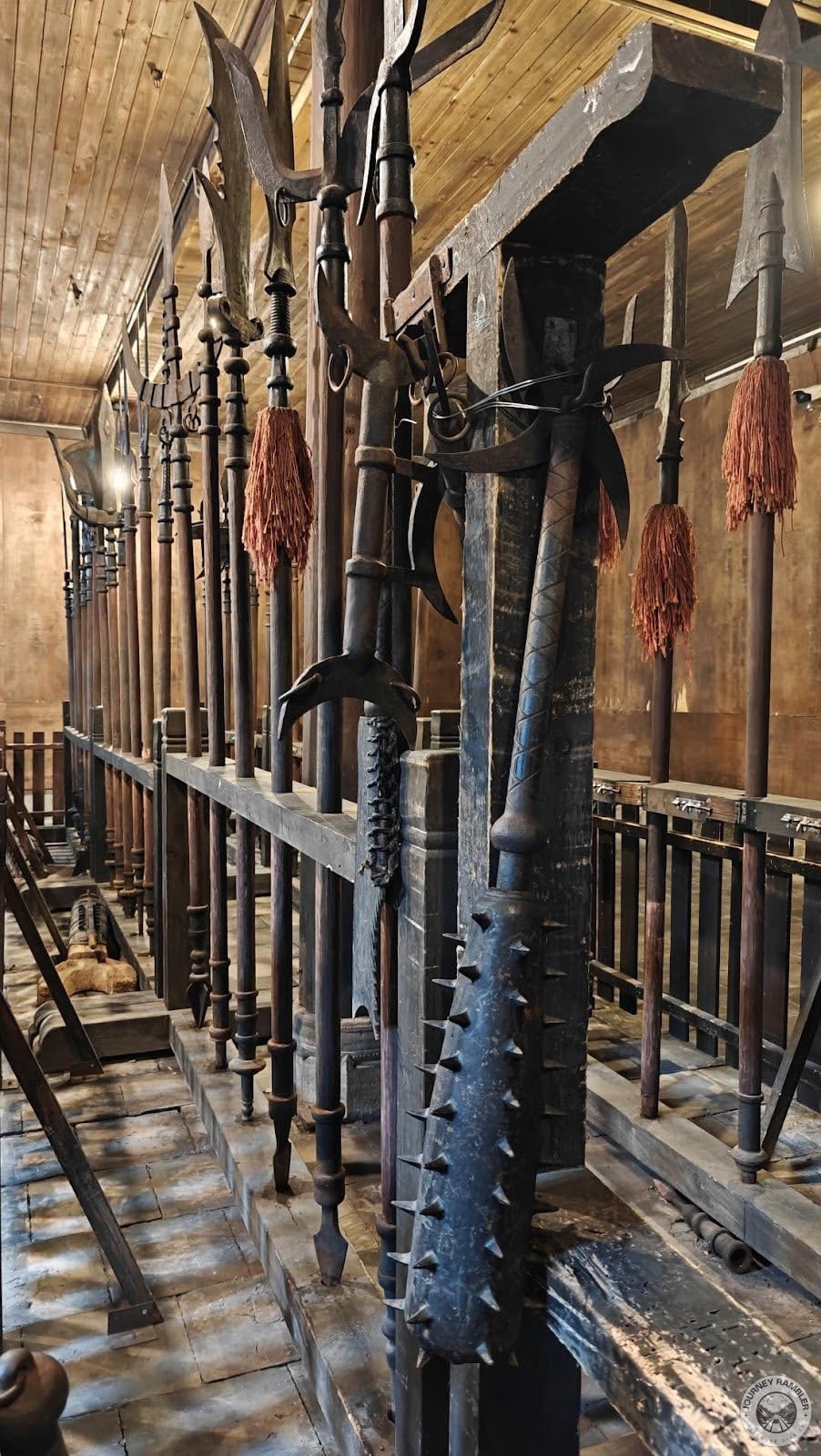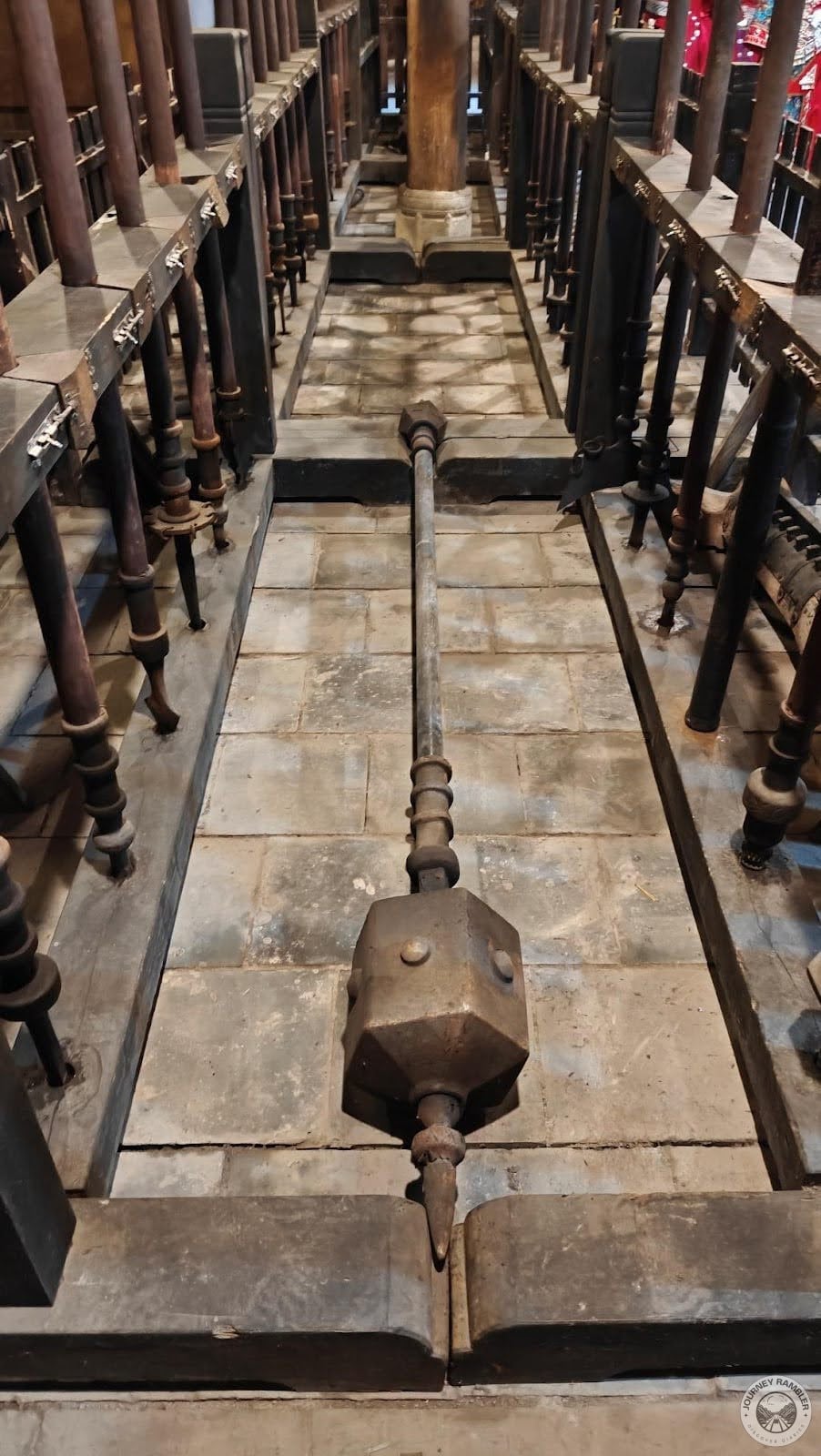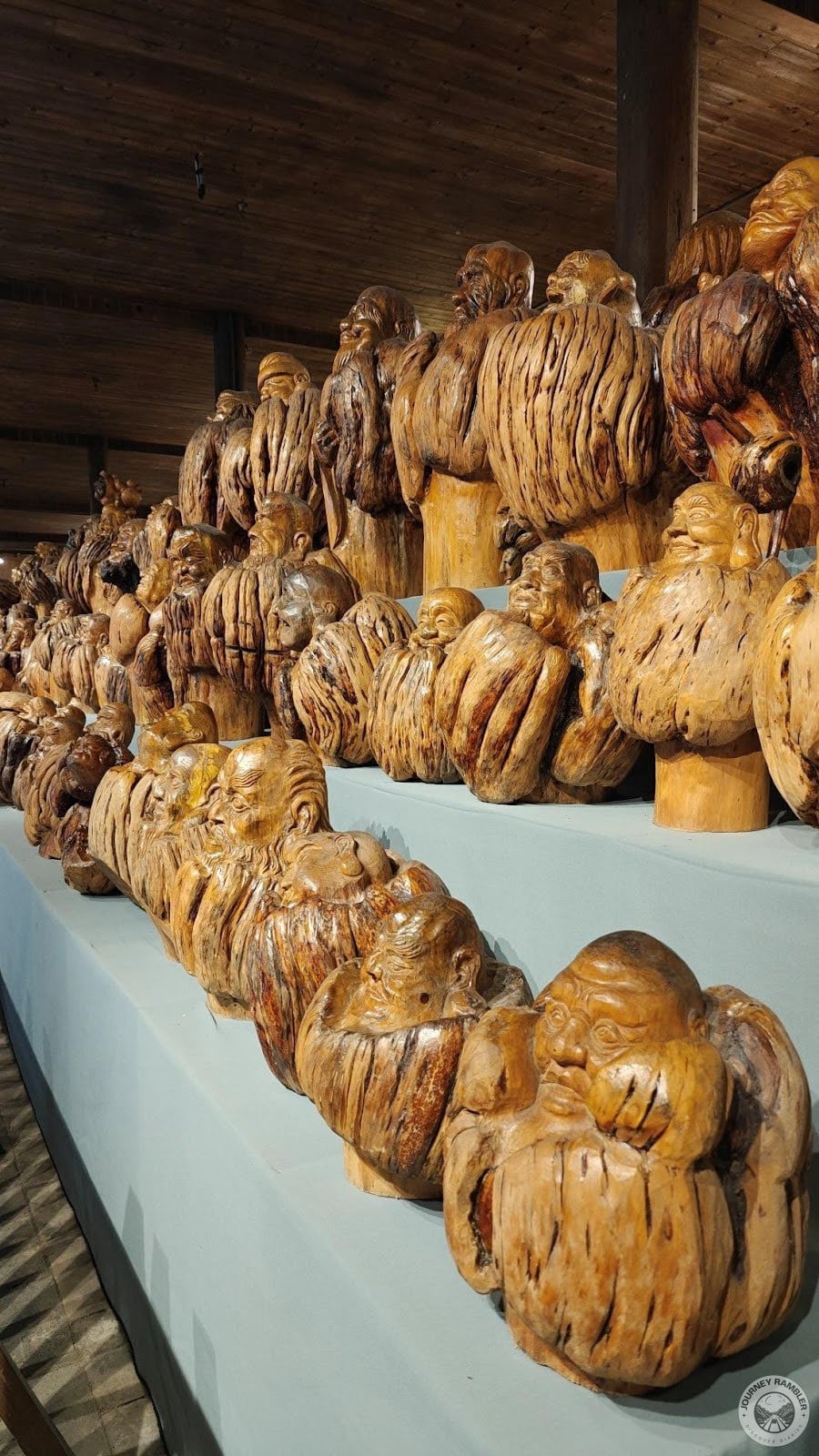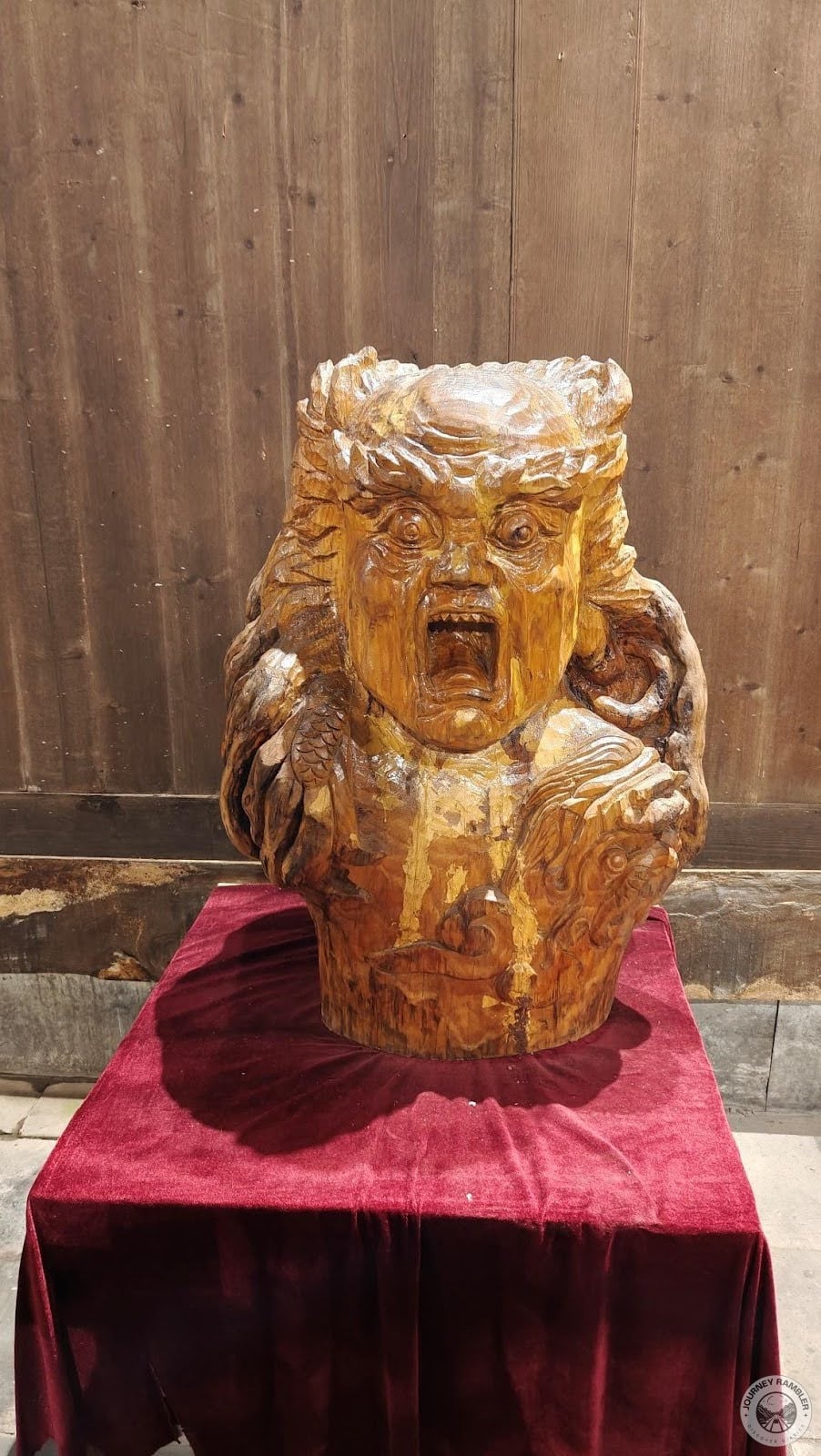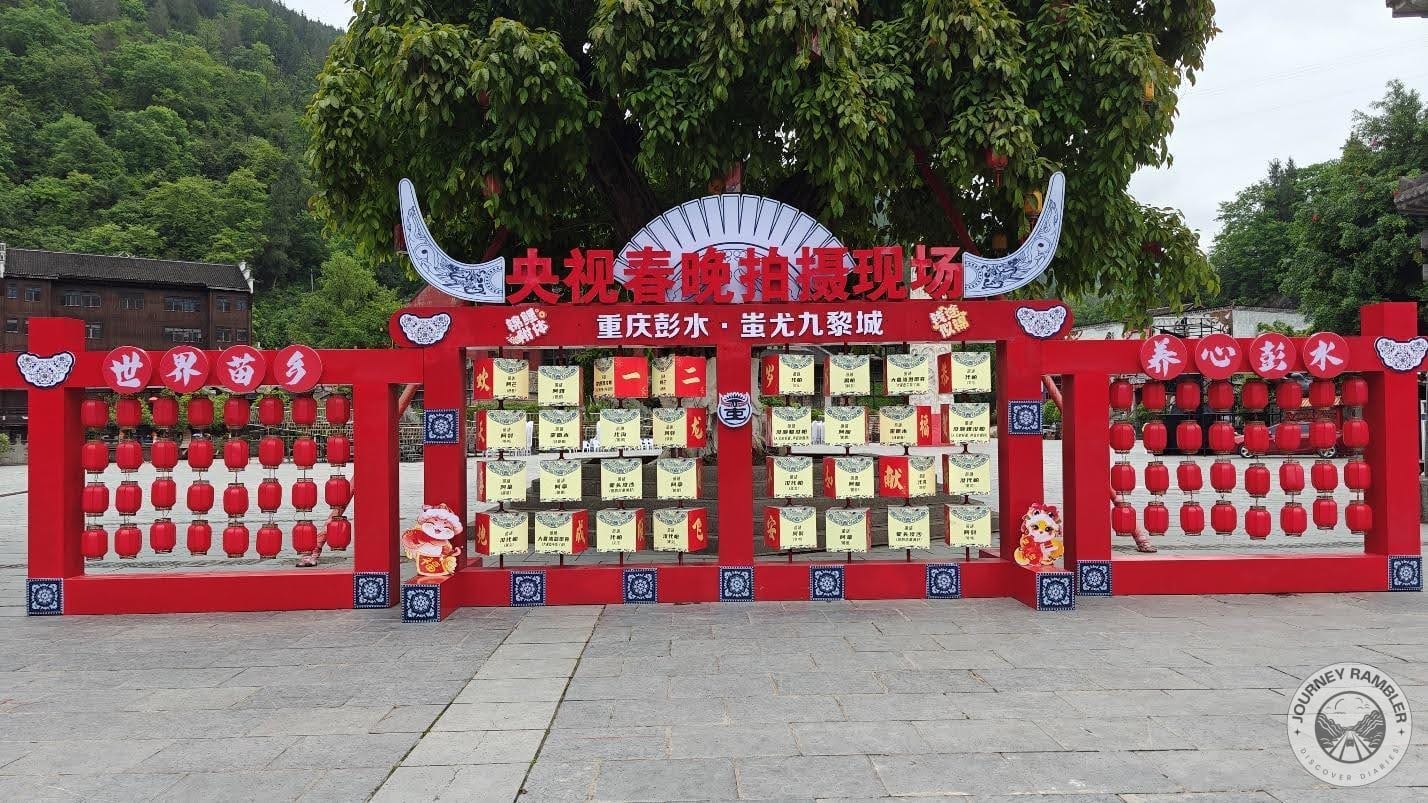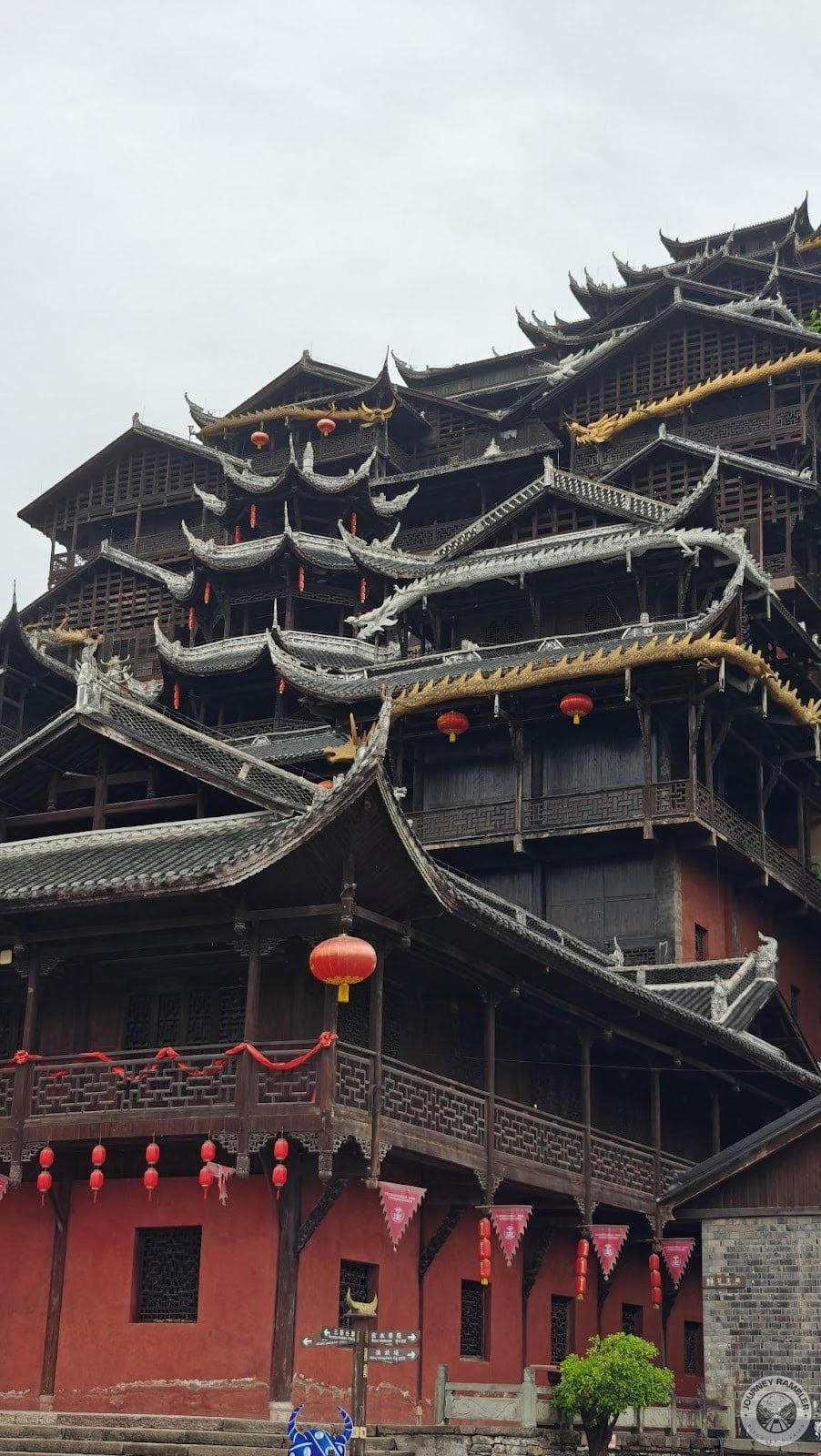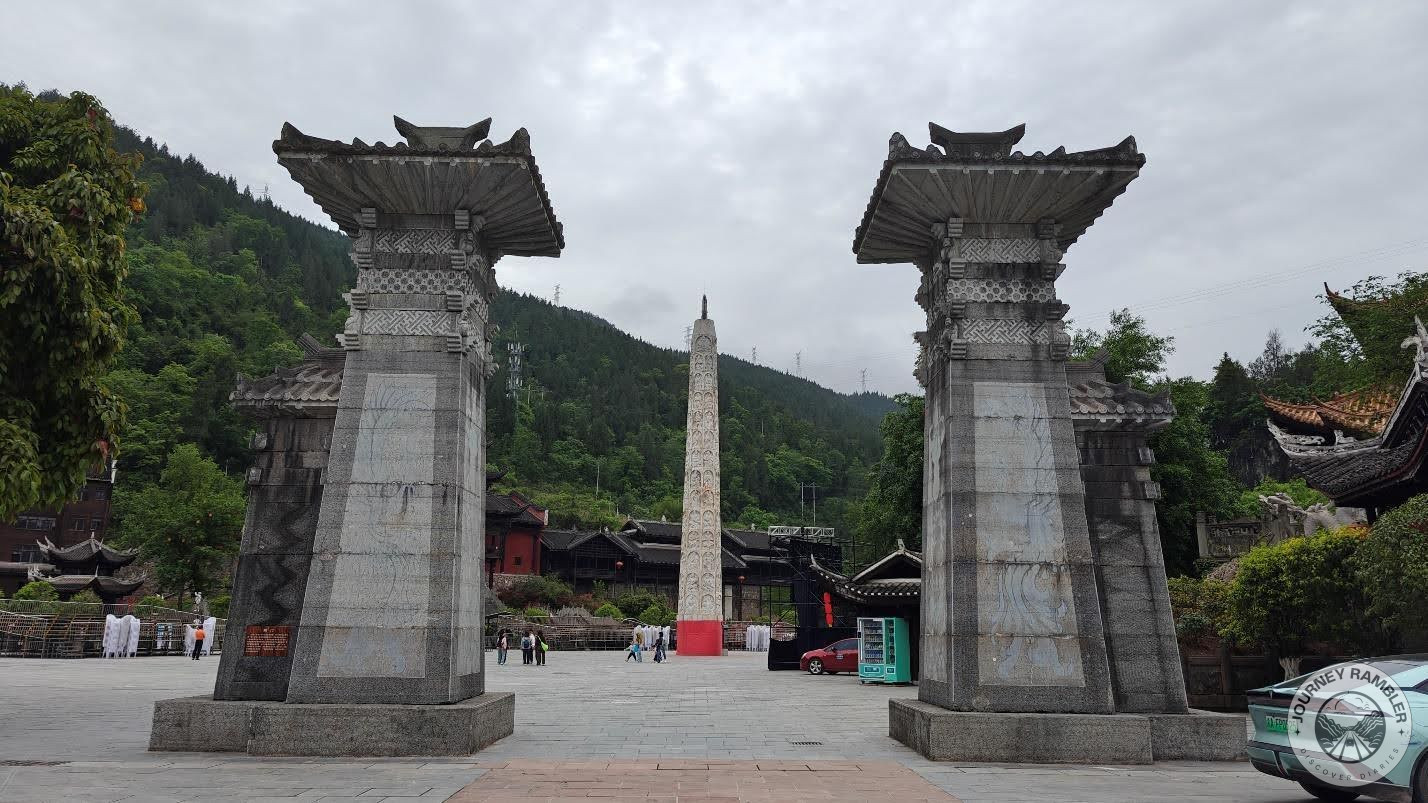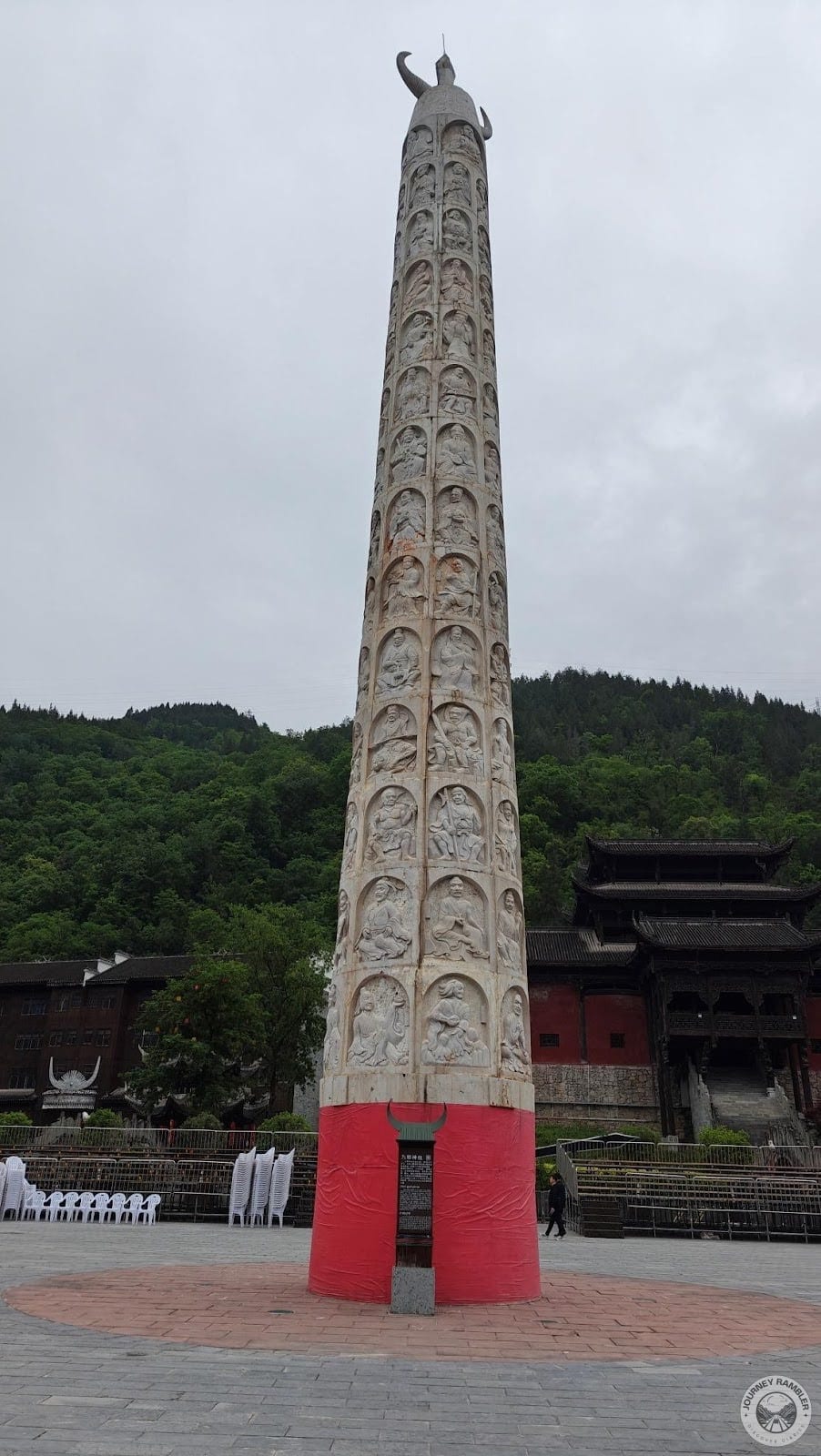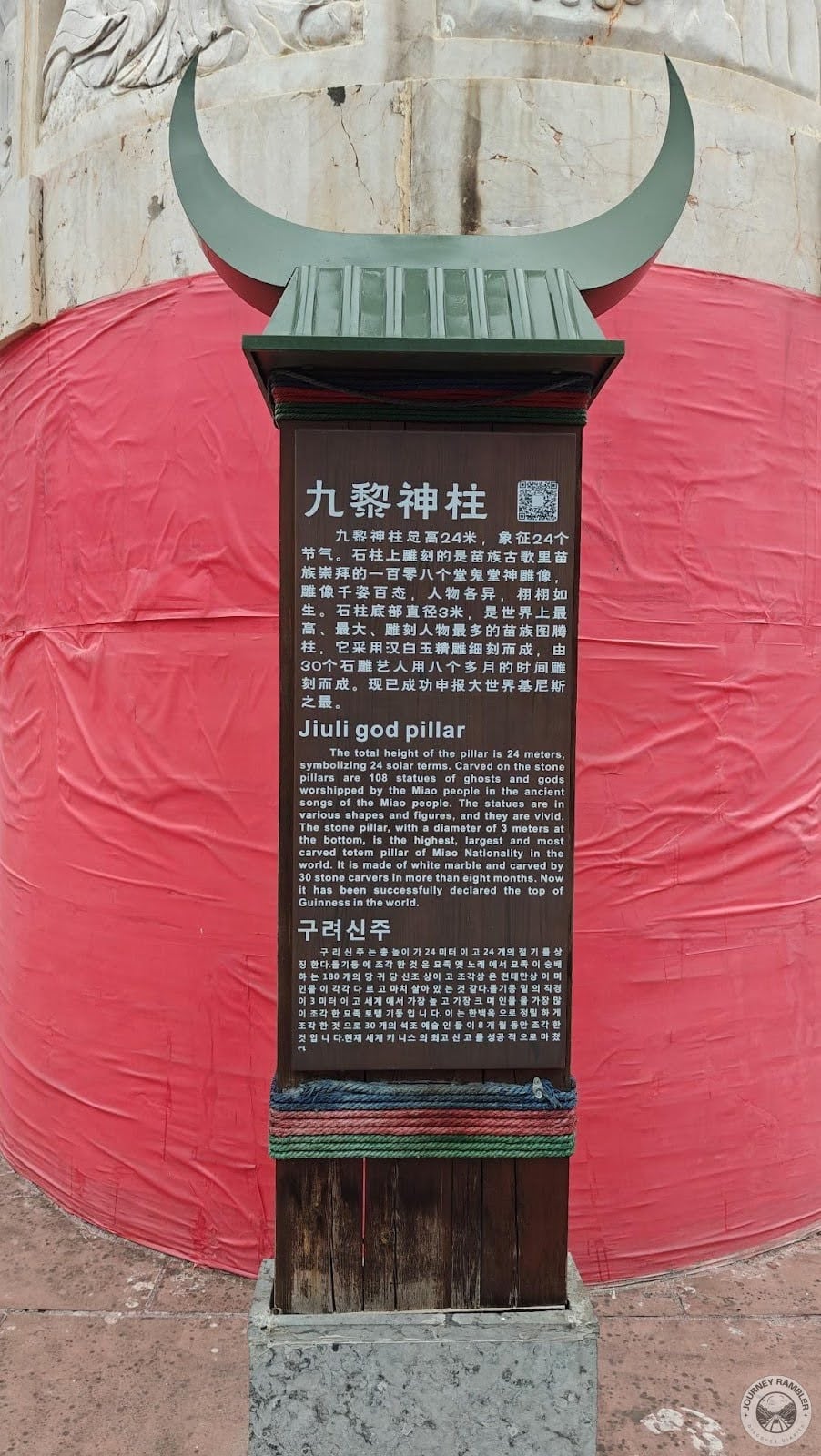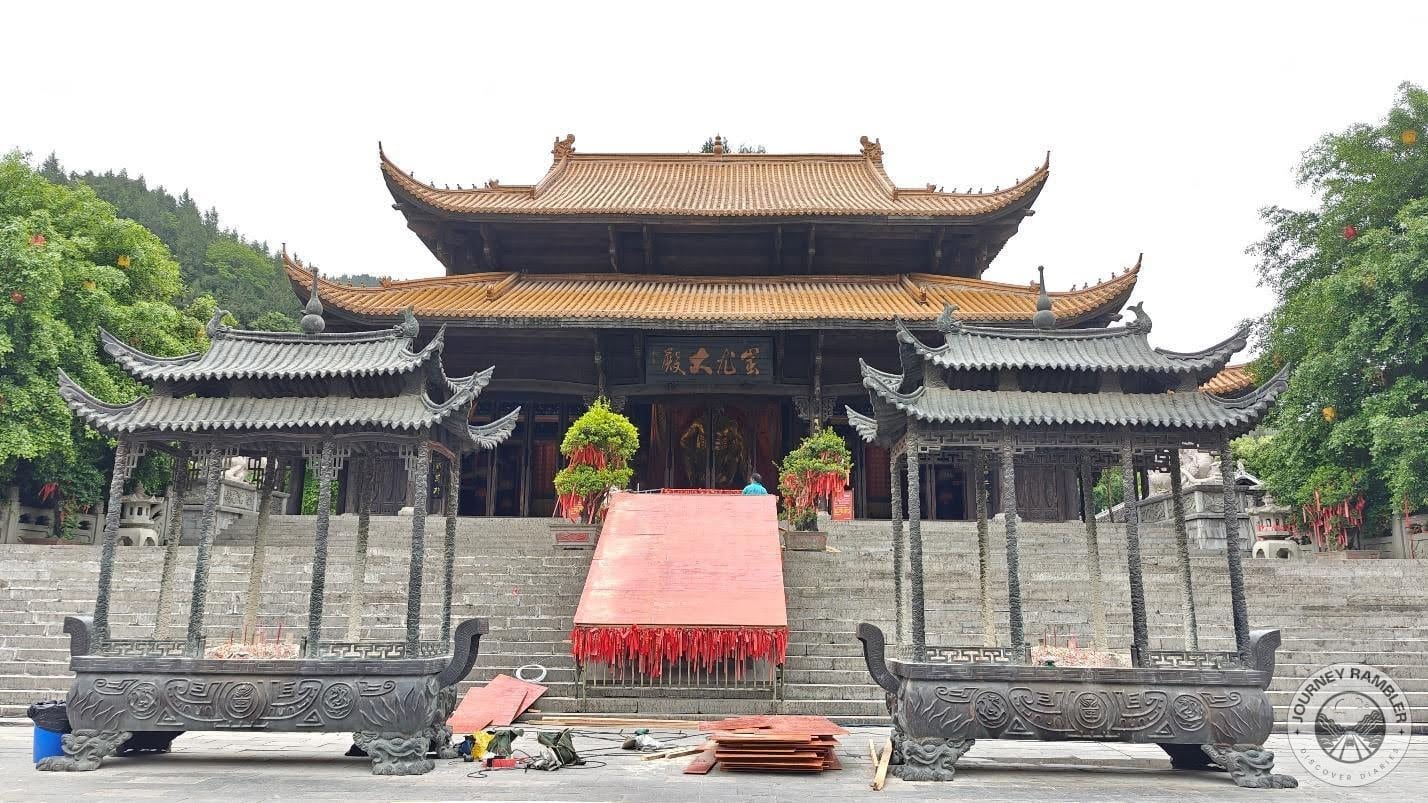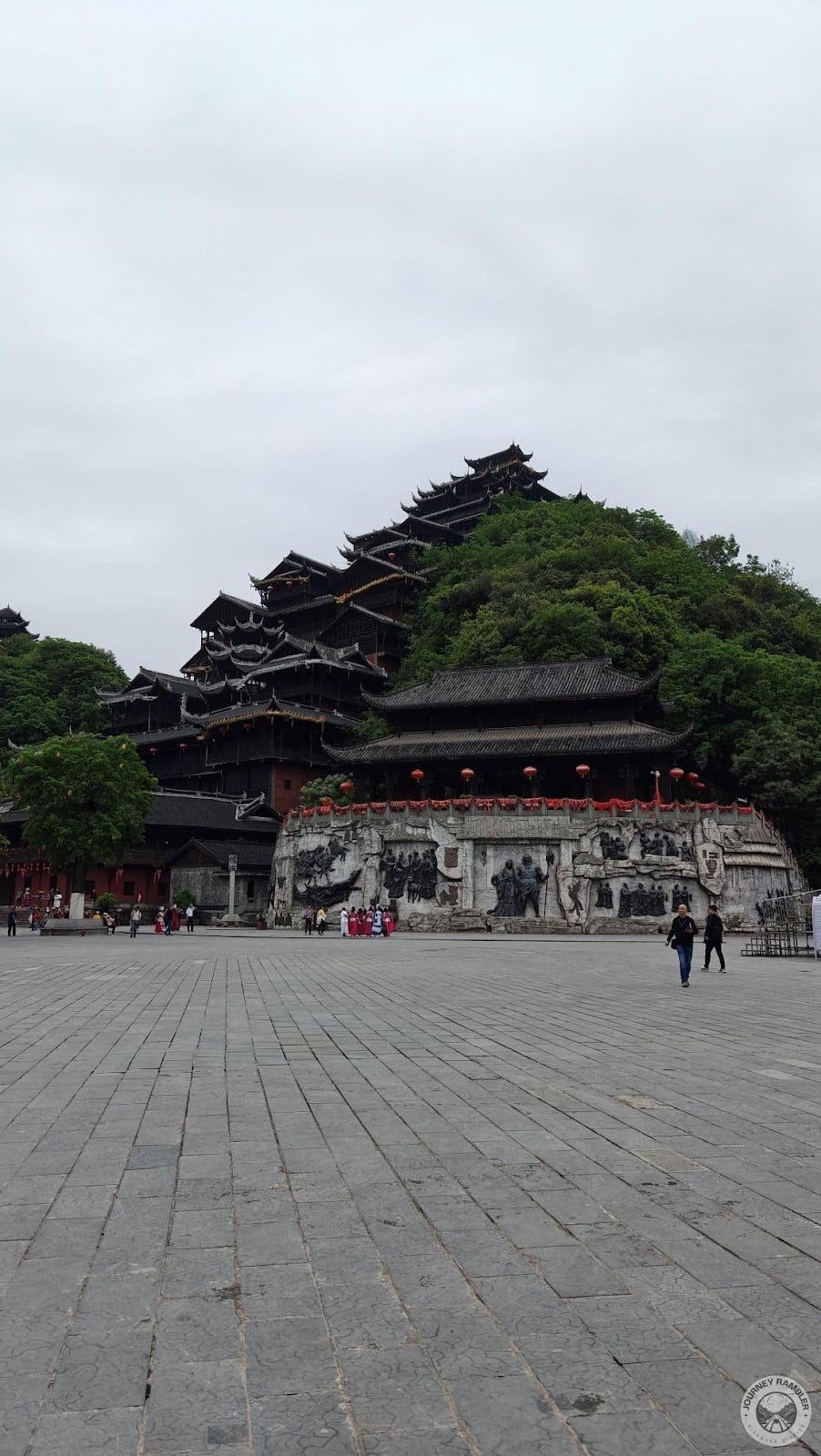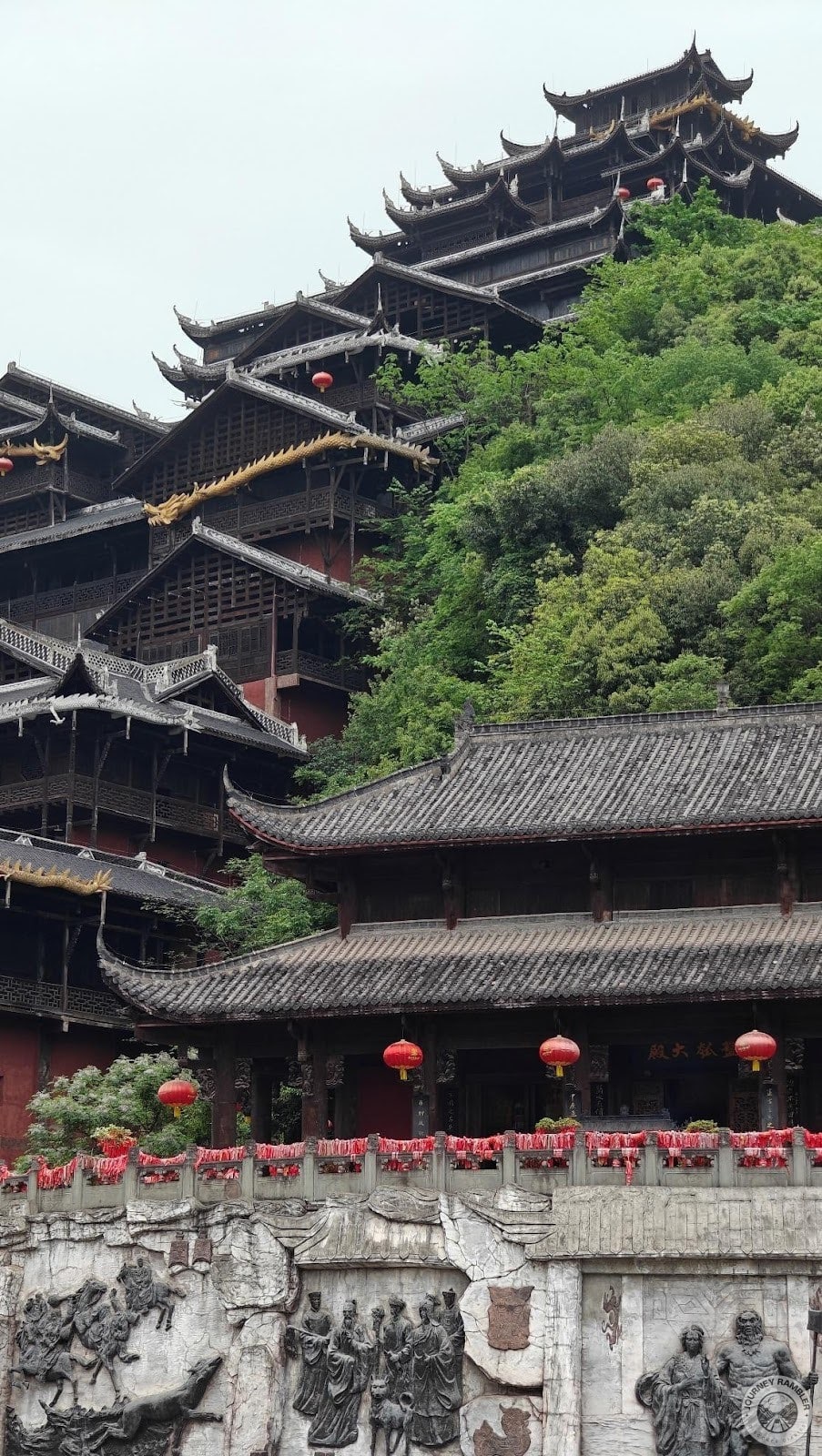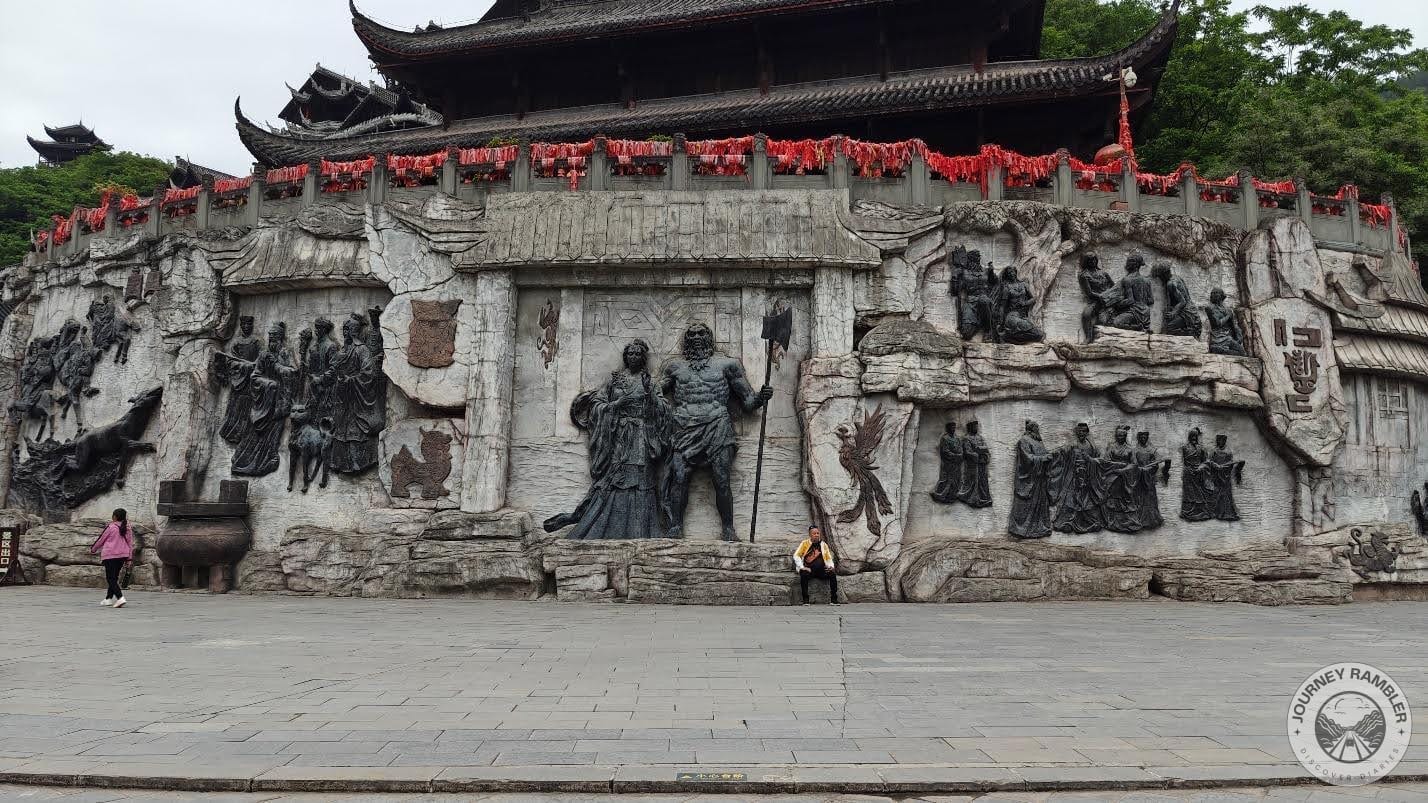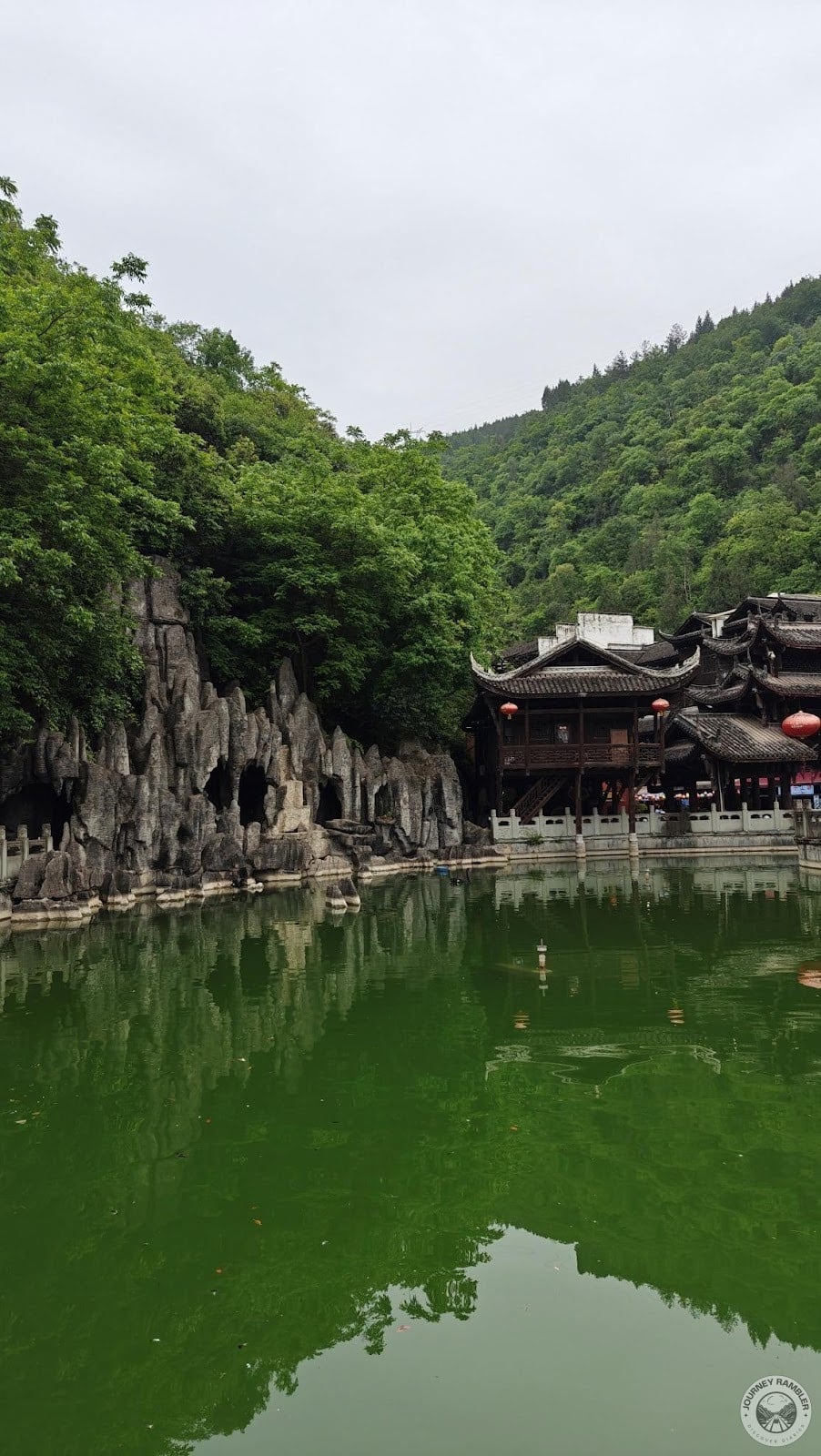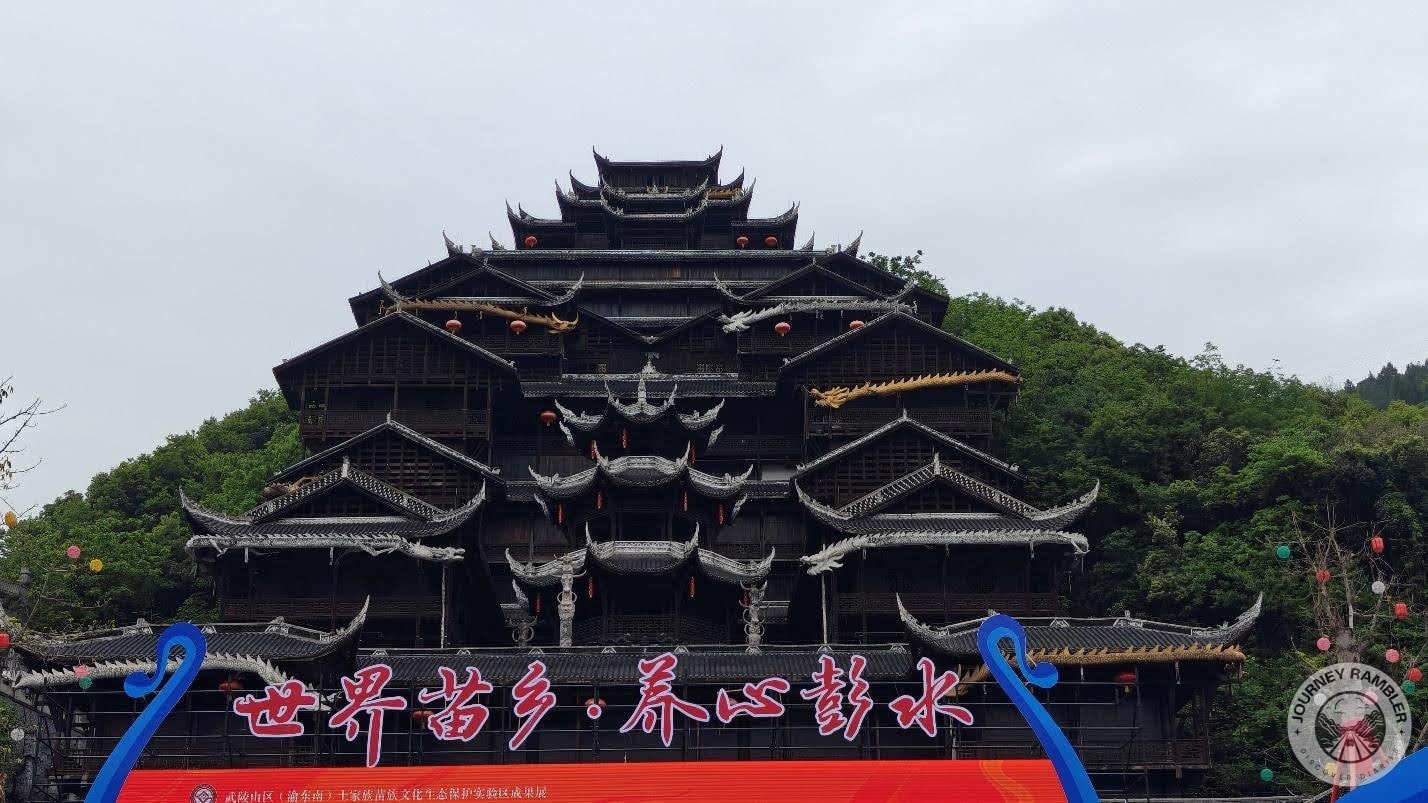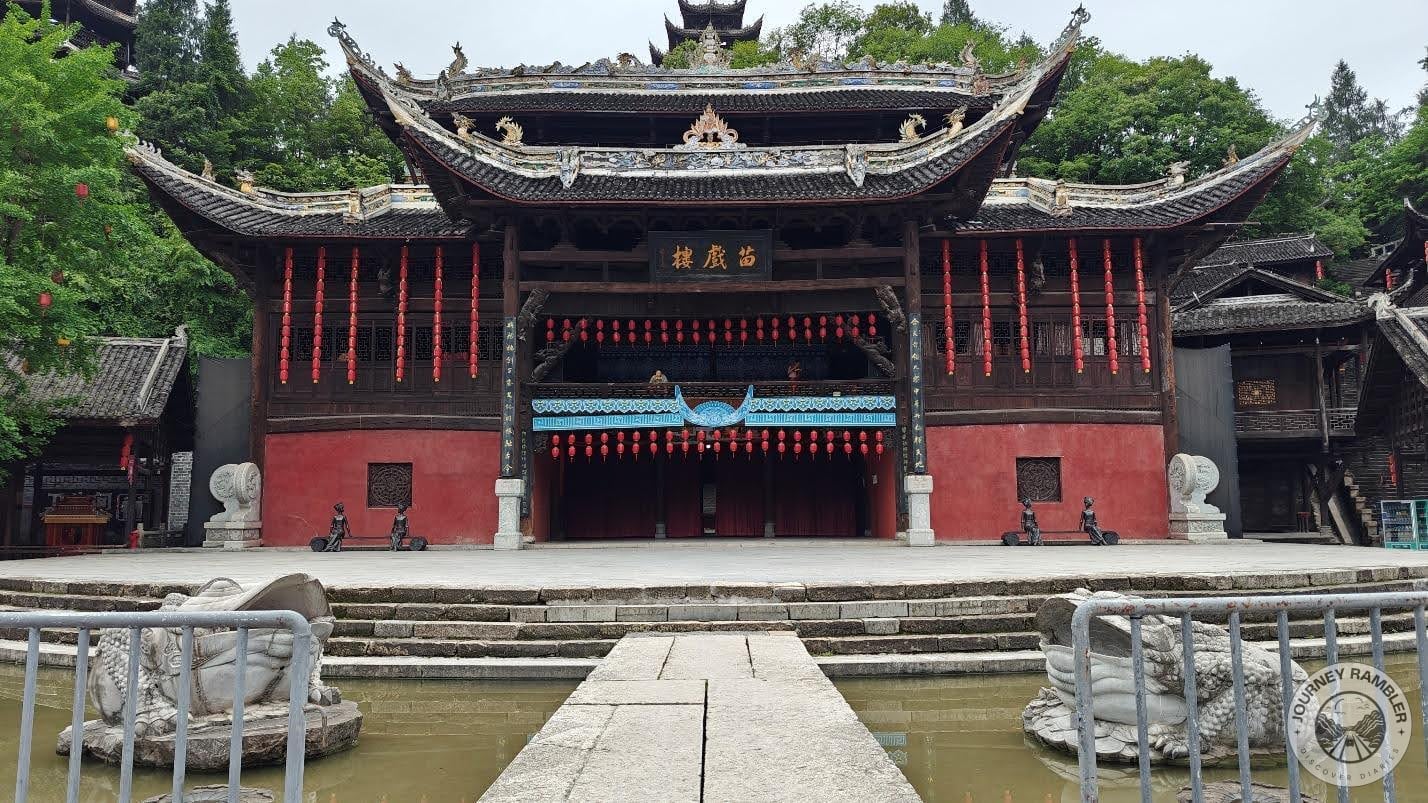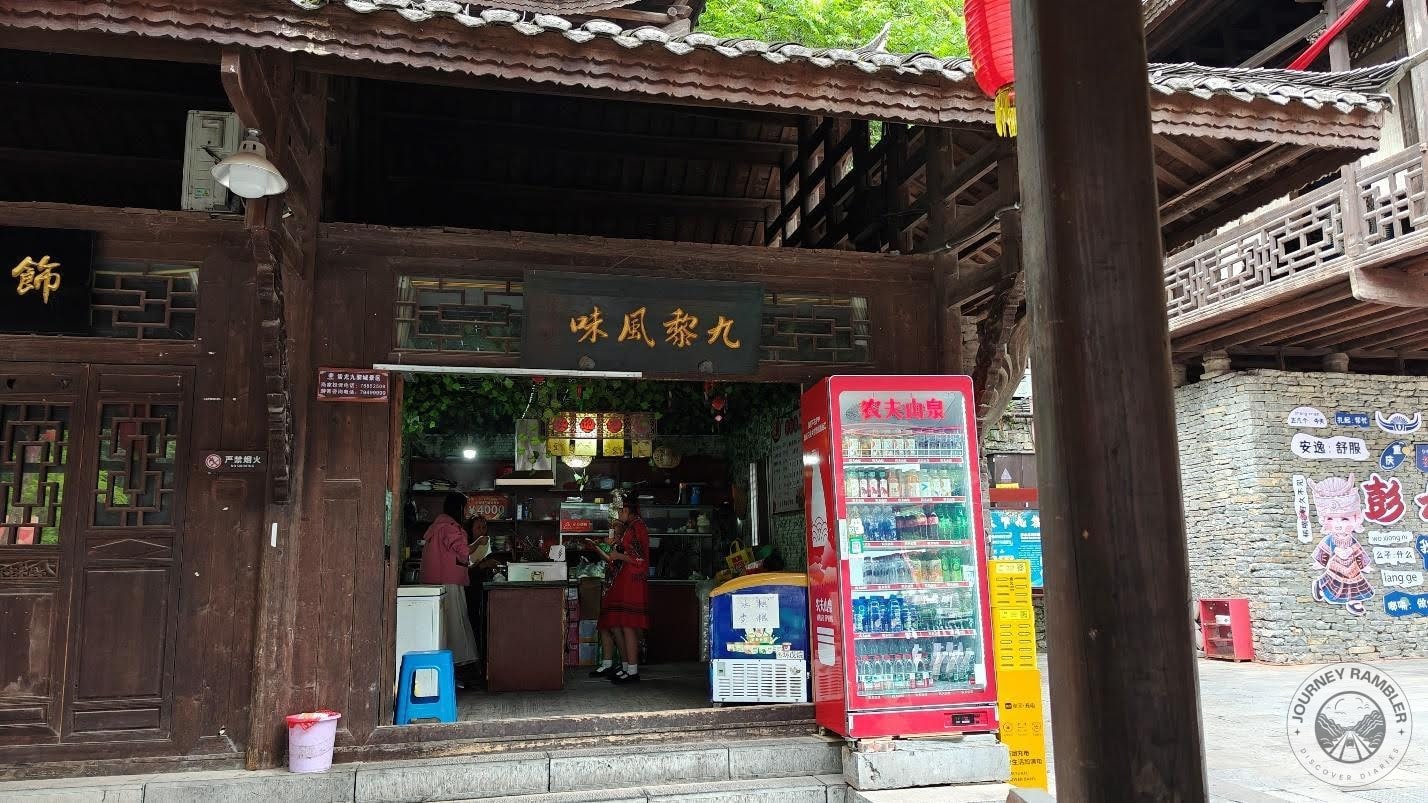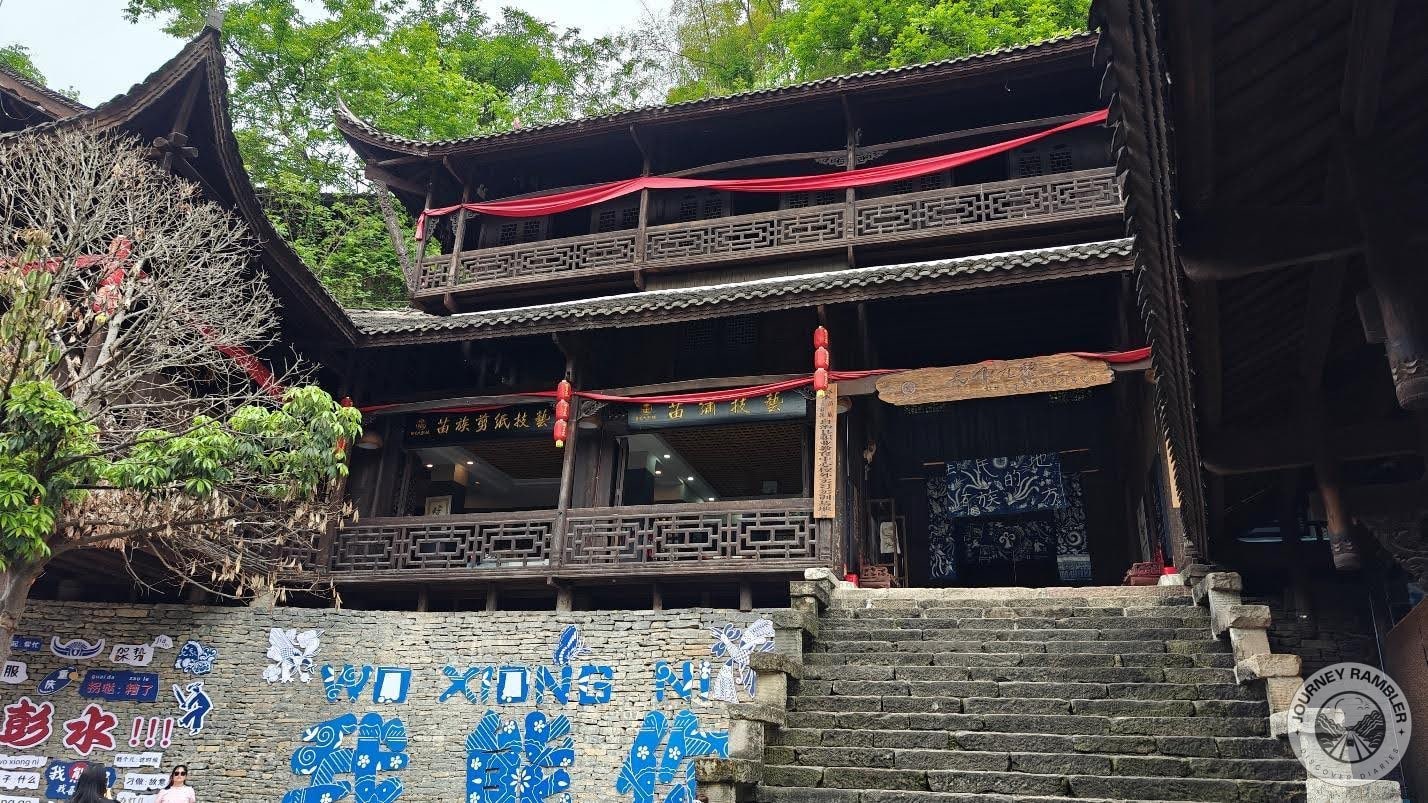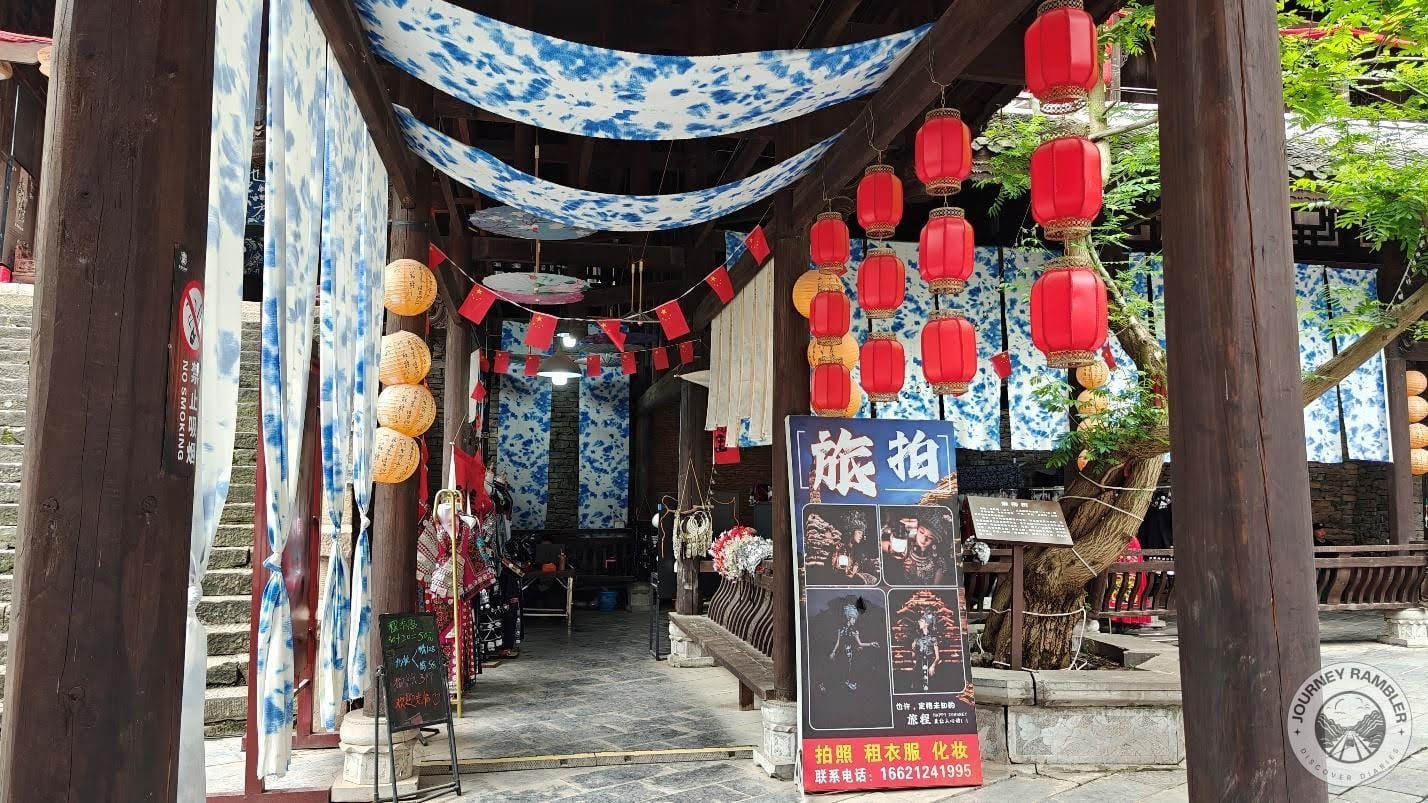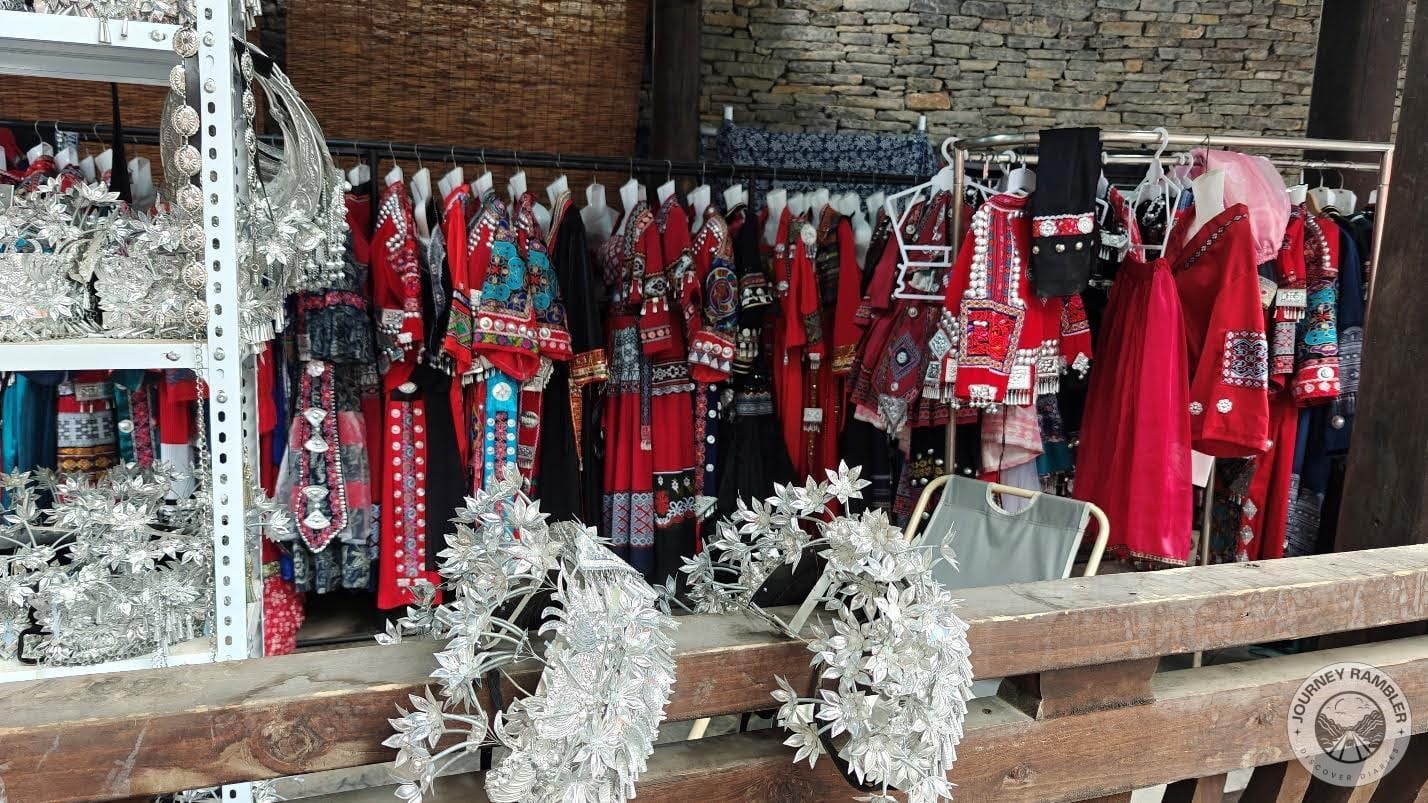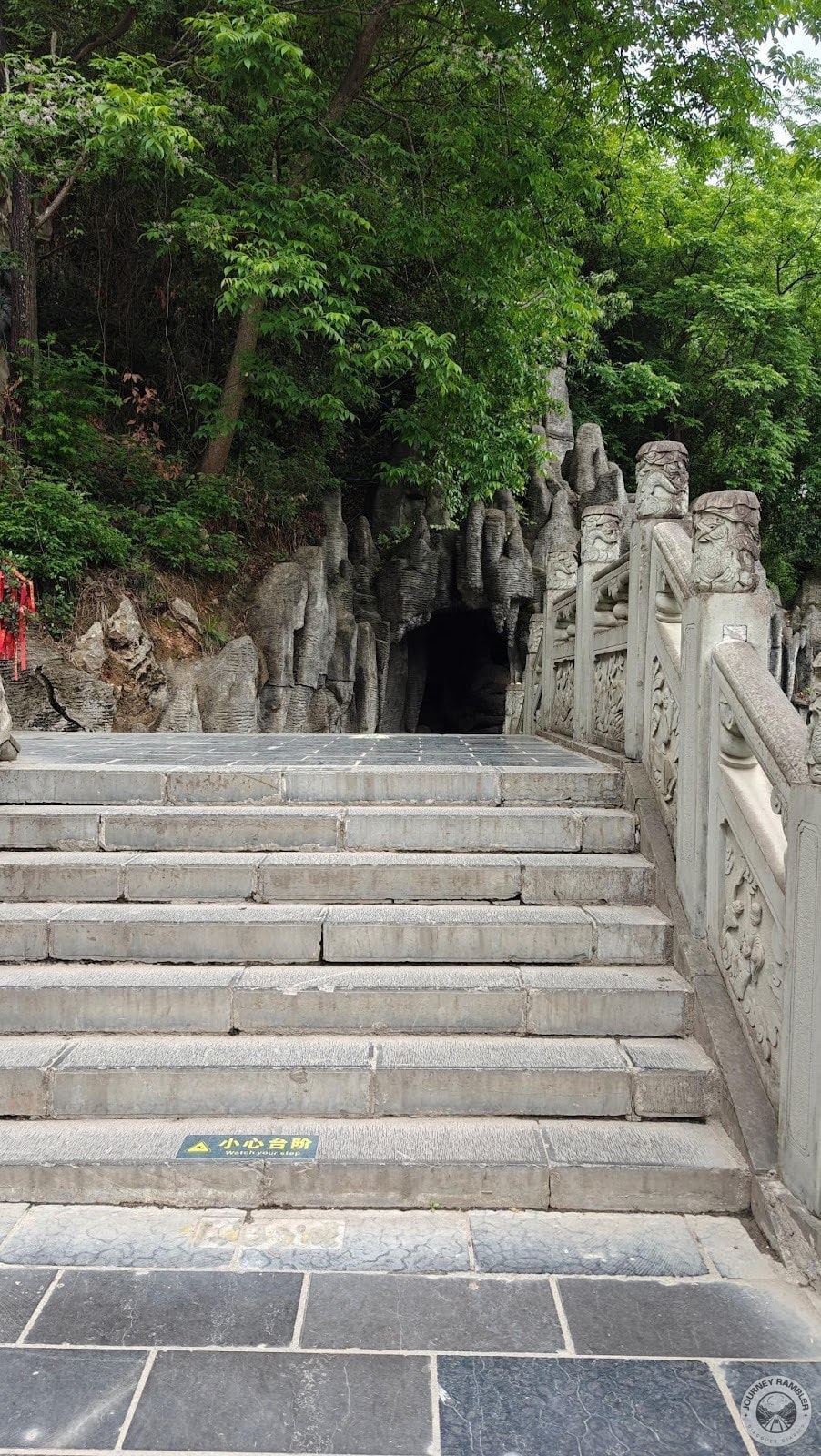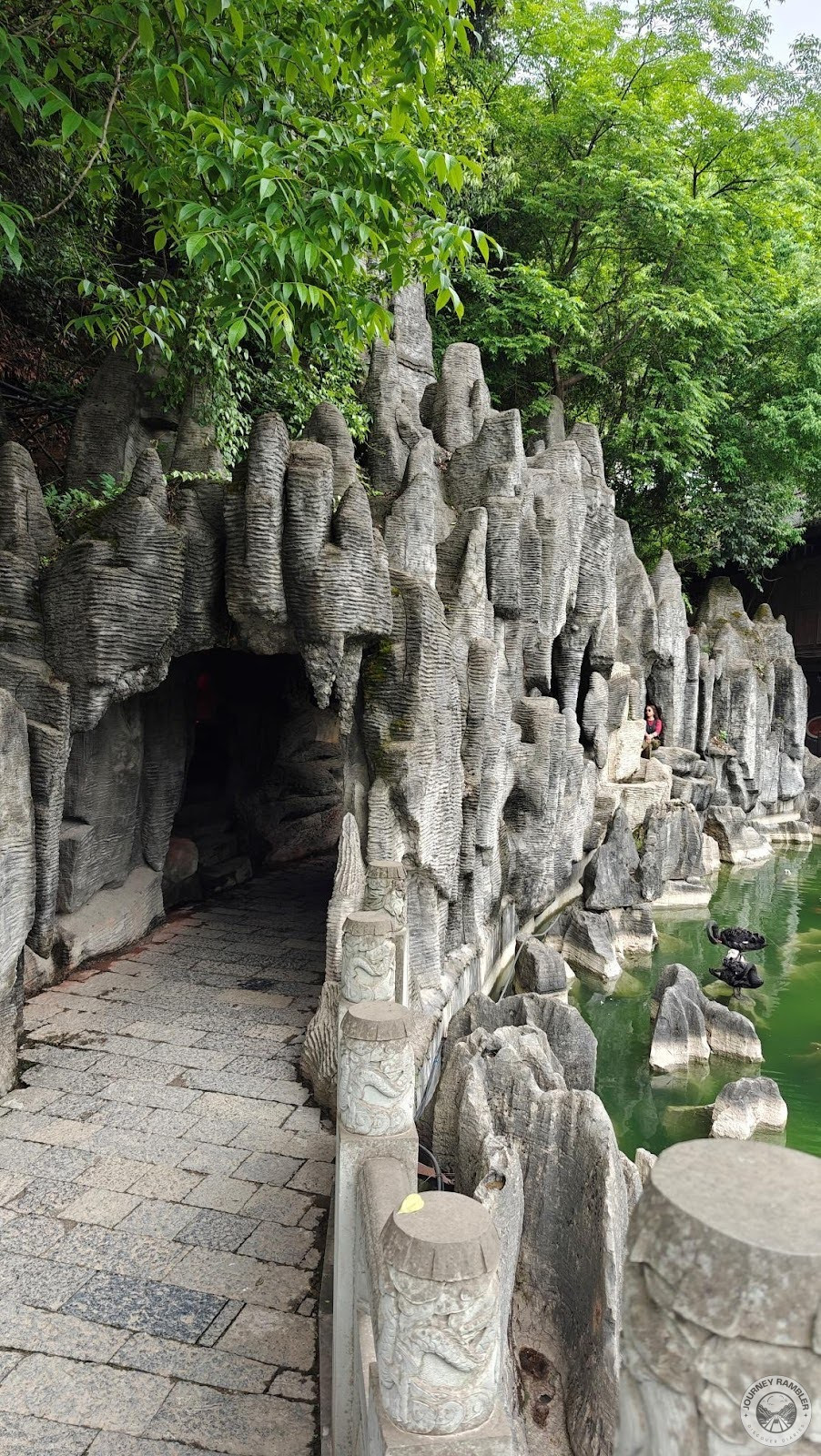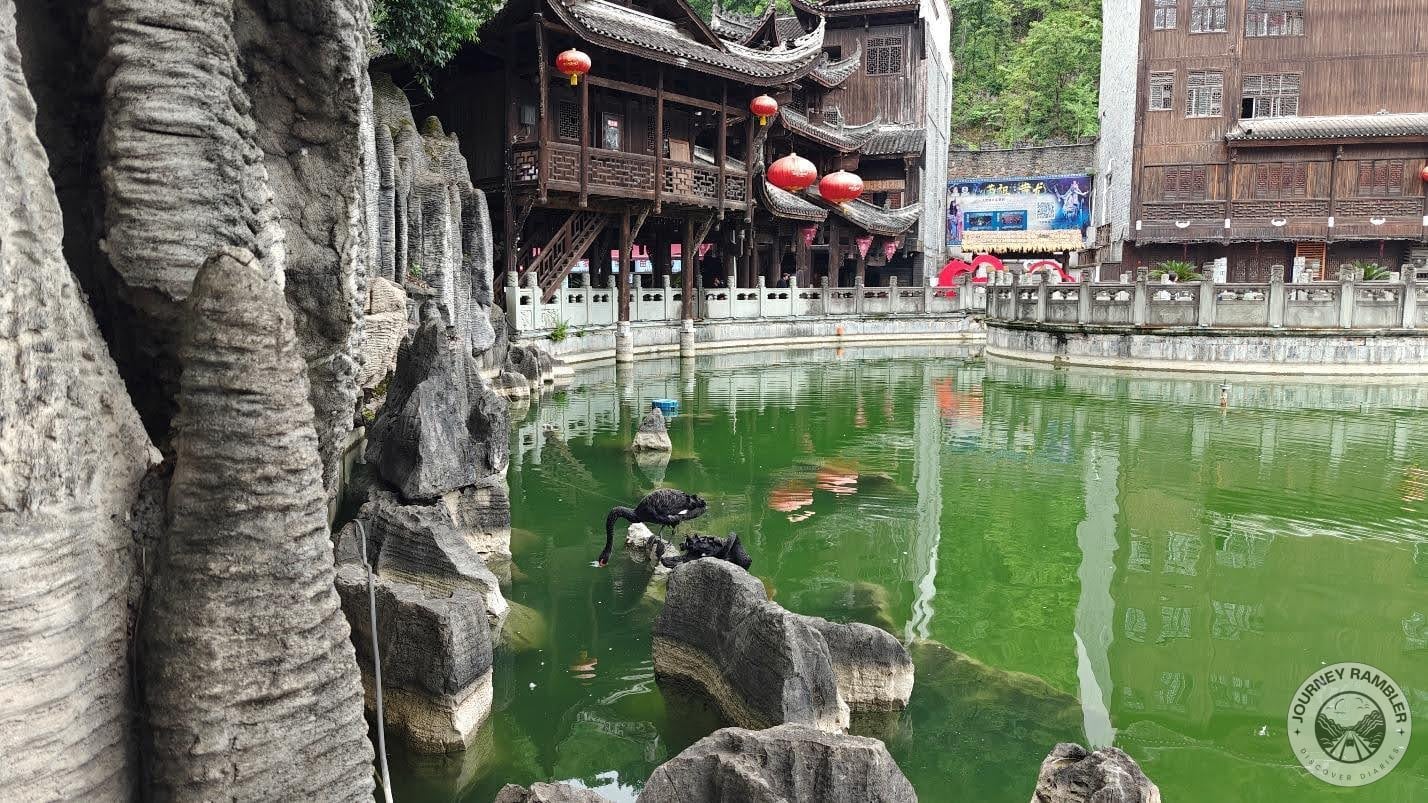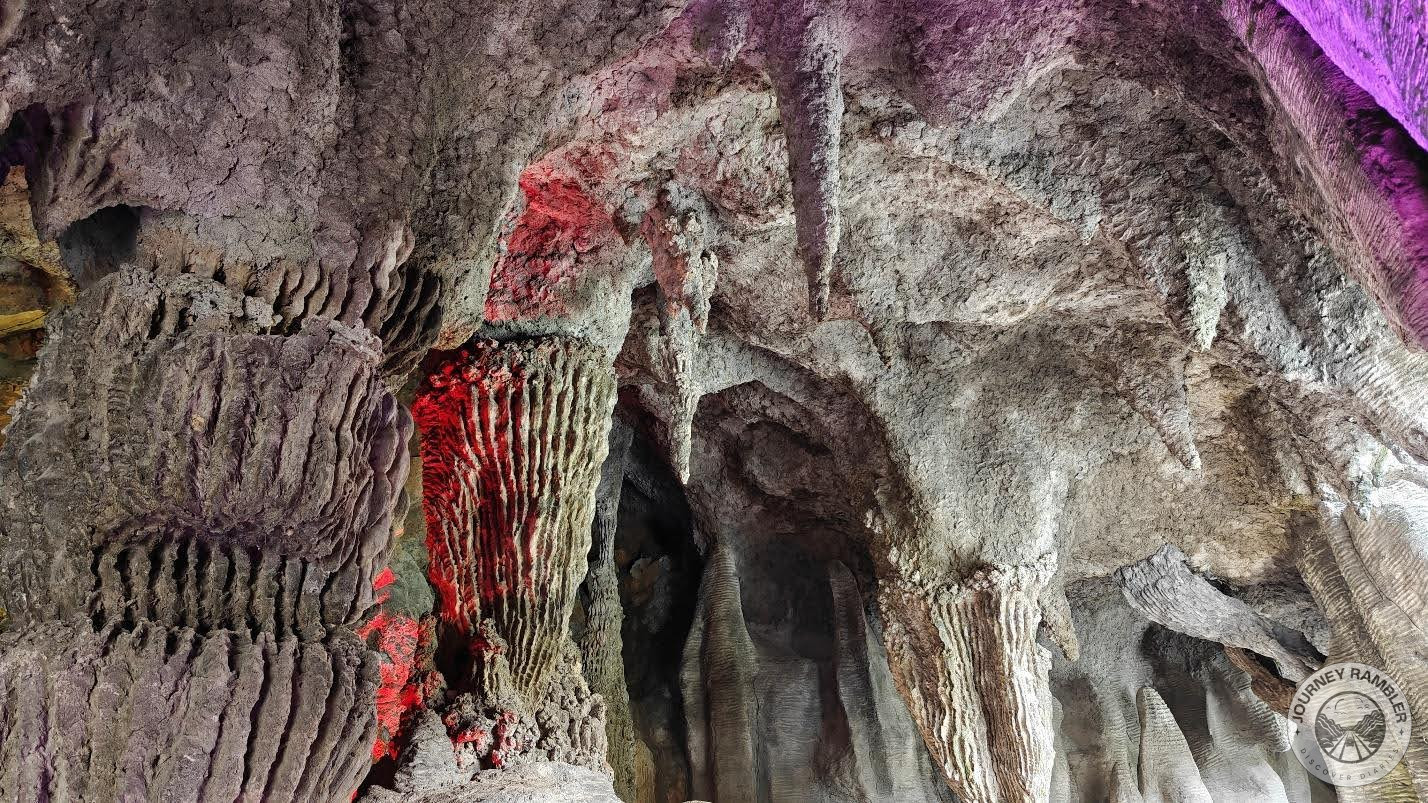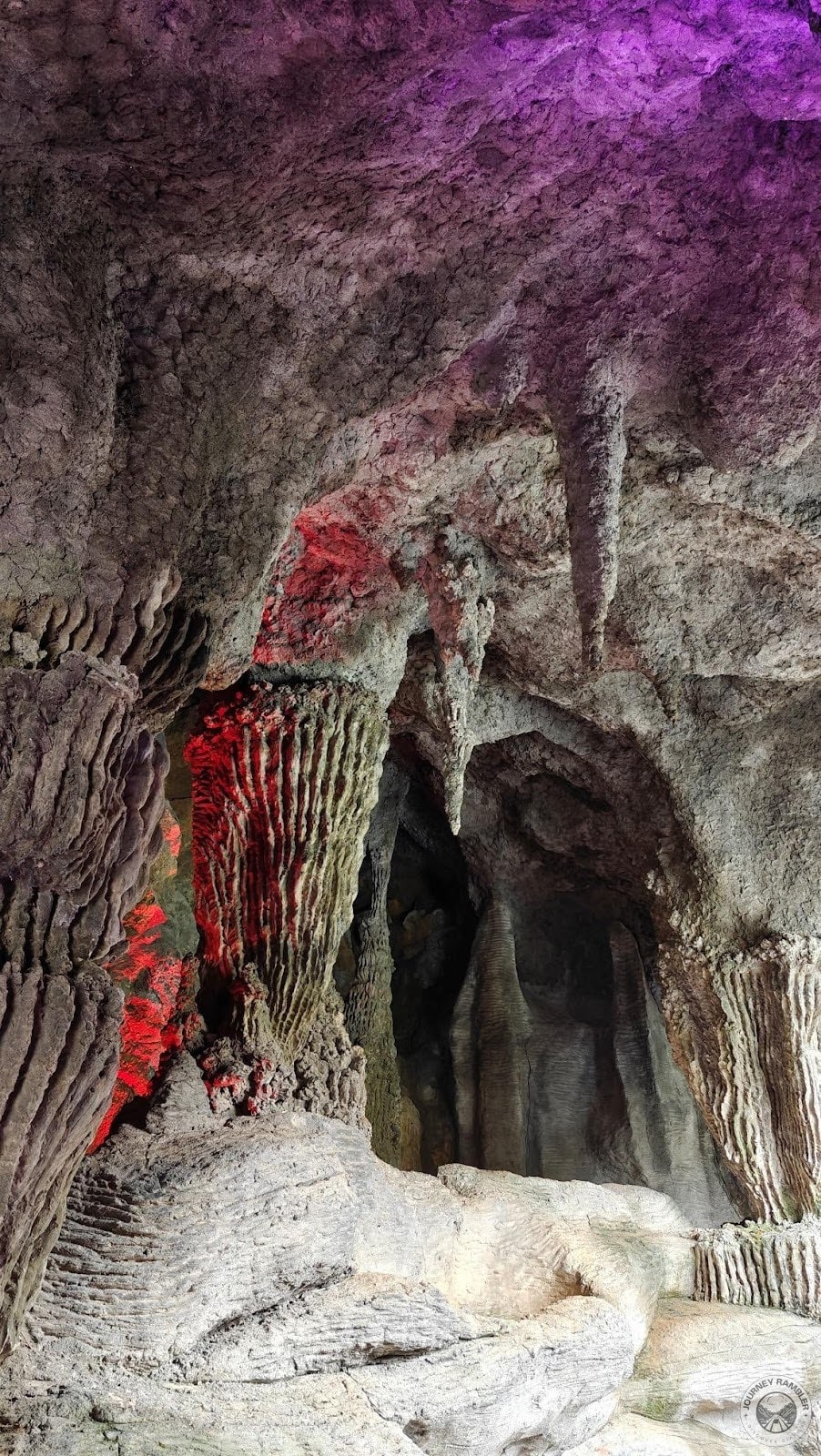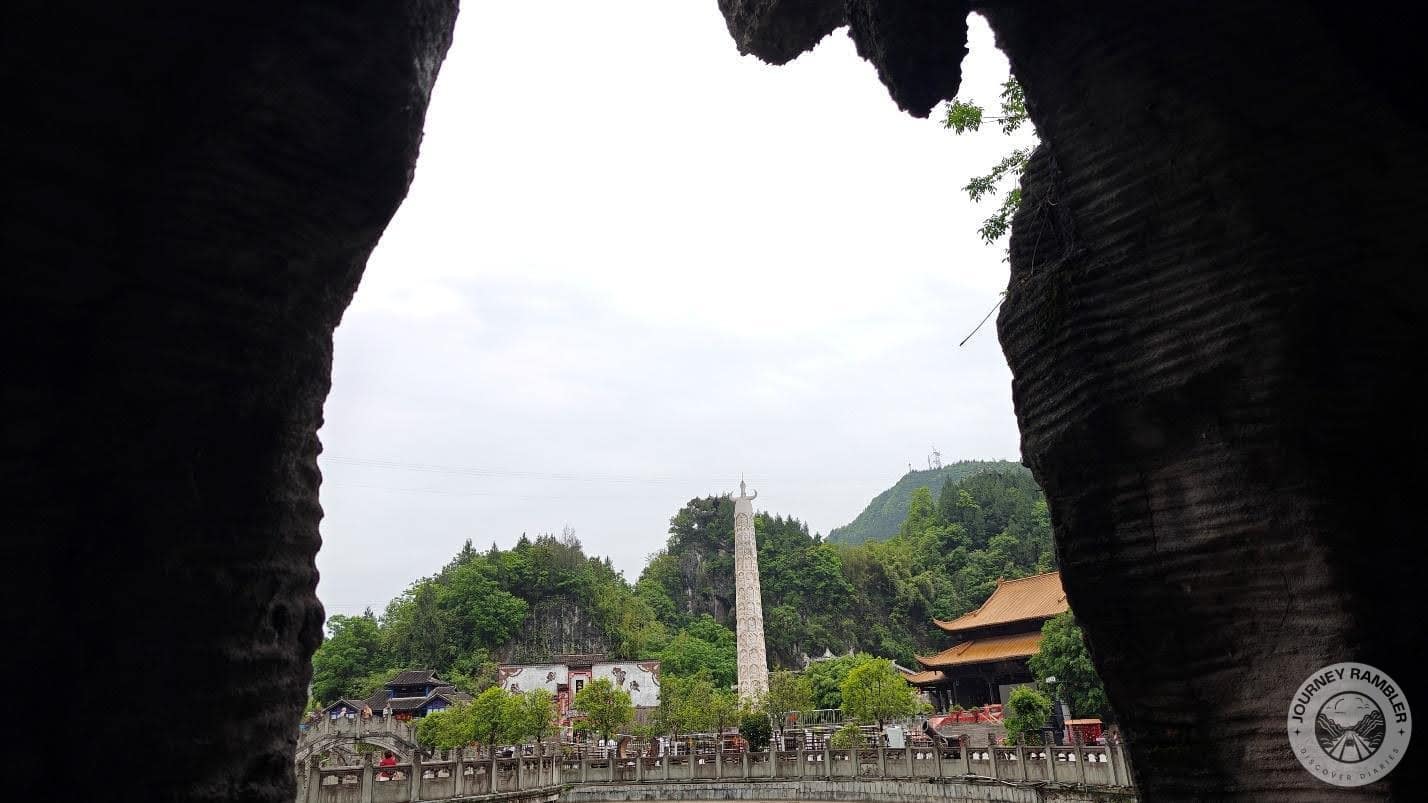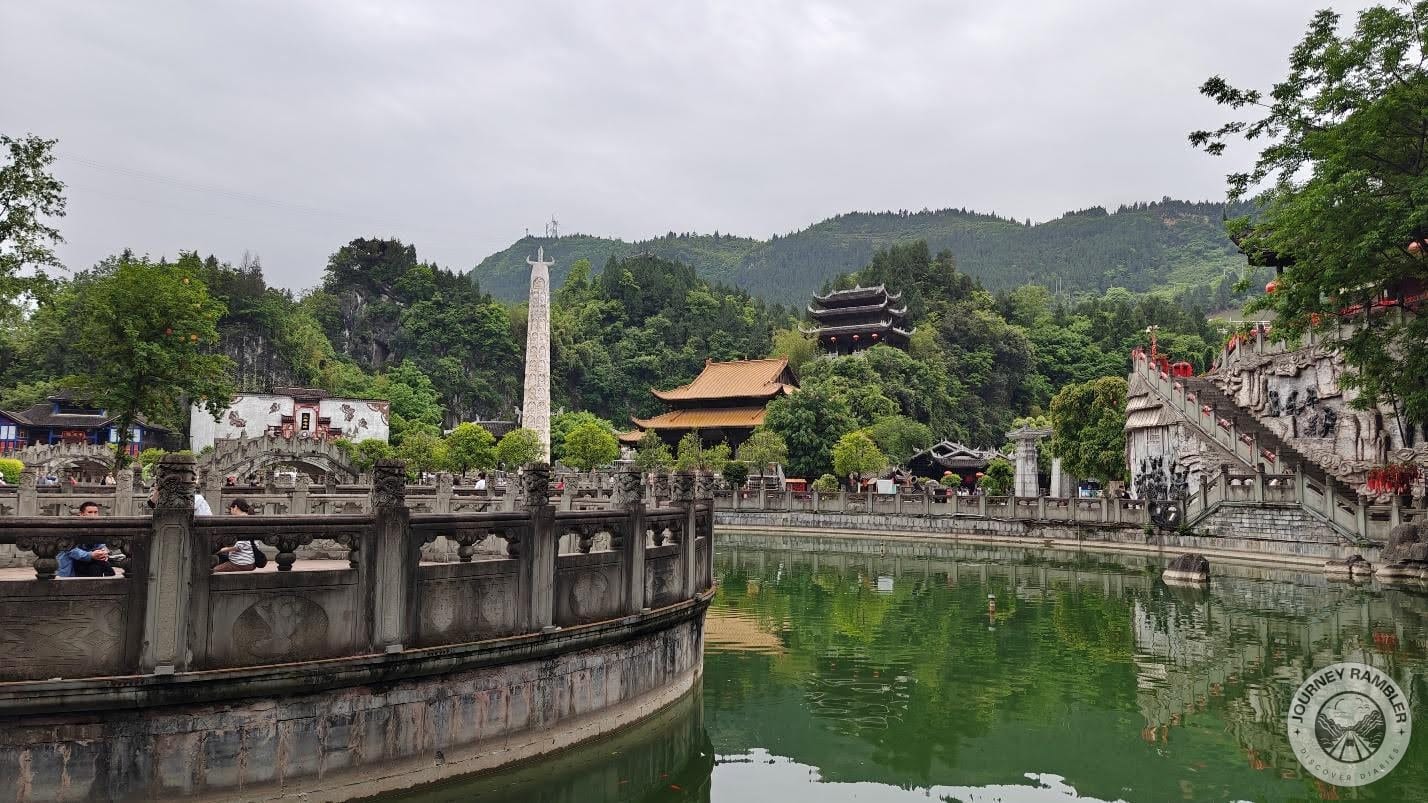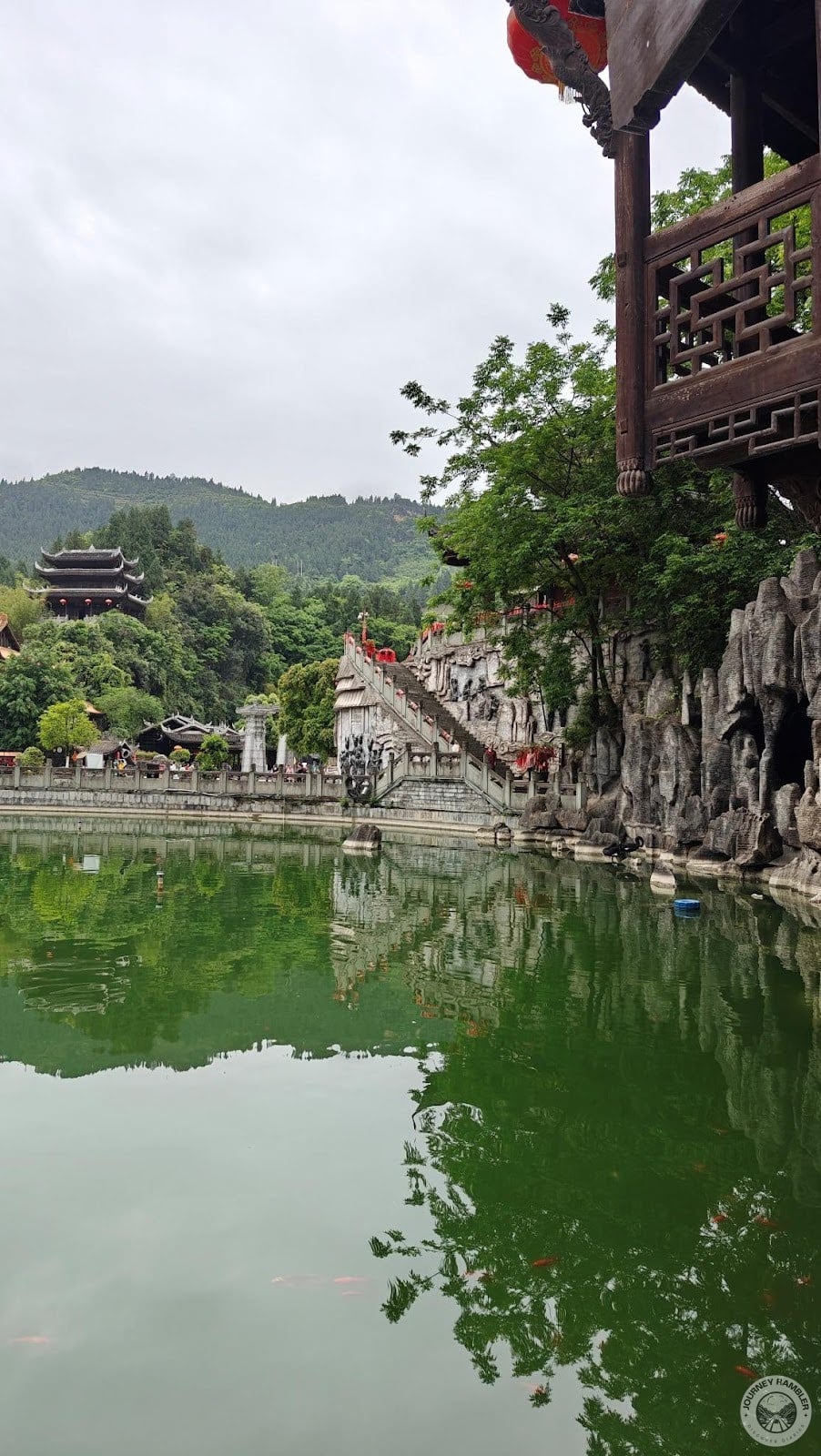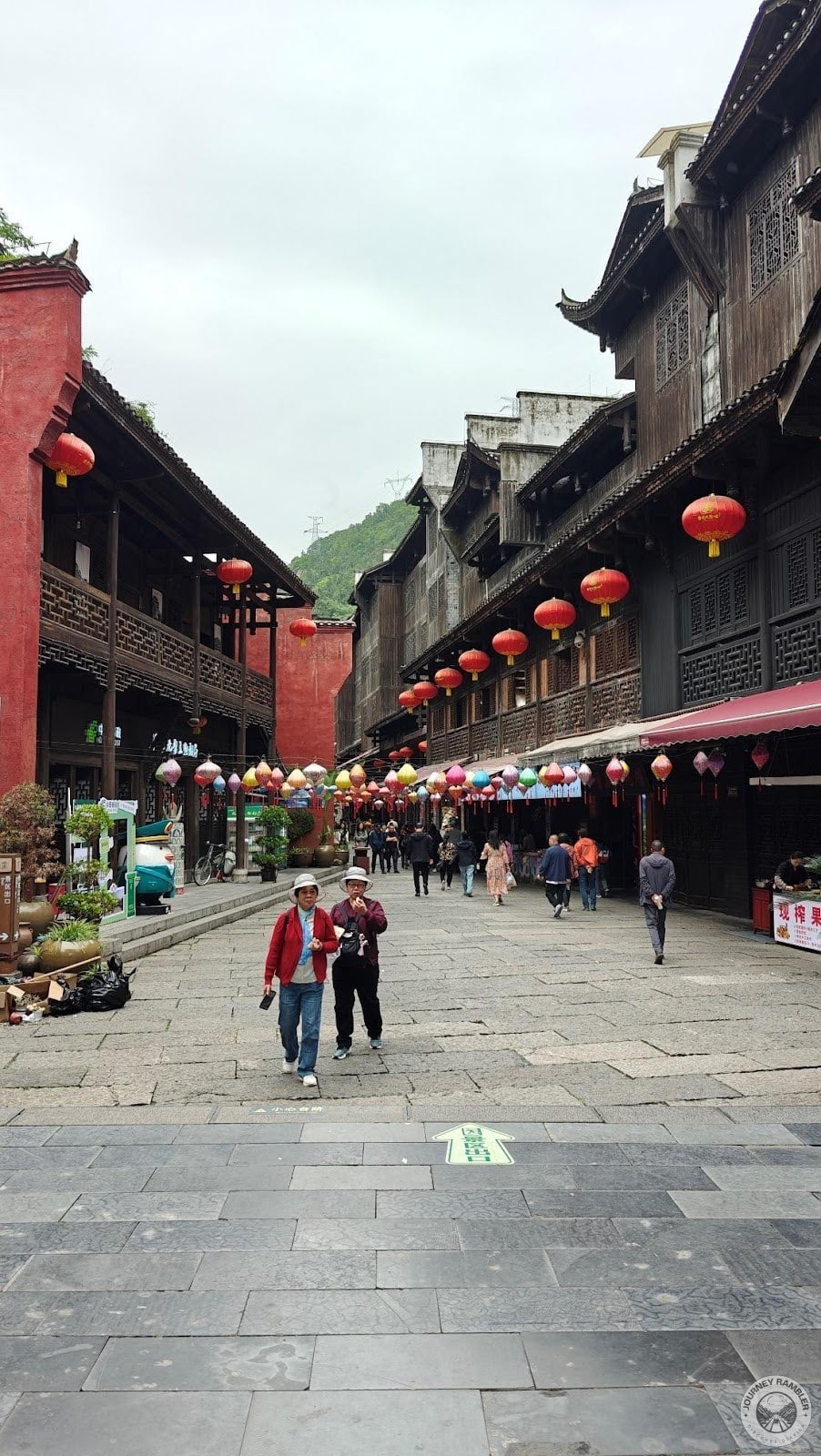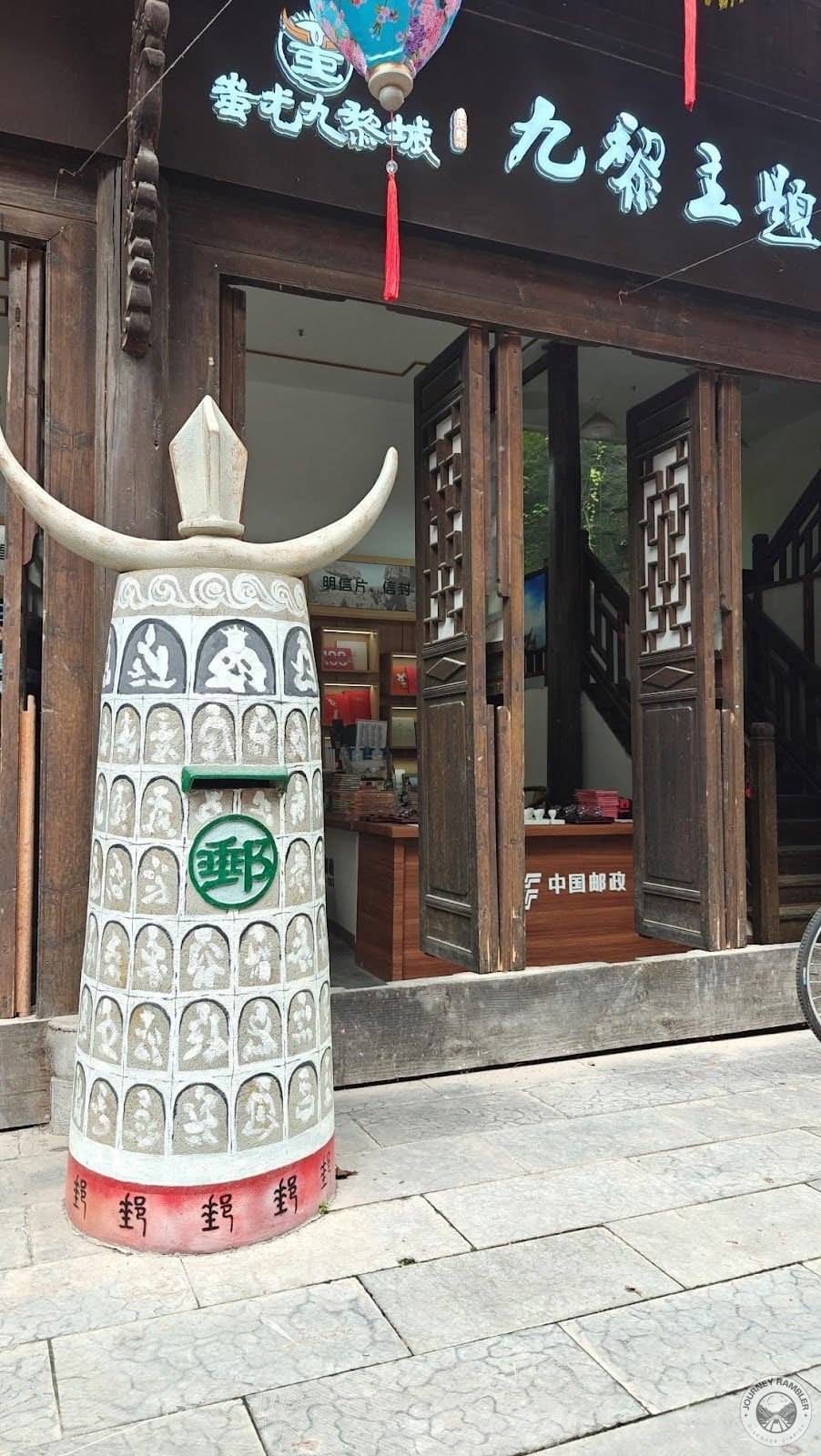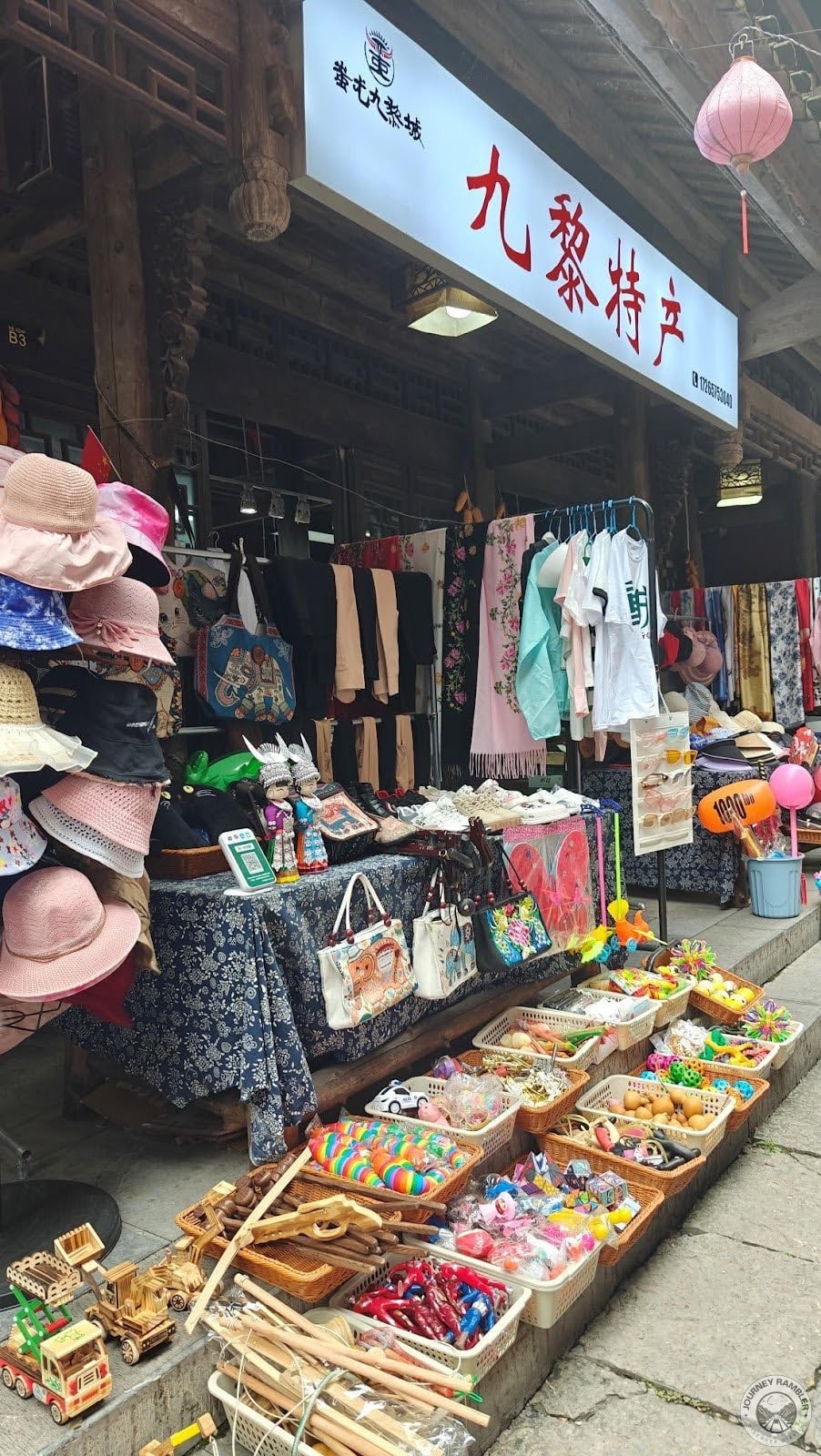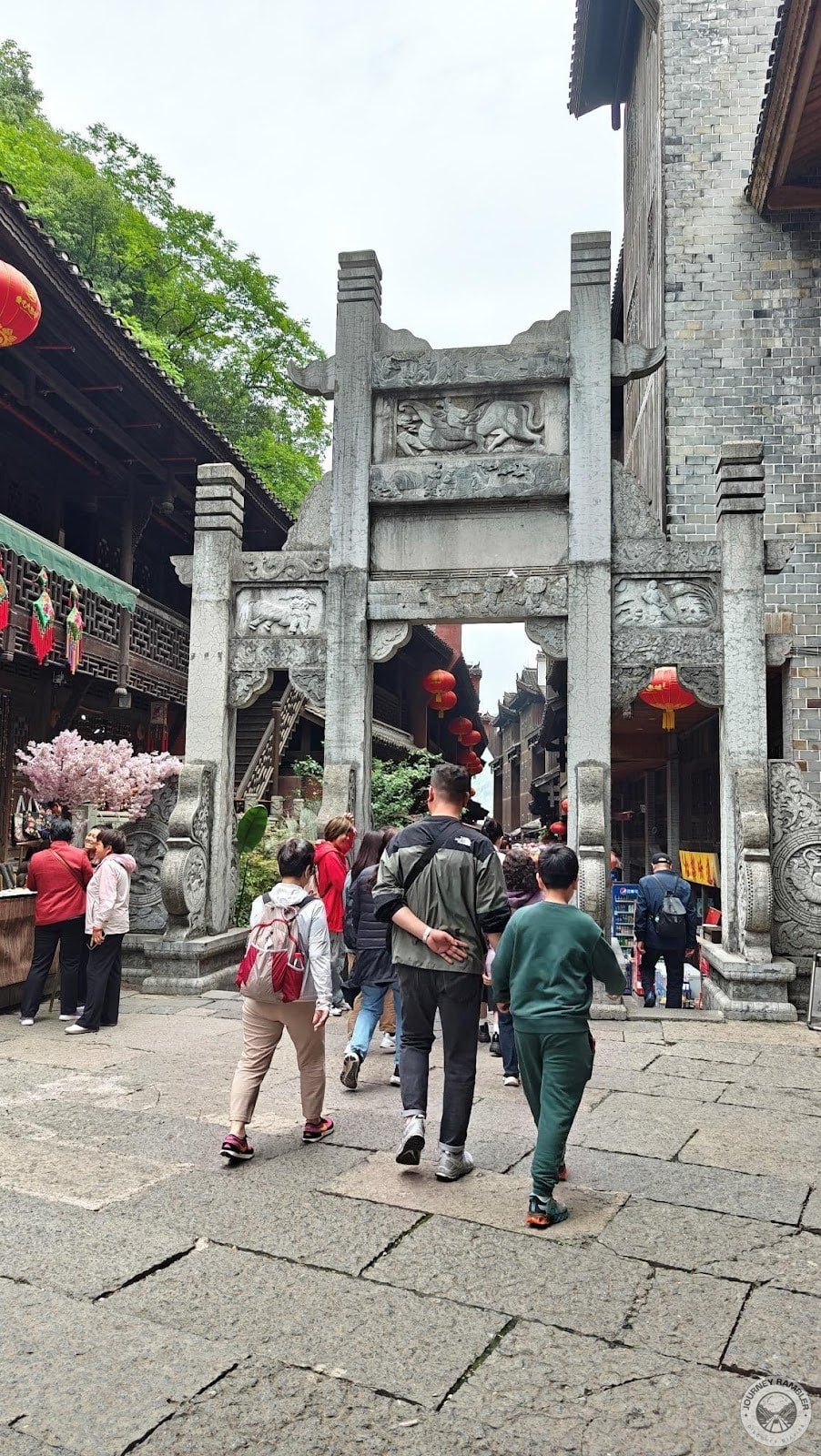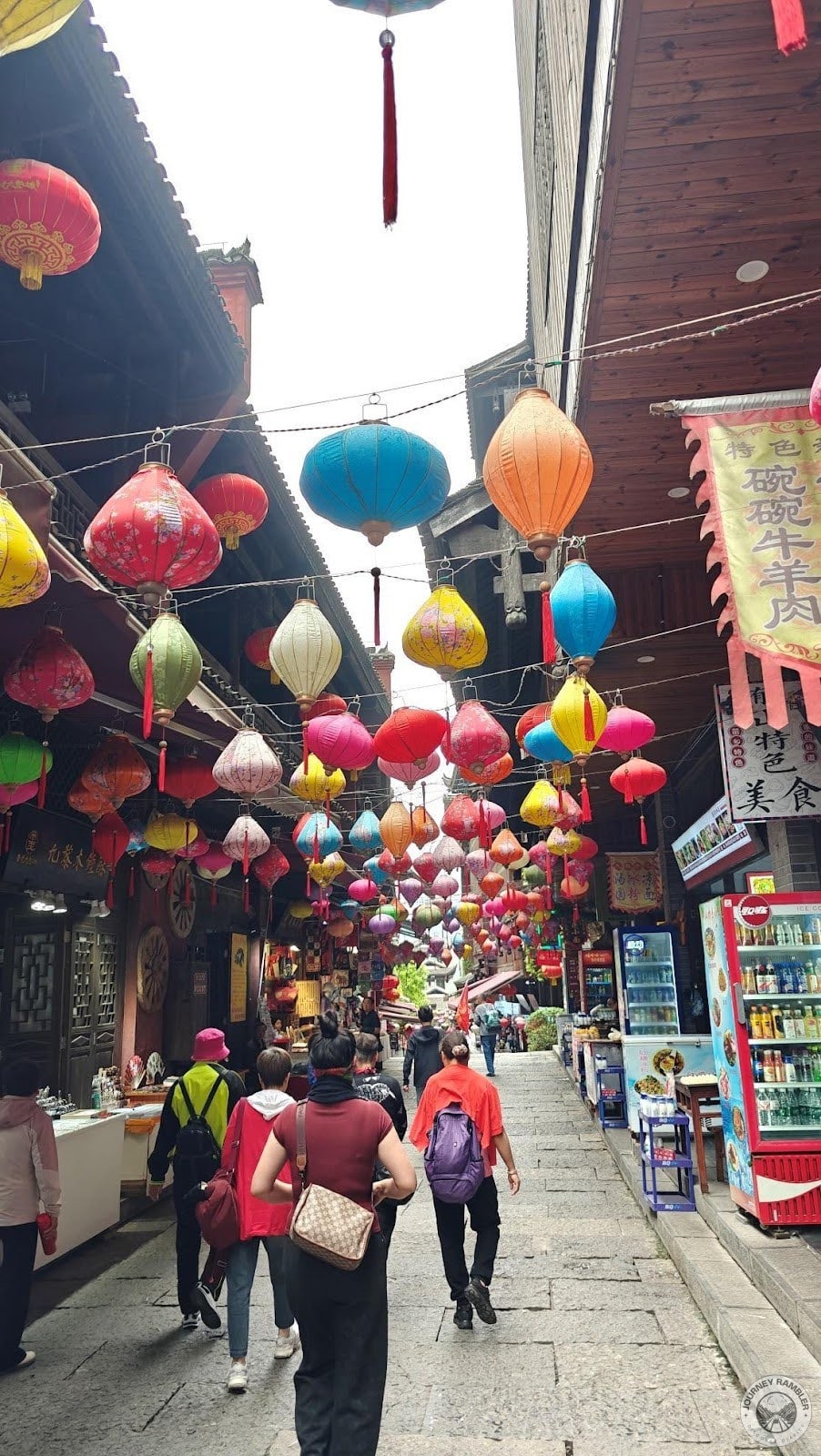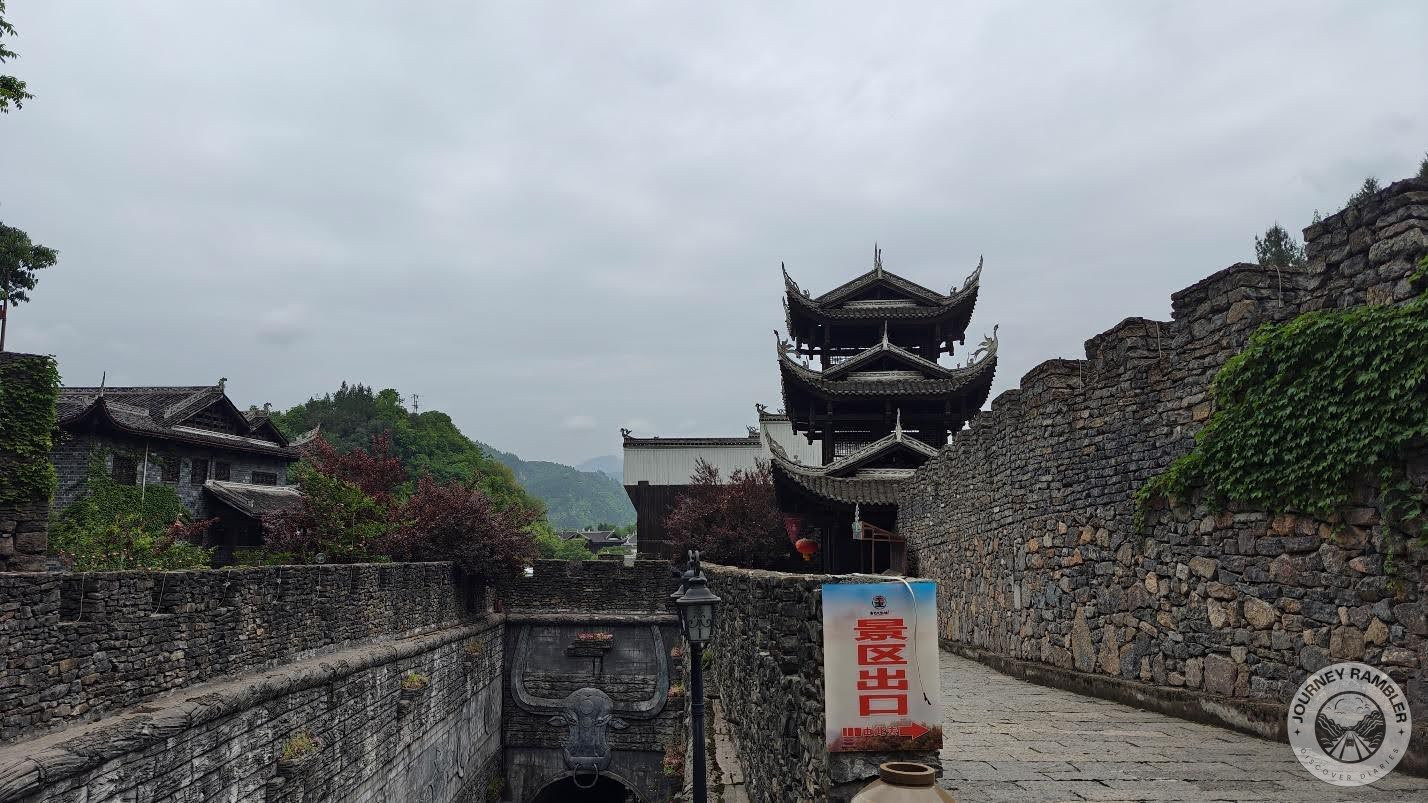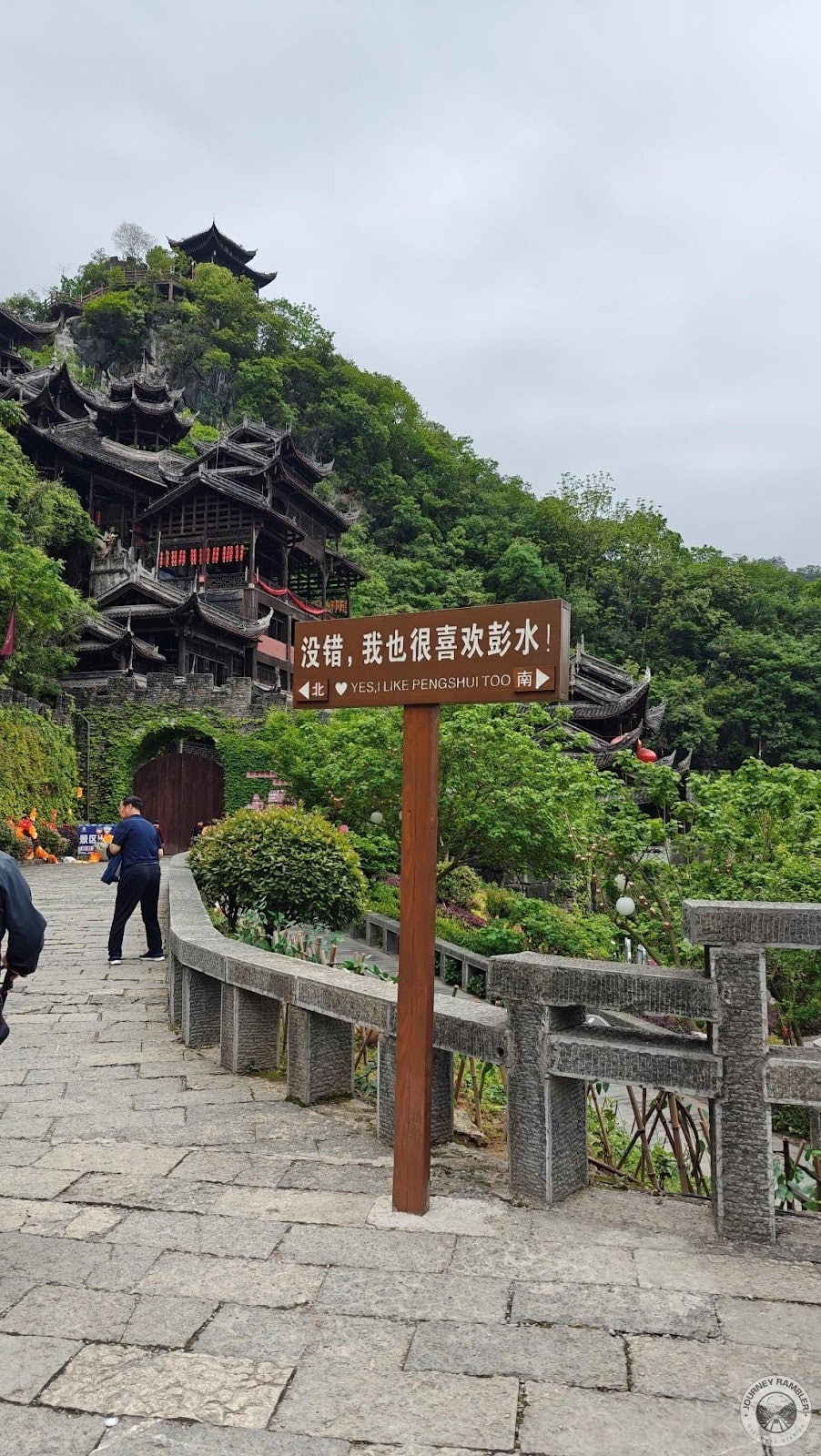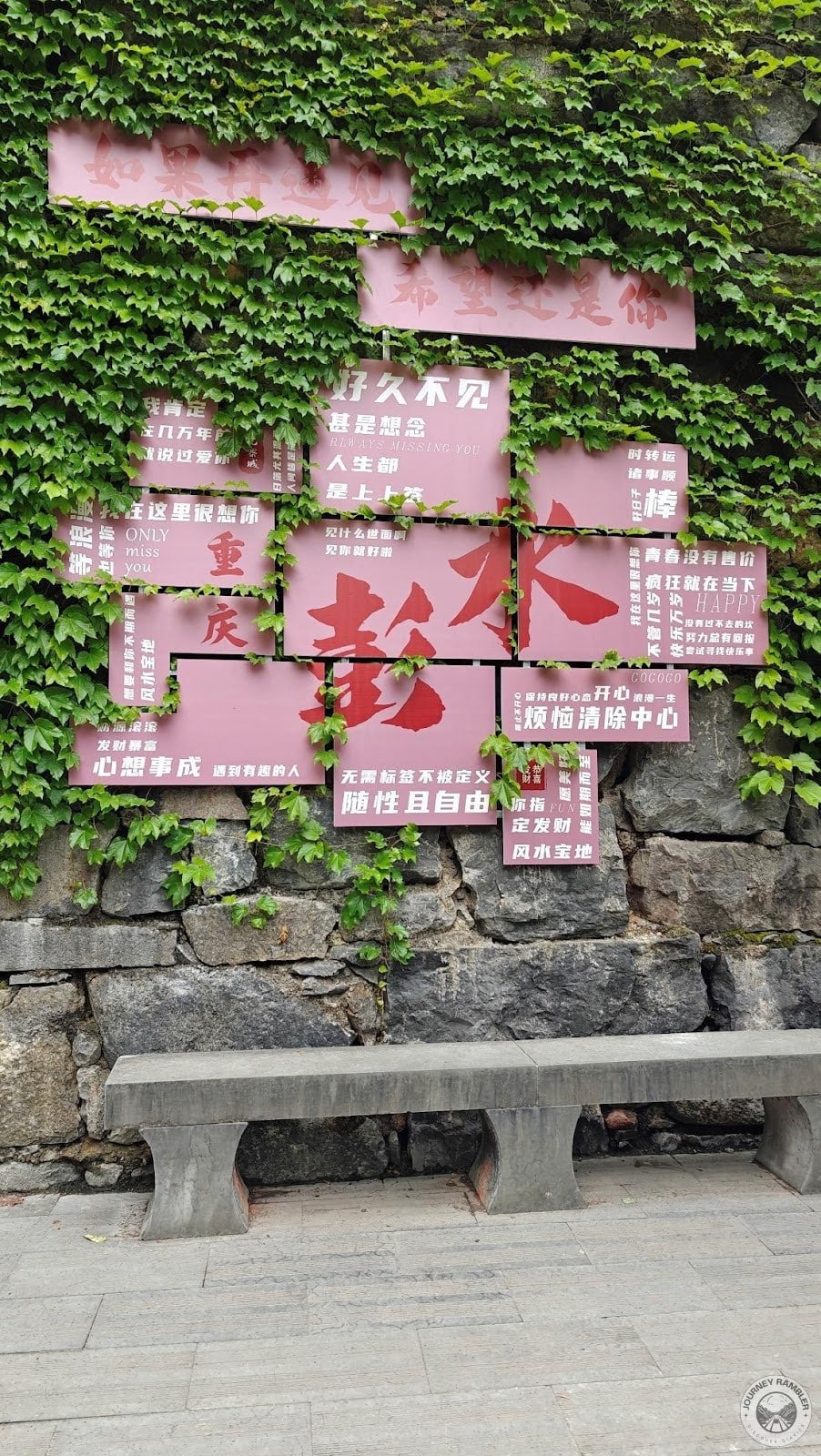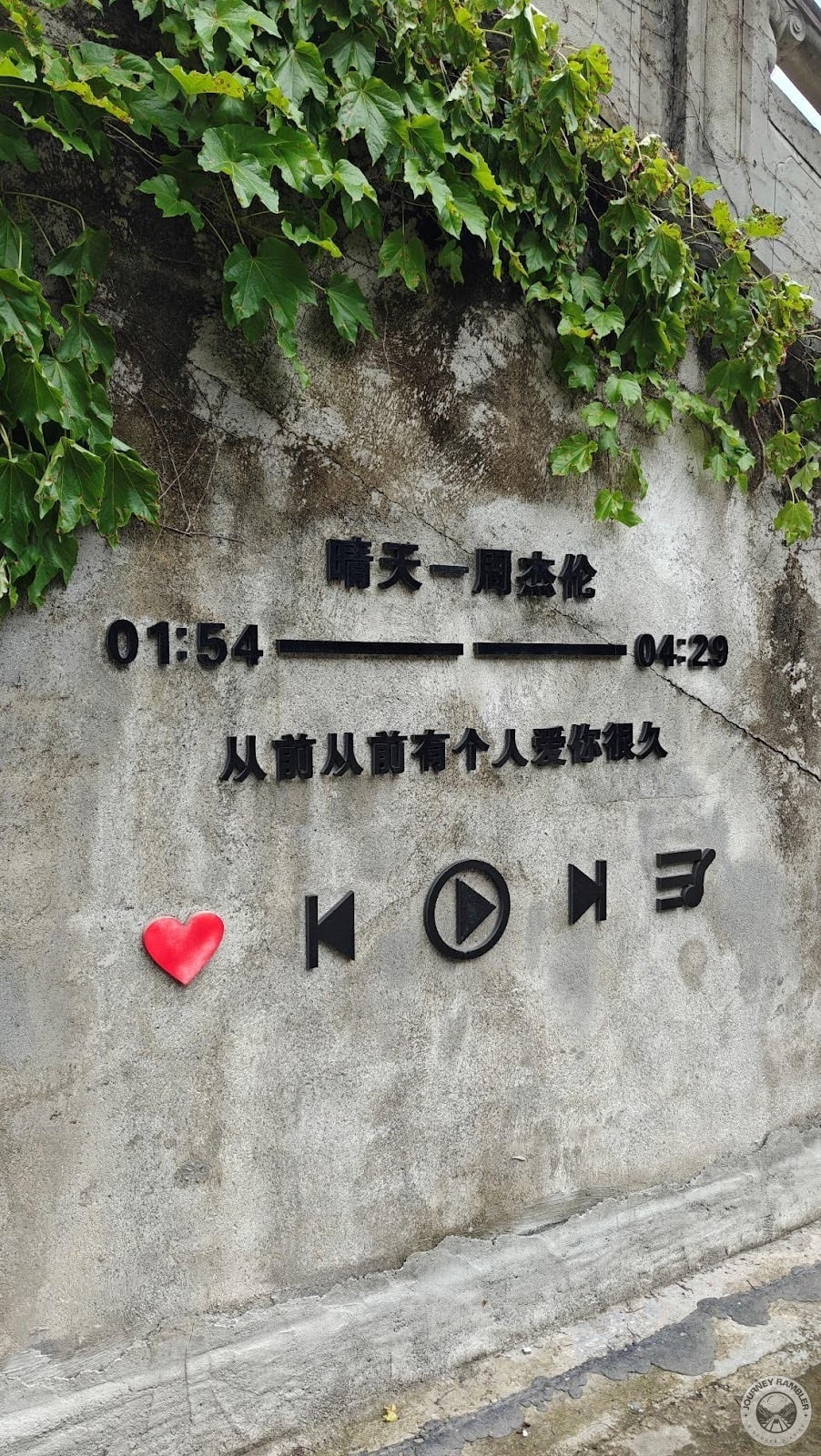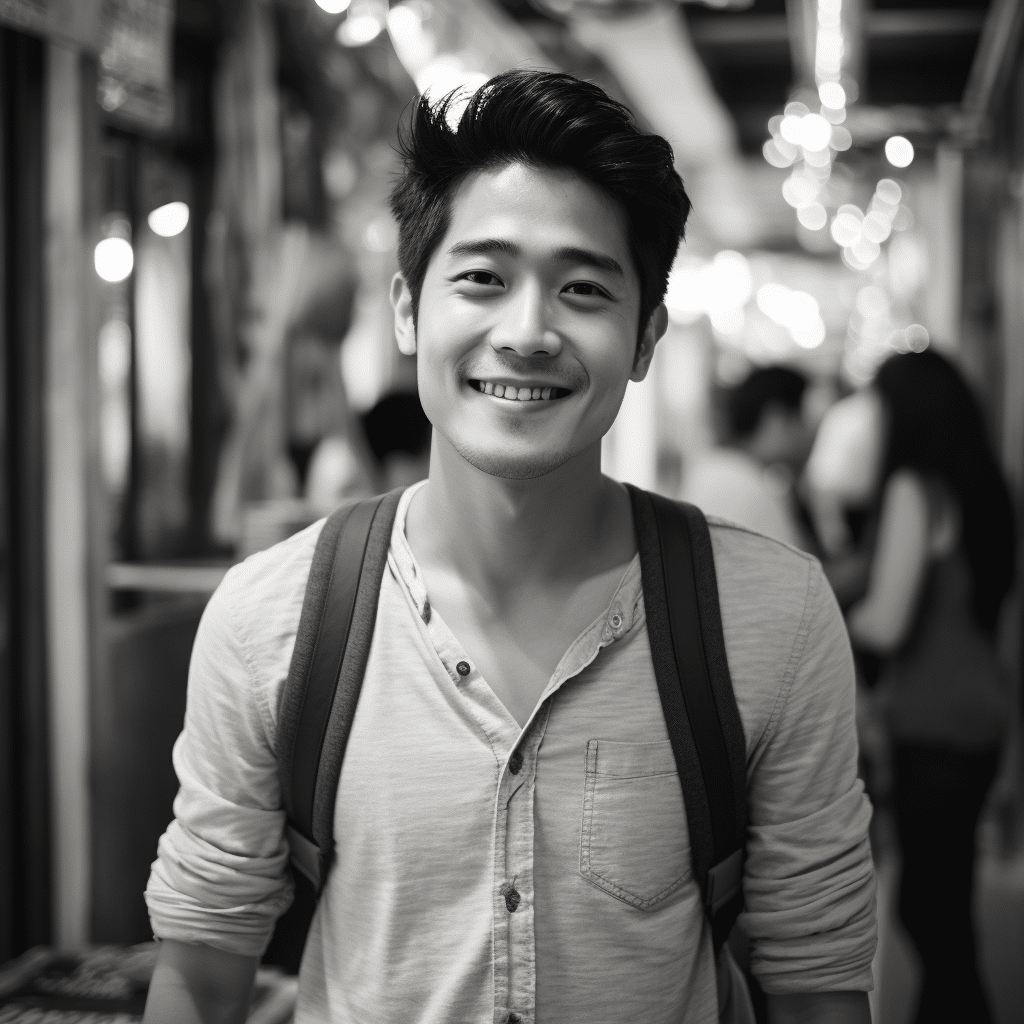Chiyou Jiuli Palace was another memorable location in Chongqing that I think deserves a lot more attention. I was fortunate enough to have visited the place during my stay in Chongqing and was impressed by the architecture and the cultural relics that I came across there. In a lot of ways, the palace reminded me of the temples and shrines that I saw during my travels in Japan. It was big, imposing, and featured plenty of activities for guests to enjoy.
Chiyou Jiuli Palace Ticket Purchase:
👉 Trip.com: https://trip.tpx.lv/ZWOeElAP
Chiyou Jiuli Palace: Knowing More About Chongqing’s Miao Heritage
This is what will greet you once you reach Chiyou Jiuli City’s entrance. The sign on top of the main entrance says Tourism Center on it and is where you’d ideally want to go first.
Once inside, you’re going to then want to head on over to this area to get your tickets. There are two desks here that cater to individual guests and those who are part of a tour group. While I can’t definitively say which one is better, I will say that being in a tour group might be more convenient as you likely won’t have to deal with the language barrier.

free chongqing itinerary
Visiting Chongqing?
Get my original 4–5 day, 13-page Chongqing itinerary in PDF format, based on my real trip, with many photos, hotel, and food tips. Enter your email to receive it free.
We won't send you spam. Unsubscribe at any time.
Here’s a sign featuring the admission fees to get inside Chiyou Jiuli City. For regular adults, the rate is set at CNY90 while minors (6-18 years old), college students, seniors (60-65 years old), and local residents of Pengshui only need to pay a CNY45 fee. Kids who are 6 years old and below that are under 1.2m, seniors over 65, those in the armed forces, veterans, and firefighters can all get inside for free.
So one thing I really noticed here is the embroidery hanging on the column. They all looked like small pillows with trinkets and loose colored rope hanging from them. Apparently these are embroidery made by the Miao people. Now the Miao are an ethnic group that’s composed of diverse sub-groups like the Hmong, Qo Xiong, A-Hmao and more. They’re different from the Han Chinese who comprise the majority of the Chinese population.
Here’s a sign featuring a tour map of Chiyou Jiuli City. Now ‘map’ is doing a lot of lifting here as I think this is more like a diagram of the places that you’d ideally want to visit when you’re here. If you’re wondering, the lowest point in this ‘map’ is where I’m currently at (the Tourist Center).
Chongqing Hotel Recommendations Based on My Own Stay
🔹 Ascott Raffles City Chongqing
🔹 Westin Chongqing Liberation Square
Top Activities in Chongqing
Wulong Tiansheng Three Bridges
Banquet in Ba Kingdom Royal Feast
So this is one of the few places here in Chongqing that actually has an area where you can drop off your pets. If you do decide to bring your furry friends here then you’ll have to leave them in this area inside these cages. It’s likely this only applies to locals (or rather the locals are probably the only ones who can take advantage of this) as it’s quite costly to bring in a pet from outside of China.
Other than pets, you can also leave your important belongings here in these digital lockers. What’s great about these is that they’re actually free to use though you might want to come here early as I’d imagine there’d be plenty of people who’d want to use these.
After stepping out of the Tourist Center this is what you can expect to see. In a lot of ways, this somehow reminded me of a cross between the aesthetics of Tsurugaoka Hachimangu (a shrine I visited in Japan) and the architecture of Hongyadong (another attraction here in Chongqing that I already visited and talked about).
As you can see, there were plenty of people here at the time of my visit. I did notice though that most of the visitors here were locals with very few foreigners. You might have missed it but the building in the background is actually the Tourist Center we visited earlier.
I’m not going to lie, this structure was perhaps one of the most jaw-dropping that I’ve ever seen in my travels. This is part of the Jiudaomen or the Nine Gates and I don’t think my photos can ever hope to capture how majestic it looked. While the whole complex is relatively new, these gates looked as if they were made in Ancient China thanks to how weathered they looked.
Now I said that the gates were just a part of the Chiyou Jiuli City complex and here’s a map of that. As you can see, the complex is rather large so you’re going to want to take a pic of this map just so you have an idea of where you’re at and the notable places that you plan to visit.
Of course, the first thing that you’re going to want to do is go through the Nine Gates. To do so, you’re going to have to climb up these stairs. Thankfully, this staircase isn’t really that high up or steep. That said, this won’t be the only set of stairs you’ll be climbing so make sure you have comfortable footwear.
This is what the entirety of the first staircase looks like. It was pretty busy here as a lot of the visitors (me included) thought this was a great spot to take photos. I really couldn’t blame them as the entrance leading to the Nine Gates in the background made for really scenic shots.
After reaching the level of the entrance, I came across this peculiar looking structure that kind of looked like a drum. There was a pair of these and they kind of flanked the entrance. If you looked at the structure’s base it had these designs and inlays that looked so complex and intricate.
I’m really bad at translating so I ask for forgiveness in advance if I end up butchering the names of these signs in English. The vertical sign in the image is, I think translatable to Wuyimen and is likely a reference to the Wuyi Mountains (which is a UNESCO World Heritage Site).
After passing through that entrance, you’ll come across this smug looking guy. I was careful to not let him know how smug he looked though as I thought he might not appreciate me saying that about him. Joking aside, I initially thought this guy was a mascot for an attraction here (based off of what’s written on the rock the sculpture is attached to).
So I was quite surprised after reading what was written on this post. Apparently, the Jiuli Dundao (basically a pathway meant for defense and emergency) has a length of 108 meters in reference to the 108 stars in the Water Margin novel. The thing is, I can’t seem to remember the novel having any references or connection to Chongqing (or the Gong Prefecture as it was once called during the Song Dynasty).
Still in the same area as the post earlier, I found these steps with signs pointing to Jiudaomen, Miao Wang’s Mansion, and a Tower. The ramparts here looked quite impressive and they seem to encircle this small courtyard-like area that I’m currently on.
Now the map earlier pointed to this location as being the Jiudaomen or Nine Gates. That said, this specific gate is called Yu Yimen so I was a little confused. It turns out, the Nine Gates is as its name implies a collective name for the gates here at Chiyou Jiuli. I wasn’t really able to verify this but my guess is that the gate above is just one of the nine.
Climbing up the ramparts, you’ll get a better view of the activity down at the car park and the square outside of the Tourism Center. As you can see, there’s still plenty of people in the area and they seem to be enjoying getting their photos taken there. I’m not really sure what the building in the car park is. My guess is that it’s some kind of administrative building and probably nothing more. The map from earlier also didn’t seem to have a label for it.
Anyway, these are the ramparts that I was talking about. I will say, the walls here look very aesthetic but with how thin they seem, I don’t think they’ll withstand a good old-fashioned siege.
These are some nice looking statues but I’m not really sure who they are trying to depict. I could be wrong but they might be depictions of the 108 Stars of Destiny that was referenced in that post earlier. It could also be that they’re just a more modern depiction of those terra cotta soldiers that were buried together with Chinese emperors.
As I moved up the structure designated as Jiudaomen on the map, I came across these art pieces whose central themes seemed to revolve around Miao culture and imagery (including some of the buildings here in Chiyou Jiuli). The two chairs make it seem like this display is mainly a photo opportunity for guests.
Here is another set of artworks/prints that I think are really nice. Again, the themes typically emphasize Miao culture. Remember the panda statue earlier? The big guy is actually featured in one of the artworks here (you can see him down at the bottom).
Other notable things I came across going up this Jiudaomen were these lanterns. Upon seeing these, I was quickly reminded of similar lanterns I saw during my Japan visit. Perhaps the main difference between these and the ones I saw in Japan is that these are so much more varied in terms of their designs and colors.
Another feature here that really looked impressive were these hanging umbrellas. I wasn’t quite sure how they managed to hang these but these were easily some of the most beautiful traditional umbrellas that I’d ever set my eyes on. The ones with sakura designs were probably my favorites and I actually thought of getting a couple as souvenirs.
Here are some lanterns that looked a little more like the ones I saw in Japan (at least their colors were similar). While these were undoubtedly nice, the best thing about this specific area was the view. I was already a bit high up the Jiudaomen and I had a really scenic view of the other buildings in the complex.
Here’s another of the numerous sculptures that you’ll come across here. Again, I’m not quite sure who this person is supposed to be. I’ve read that the Miao have their own ancestral hero but I’m not positive if this is a sculpture of his. What I will say though is that he looks like he wouldn’t hesitate to bonk me in the head if I made fun of his eyebrows!
So if you look closely at the right side of the image, you’ll notice that there’s also another sculpture flanking this set of stairs. Both of these guys really reminded me of the guardian statues you’d find on gates of Japanese temples and shrines. Considering Japan got a lot of its inspiration for its architecture and culture from ancient China, it’s probably not far-fetched that these sculptures probably have the same function (which is to look badass!).
This is the staircase that the sculptures seem to be guarding. I think it’s actually one of the gates that comprise the Nine Gates in this complex. At the time I took this picture, this was probably the longest stretch of stairs that I needed to climb at Chiyou Jiuli City. That said, it was so aesthetically pleasing for some reason that I didn’t really mind the climb up. On a side note, I don’t know if it was just me but the lanterns here look awfully similar to a stick of tanghulu.
So this is the other sculpture I was talking about. He actually seems kinder looking than the other dude but this big weapon still gave me pause. Of the two, I actually think this one looked better. Maybe it was because of the pose and the weapon? Regardless, the craftsmanship on it was exquisite.
After an arduous walk up the staircase, I made a detour and was greeted by this truly impressive gate structure. I recently re-watched ‘Crouching Tiger, Hidden Dragon’ and this scene made me feel like I was in a Chinese period movie. Perhaps the thing that I was most impressed with were the details of the gate.
After reaching the top, I noticed another sculpture here just to my right. If not for his short legs, the sculpture would probably be the most imposing of the ones that I’ve seen here in the complex up to this point. Still, you’d never catch me voicing out my thoughts about the statues lower extremities anywhere near its vicinity.
So this is what I was talking about when I said the details on this gate were intricate. The gate is covered from the base up to its beams in mostly animal imagery. I might be mistaken here but most of these animals are I think from the Chinese zodiac and mythology.
Unlike with Japan’s temples and shrines, I can’t seem to find sources that talk about the history of Chiyou Jiuli City’s buildings and structures. I think this is the Tehouan Palace and if you look at it, you’d immediately think there’s no way this was made in 2015. My guess is that these were taken from older houses from across Chongqing and assembled here much like what Sankei Hara did with his Sankeien Garden.
From here I had this breathtaking view of the activity area below. You’ve probably noticed by now but the way the complex was made makes it very similar to Chongqing’s multi-level urban planning. The exploration here isn’t just vertical but also horizontal as well.
Oh look, another gate that needs to be climbed! I was honestly knackered at this point thanks to the walking and climbing up stairs that I’ve been doing. Thankfully, I’ve gotten used to this kind of activity after my adventures in Japan (that you should definitely read about!).
Another place that had similar vibes to Chiyou Jiuli City was Ciqikou Ancient Town. Unlike that area though, it’s a lot less ‘busy’ here in terms of establishments and food stalls. That said, both have that old town aesthetic that I think both locals and foreign visitors seem to gravitate to.
Here’s what I meant when I said how exploration here is not just vertical but also horizontal. From this point, you’ll have access to nearly all of the attractions here at Chiyou Jiuli City. Most people who take guided tours probably won’t worry about where to go next too much as they’ll only need to follow the route their guide decides on. I’d only personally recommend getting off the beaten path if you’ve already familiarized yourself with the myriad of areas here.
After Tenhouan Palace, the next area I decided to visit was the Jiuli Palace. It was quite a sight to behold thanks to its ornate entrance that featured large red lanterns and a detailed dragon statue for one of its columns.
Then on the steps leading to the entrance, you’ll see statues akin to the komainu in Japanese shrines. These serve as protectors of the area and in contrast to the building, look much younger (or at the very least seemed like they were built fairly recently.
Entering the Jiuli Palace, you’ll then get to see the various farm and kitchen implements used by the Miao and other ethnic minorities. In this image you’ll find buckets, a tub that was likely used for rice, pans, and rice harvesting implements. While these look like they’ve been through a lot, I can’t help but think how inefficient some of these might be.
So from what I gathered, the Miao isn’t just one ethnic group. It’s actually composed of a number of sub-groups. Some of the sub-groups featured in the drawings above include the Eastern Dialect Miao who are found mostly in Hunan.
Opposite the drawings are these farming implements that you’d typically find in Miao farming households. Honestly, these are pretty bog standard equipment that you’d find in almost any ancient farming community.
Here is another set of farming implements on display. These are actually a lot more interesting than the previous set in my opinion. The flail in particular is something that I’ve always been fascinated about. It’s basically used to separate the husk from the grain/rice. It’s very primitive but still very effective with some isolated farming communities still using it up to this day.
These are farming equipment for tilling the soil. The rightmost display is probably something that most people don’t get to see nowadays because of mechanization and automation. Before tractors and heavy equipment though, the wooden plow and a strong ox was all that was needed to prepare the land for planting.
Aside from farming tools and equipment, you’ll also find some carpentry tools here. As you might have noticed with the buildings in this complex, the Miao are also great at woodworking. Outside of their embroidery and weaving, they are known for detailed carpentry as you’ve probably noticed with all the pictures that I took of the buildings here.
If I’m not mistaken, woodworkers still use equipment such as these (or similar) even up to this day. Wood planers and even bow saws are still pretty much in use though admittedly there are fewer and fewer artisans who work using these tools. Still, it’s quite enlightening to see how timeless these tools and techniques have become.
This display features grain bins of varying sizes as well as a small measuring container. Considering the exhibit has mostly featured farming equipment, I think these were used to hold rice and/or other grains. I used Google Lens on the second container from the left and it did pull up similar images labelled as grain bins.
I’m not going to lie here. The first thing that came to mind when I saw this sculpture was that it was really creepy. I’ve seen plenty of weird things in my travels but this was the first one that genuinely made me a little scared. Thankfully, I eventually got around to liking the sculpture once I found out what it was all about.
So this is the explanation for the weird sculpture. Apparently, the face is of a prominent figure in Miao Culture named Jiao Ayi. According to the inscription here, Jiao Ayi was said to have met and fell in love with Pang You, the son of Chiyou (who the complex is named after). When invaders attacked their village she decided to give her people time to escape by sacrificing herself. In honor of her selflessness, the Miao have since carved her image on roots of trees much like the one on display here.
So this is what a Miao farmer would typically wear on the fields. The rain cape is called a suoyi in Chinese and is pretty much a must (along with the conical hat) for farmers as a means of protection against the elements.
Here are some other wooden sculptures close to the one of Jiao Ayi. You’ll also notice that there’s a pond here with a stone sculpture of Xuanwu or the Black Turtle Snake. The other wooden sculptures here weren’t as attention-grabbing as the one that we saw earlier but they’re still interesting in their own right.
So this isn’t the first time that I’d seen a Xuanwu. If you recall, there was an exhibit in the Three Gorges Museum where imagery of this mythological creature was prominently featured (There are also lots of figures like this in Chengdu Museum.). Essentially, it’s a turtle with a snake perched or connected to its carapace. It is said to represent the North and Winter and is considered as one of the Four Symbols of the Chinese constellations.
Now this is something that I’m not quite sure what to make of. I’ve seen people drop money on Buddha statues or on designated donation boxes near them in Japan. However, this is the first time I’ve seen people place money on a Xuanwu sculpture (granted the only other Xuanwus I’ve seen were at the Three Gorges Museum) or in general, any religious sculpture here in China.
As I was moving along, I came across something that truly caught my attention. It looked like an altar crossed with a gate and it was absolutely massive for something that you’d keep inside your home (which considering the state it was in, it probably was).
So based on the inscription, the elaborate structure you see in the background is apparently an ancestral shrine. Based on the details and the exquisite wood work, I think this is from an affluent Miao family. Quite honestly, this was one of the most jaw-dropping things I saw in this area.
Here’s the ancestral shrine from another angle. Again, I can’t help but marvel at the details of this shrine. The gold inlays are probably my favorite here as they provide this sort of organized chaos. Additionally, the gold also conveys wealth and fortune which kind of goes along with the message of auspiciousness inscribed on one of the panels.
Right next to the ancestral shrine is this altar table that’s even more replete with details. It’s a little smaller than the ancestral shrine though but what it lacks in size it makes up for in sheer detail especially with its gold tracings.
Here’s the inscription detailing the altar table’s features. According to this, it has a hexagonal structure that has 5 layers and is 2.3 meters tall, 0.8 meters wide, and 2.1 meters long. The altar table is said to be handmade and was completed during the Republic of China era.
Just looking at the details on this altar table has made me wonder how many man hours it took to finish just one side. I mean, it has to be at least 100 hours for the carvings alone. Then the craftsmen would have to finish the wood, apply gold leaf, and maybe check for any imperfections.
Another ancestral shrine that’s much more subdued in terms of its design and details (at least compared to the other two that I just saw). This one is still very detailed though with the design of its feet really standing out (bad pun, I know). For its altar area, there’s an inscription in Chinese that translates to “bring honor to ancestors to benefit future descendants”.
As someone who enjoys Chinese period movies and the Wuxia genre, this section of the Jiuli Palace was absolutely one of my favorites. Here I got to see some of the ancient weapons that were used in this region. This section has a selection of polearms that include Hu Cha (Tiger Fork), Ji (Halberd), Guandao, and many more.
Aside from polearms, I also saw this nasty looking spiked club that most probably struck fear at the enemies of the one who wielded it. There was also a throwing star here that was really large and was just right next to the club’s handle. I’d always thought throwing stars were supposed to be small (from watching all those ninja shows) so it was kind of surprising to see just how big this one was.
Speaking of big, check out the size of this mace! I’m not sure if this was really used in battle or if it was just ceremonial in nature because this just seems like it’s too large and too heavy to lug around the battlefield. I mean, think the reason why they laid it on the floor is probably because the head is so heavy it might topple the rack it would have been placed on.
Moving on from the weapons, I came across these weird sculptures. When I was in Japan I also came across something similar with the 1000 jizo statues in Hasedera Temple. However, those statues were somewhat uniform in shape and size while these are just all over the place.
Another aspect of these statues that make them quite different from the 1000 jizo in Hasedera Temple is that they’re depicted to show much more emotion. This one has a look of horror like it just witnessed something bad happen and they couldn’t do anything about it. If you checked the previous image, there were also sculptures with smiling and even laughing faces.
Remember the activity area I viewed earlier when I was at the Tenhouan Palace? Well, I finally reached it and realized that this installation here was actually for CCTV’s Spring Festival Gala. If you’re not familiar with CCTV or China Central Television, it’s China’s state tv broadcaster. Basically, CCTV used this area (the Cultural Square) in Chiyou Jiuli City as a filming location for their yearly Spring Festival Gala (to celebrate the year of the snake).
From the installation, you can see part of the Jiuli Palace that we visited earlier with the Tehouan Palace above and behind it. You’ll also notice how the roofs of the Tehouan palace have gold and silver dragon sculptures. Now I’m not quite sure what their purpose is other than for decoration but I do think that it’s cool to see them so high up on the roofs.
From inside the Cultural Square, you can then see a tall structure off in the distance. Called the Jiuli God Pillar, this is where I’m headed off to next. The structure looks very much like an obelisk from afar so I was quite curious about what I was gonna see there.
As I got closer, I realized that its shape was far from that of an obelisk. Rather, it looked very much like a round column with reliefs of various people. The base had this red covering around it and there was a plaque that had a description of what the pillar was about.
Here’s the plaque with a description that is in three languages (Japanese, English, and Korean). Reading this, I had a better idea of what the Jiuli God Pillar was exactly. So apparently, there are 108 individuals carved as a relief on the pillar. These individuals are the gods and ghosts worshipped by the Miao. What’s really interesting here is that the relief on the pillar actually took 30 stone carvers 8 months to hand carve.
Another notable building that’s quite close to the Jiuli God Pillar is the Chiyou Temple. Again, this reminds me of the temples and shrines that I came across in Japan. Perhaps what sets this apart from those are these altars for incense. The shrines and temples in Japan that I visited typically used daikoro or large, round incense burners as opposed to the ones in the image above.
As I headed back to the Cultural Square area, I came across another temple just to the right of Jiuli Palace. According to the map I saw earlier, this is called Panhu Temple. What makes this particularly interesting is that it stands on an elevated base which also features really large carved reliefs.
Here’s a zoomed-in view of the Panhu Hall/Temple. Now I was really curious as to what Panhu meant so I did some research and came up with some really interesting stuff. So aside from Chiyou, the Miao also revere another mythical ancestral figure named Panhu. Not to be confused with Pangu, Panhu might have been one of the first furries in mythology as he is oftentimes depicted as a dog-headed man or a dog with dragon-like aspects.
I’m assuming that Panhu is also the central figure in this series of reliefs. According to his myth, he ended up marrying the emperor’s daughter after vanquishing an evil king. His descendants then went on to form the Yao and She sub-groups of the Miao.
To the south of Panhu Temple is the Water Landscape area where you can also find Panhu Cave (which we’ll explore a little later on). It’s not shown in the image but the pond is actually shaped like the yin and yang symbol which is super cool to look at.
Moving back to the Cultural Square, I took one last picture of the Jiuli Palace and the Tenhouan Palace. From here, the palaces looked really modern especially with the silver detailings on the roofs as well as on the dragon decorations. As for the words in the foreground, I think they translate to “World Miao Village – Soul Nourishing Pengshui”.
In the northern section of the Cultural Square, you’ll get to see this building that has a stage in front of it called the Miao Theater. From what I can tell, there doesn’t seem to be any regular performances held here. It’s kind of a shame though as I would have really wanted to see in person what Miao performing arts looked or sounded like.
Now you might be wondering, are there any stores in Chiyou Jiuli City that sells food? Actually, there are quite a number of stores where you can buy food and drinks. I was walking around and came across (and took a picture of) this store that had a fridge with a wide selection of drinks on display.
I wasn’t quite sure what this establishment was selling as I decided to not go up these stairs. With that said, it seemed like it was pretty busy and there were also some fabrics that were hung outside that could have meant that it was a clothing store (or an establishment that had something to do with clothing).
If you want to wear Miao clothing then there’s no need to get up as there are plenty of establishments here for that. Moreover, there are also photographers offering photoshoots in the area. In the image you can see one advertising their service for night professional shoots here in Chiyou Jiuli. What’s nice about these is that they can provide the costumes and makeup on top of the photography.
Speaking of costumes, here’s what traditional Miao clothes look like. While these are for rent, I didn’t bother asking about the rate as I was in a bit of a hurry. From what I was told by other people though, the rates typically start at around CNY30 and can go up to CNY50 for just renting out the costume.
After seeing nearly everything the Cultural Square area had to offer, I then decided to check out Panhu Cave. As I said earlier, this was south of the Panhu Temple and was overlooking the water landscape. To then get to the cave’s entrance, you’re going to want to climb up these stairs first.
From the top of the stairs, you should then be able to see the cave’s entrance. Now this might look like a man-made cave but it’s actually a natural one. Or at least that’s what I think. According to my research, this is what you’d call a karst cave and it’s pretty much known that this area has plenty of these (you can also read my post about Chongqing Wulong Natural Three Bridges).
Before I went inside, I decided to take a picture of the opposite bank of this pond. There are actually a number of establishments there that are worth checking out but for now, I’m going to enjoy the views here for a while.
So one of the features of karst caves is that stalactites tend to form in them. Here you can see a number of stalactites forming from Panhu Cave’s ceiling. Due to the modifications (e.g. the addition of a floor to make it more accessible to tourists) done on the cave though, I’m not sure if these will ever continue growing.
While I think illuminating the cave was a good idea, I can’t say that I’m a fan of the colors. It might just be me but I think the colors they used here just look garish. That said, these might look better at night when they’re the only source of illumination inside the cave.
One thing that surprised me while I was inside the cave is that in some areas, you can actually see other attractions in the Chiyou Jiuli City complex. In this image, you can see the Jiuli God Pillar towering over the landscape. Then off to its right, you’ll see parts of the Chiyou Temple.
Here’s a shot of the Jiuli God Pillar from another angle. You’ll also notice on the right is the foundation that the Panhu Temple/Hall is standing on. One thing you’ll also notice is that it’s actually possible to rest and relax on the yang side of the water landscape.
I’ve now gotten past the Panhu Cave and I took this last picture of it as well as the pond and the foundation that the Panhu Temple is standing on. At this point, the pond had seemed to clear a little and I was now able to get a better look at the fish that was kept there.
So now I’m at Jiuli Street and this was perhaps the busiest area in the complex (outside of the Tourist Center that is). A lot of what makes this area bustling is the presence of more stores and establishments.
One notable establishment here is this China Post office that has this replica of the Jiuli God Pillar. Now, I’m as confused as you as to why they chose to have a postal office here. My guess is it’s probably just for tourism purposes.
For souvenirs, you might want to check out this store that sells Jiuli Specialty Products. Some of the items here that caught my attention were the toy trucks and tractors that are actually made from wood by Miao artisans. Other than the toys, there are also hats, shawls, and bags (just to name a few pieces of clothing) that were available here during my visit.
Now I’m finally close to Jiuli Street proper. To get there though, I’ll need to go through this gate that looks rather tame in comparison (in terms of size) to the other gates that I’ve managed to go through during this visit. From here, you’ll also have a better idea of the size of the crowd. In my case, the crowd wasn’t as large as the ones that I saw in Hongyadong or Ciqikou Ancient Town.
Another feature of the street that reminded me of Ciqikou was the presence of these hanging lanterns. As for food, there are a number of establishments on the right that sell specialties from this region (But if you really want to taste some authentic Miao cuisine, I suggest you have the Miao Long Table Banquet in Chiyou Jiuli City.). Unfortunately, I didn’t think to check what these specialties were as I was kind of in a hurry.
Following Jiuli Street, you’ll eventually come across this sign with an arrow pointing to the direction that will lead you back to the Tourist Center. To be honest, I was a little miffed when I saw the sign knowing that it meant my visit was close to ending.
While I wouldn’t definitively agree with the sign that I liked Pengshui and Chiyou Jiuli City, I can admit that it was a worthwhile visit. Anyway, I’m very close to the Tourist Center now and if you look at the background, you’ll actually see that it’s the Jiudaomen that we went through at the start of this visit.
I came across this bench with these signs as a backdrop a couple of steps from where I took the previous image. So I’m not sure if this is just a case of “lost in translation” but the text on the signs seem to translate to just random statements professing longing or love. In all fairness though, this does seem like a great place to take pictures of your visit here at Chiyou Jiuli City.
And with this picture, my visit here at Chiyou Jiuli City comes to a satisfying end. At first I wasn’t quite sure if I would have enjoyed it here but it turns out that this was quite a memorable experience. I loved the architecture of the buildings here and the lessons in Miao culture and history that I got enriching to say the least. Probably my only gripe would be that all the walking and climbing up stairs could end up being tiring if you’re not used to it.
Overall, my visit to Chiyou Jiuli City in Pengshui, Chongqing was well worth the time and effort. It might not be as popular as Hongyadong or Ciqikou Ancient Town but it is by no means an inferior destination. If you’ve been to Chiyou Jiuli City then share your thoughts about it with us down in the comments!

